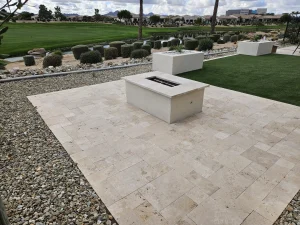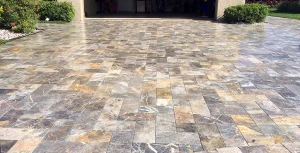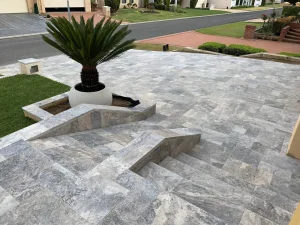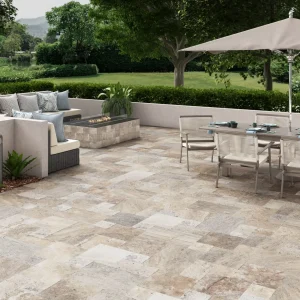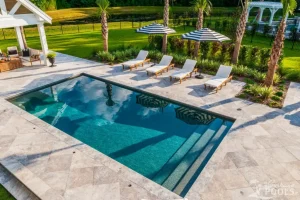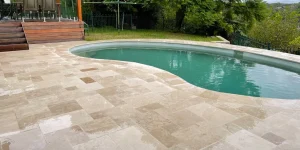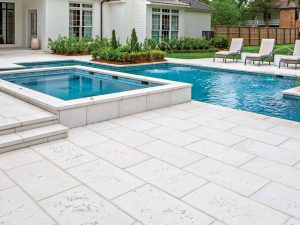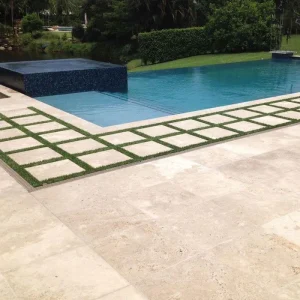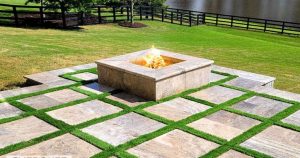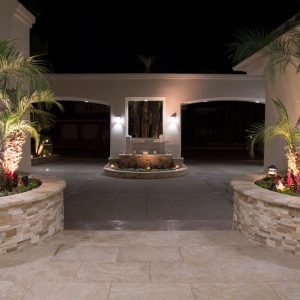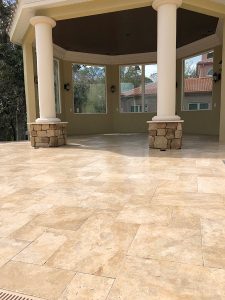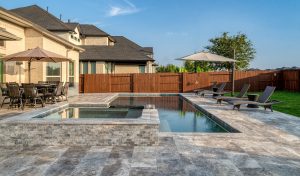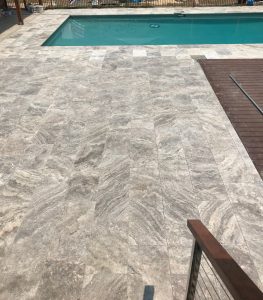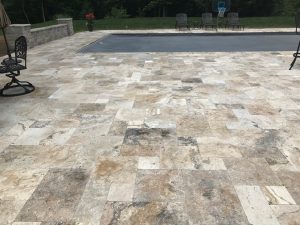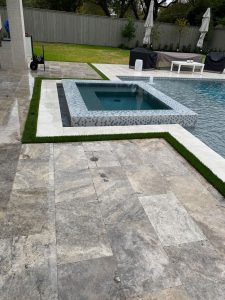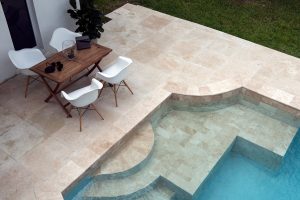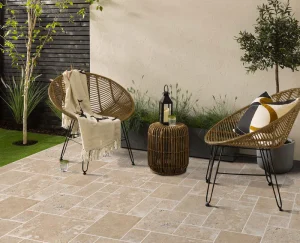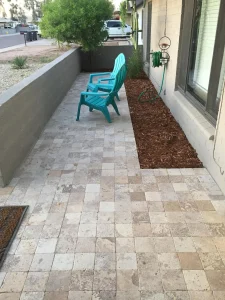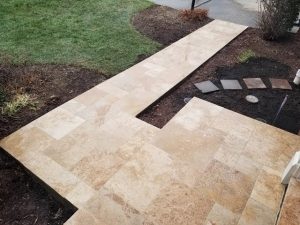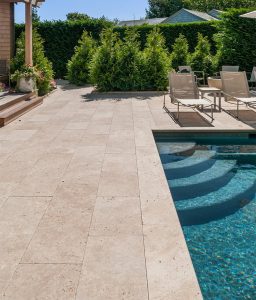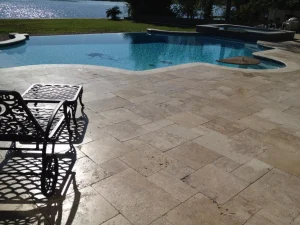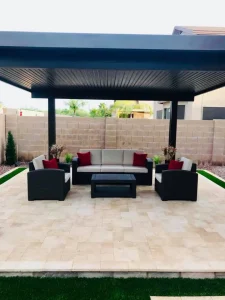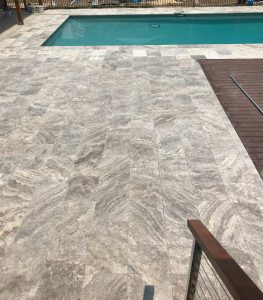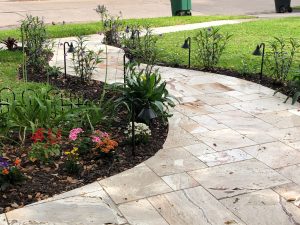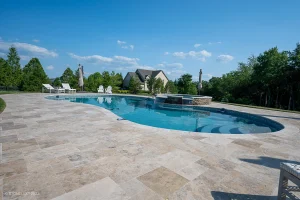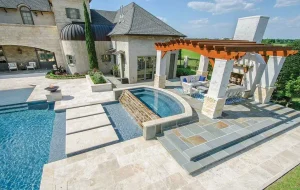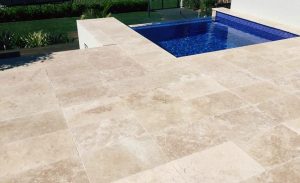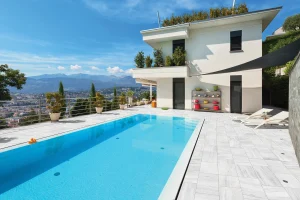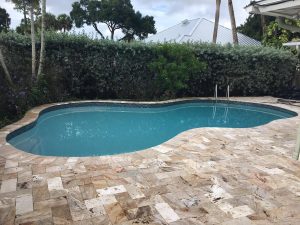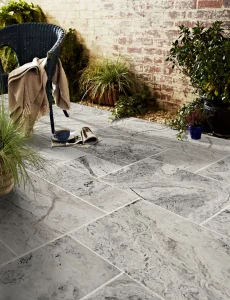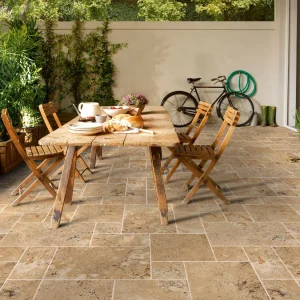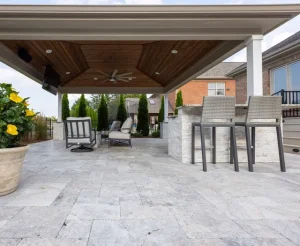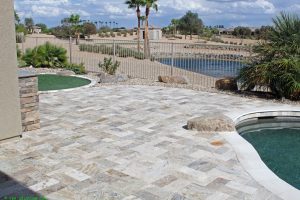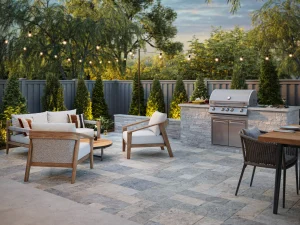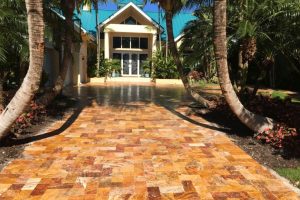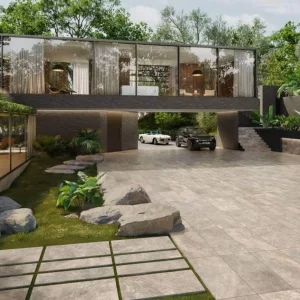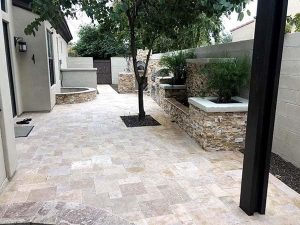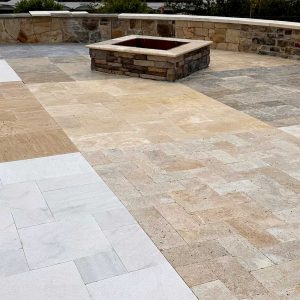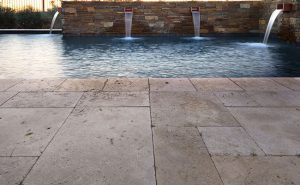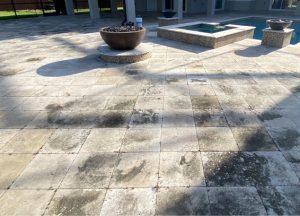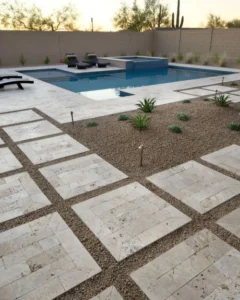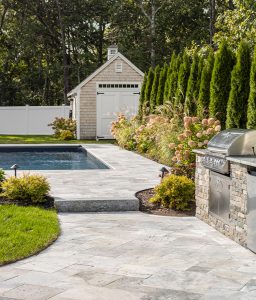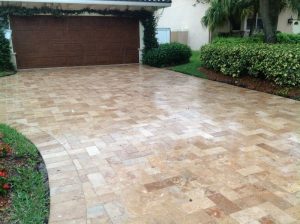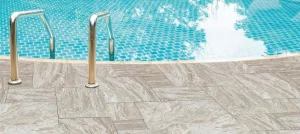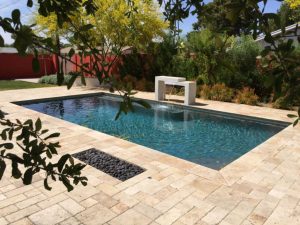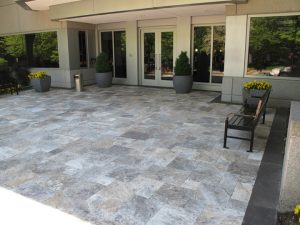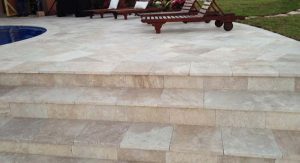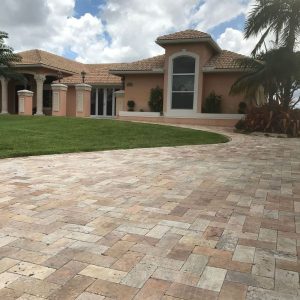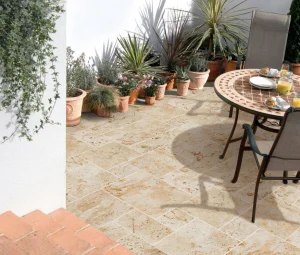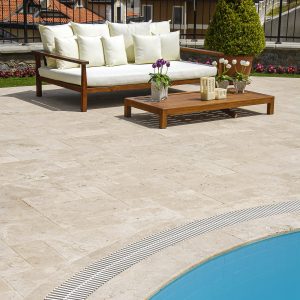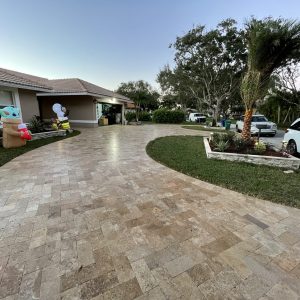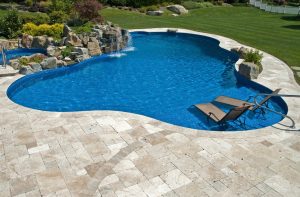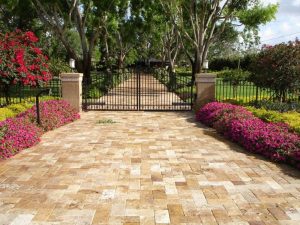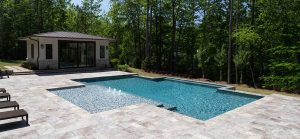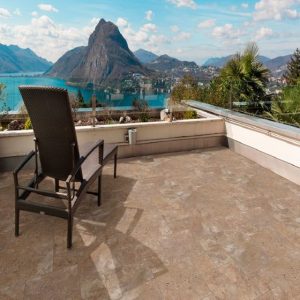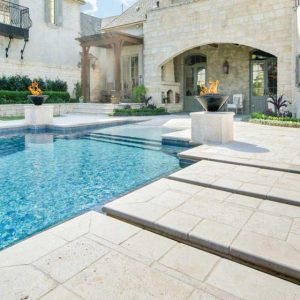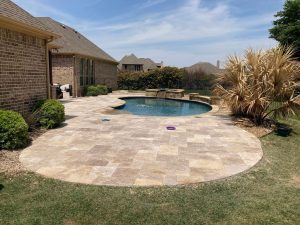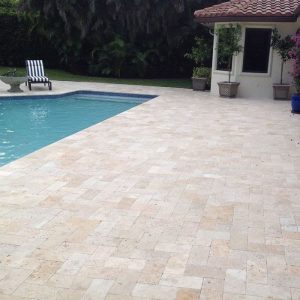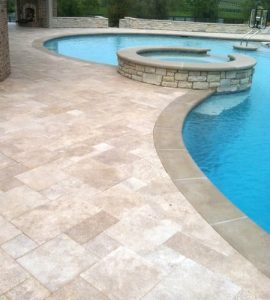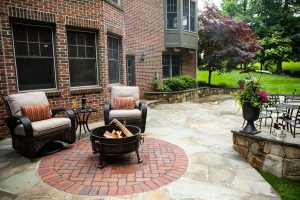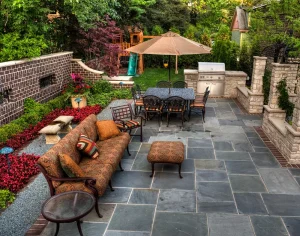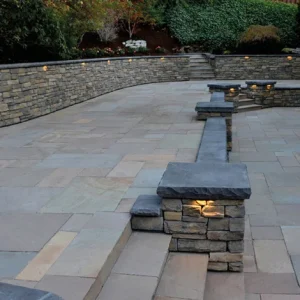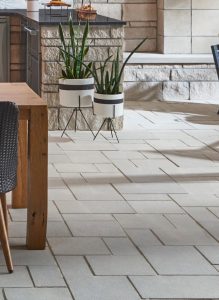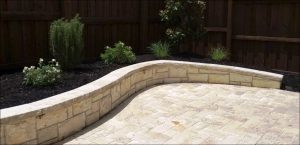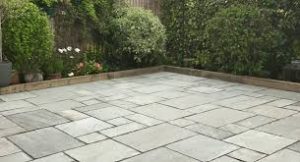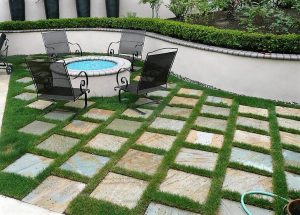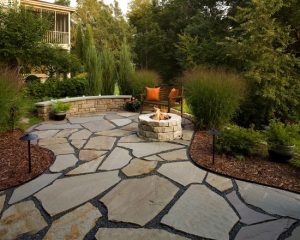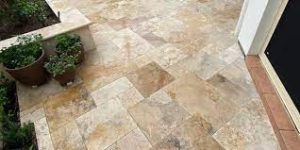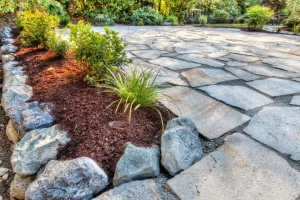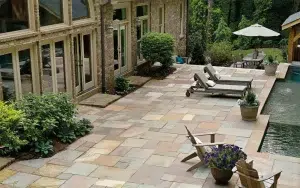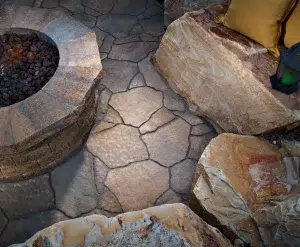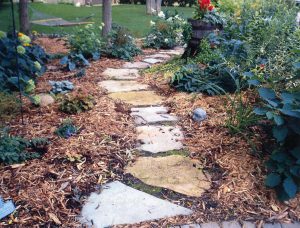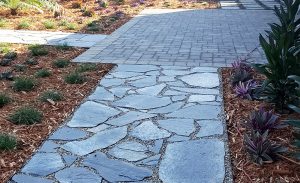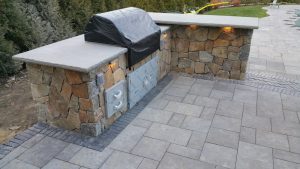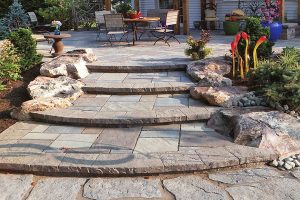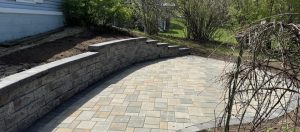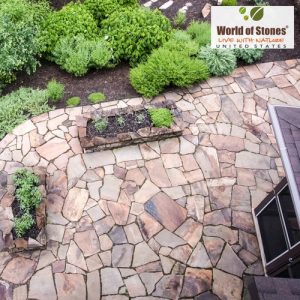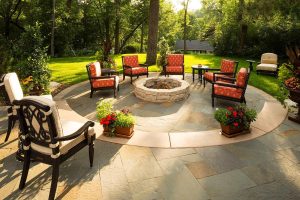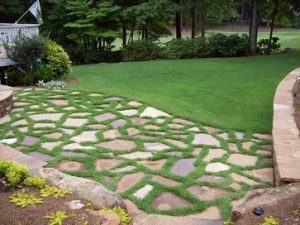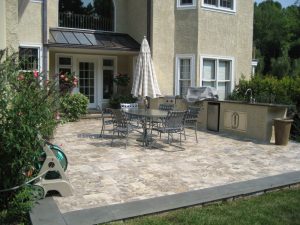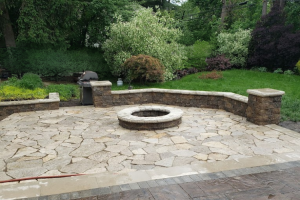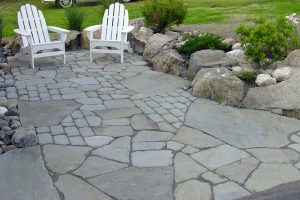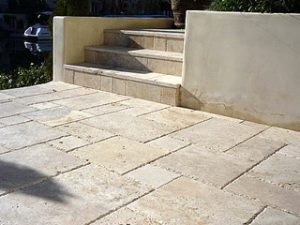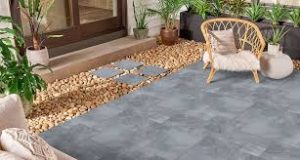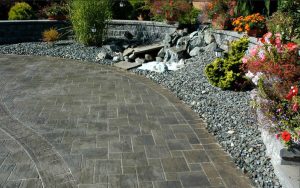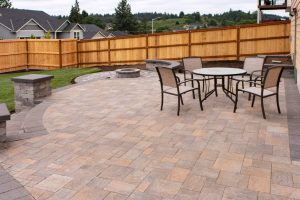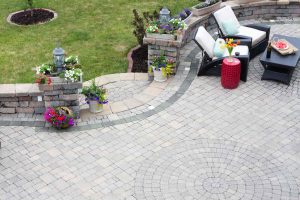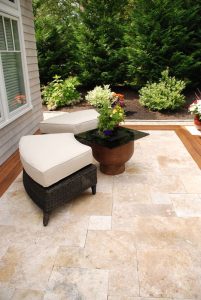What is the best time to install travertine pavers?
When planning an outdoor project, choosing the right time to install travertine pavers can make a big difference in both the installation process and the longevity of your patio, pool deck, or walkway. Weather conditions, temperature, and moisture levels all play key roles in ensuring your pavers settle correctly and maintain their natural beauty for years to come.
1. Spring: The Ideal Season for Installation
Spring is often considered the best time to install travertine pavers. Temperatures are moderate, and the ground is soft enough to work with after winter rains but not overly saturated. This makes it easier to level the base materials and ensure a strong foundation.
Benefits of Spring Installation:
-
Ideal temperature range (60°F–80°F)
-
Moderate humidity allows mortar or sand to set properly
-
You can enjoy your new patio or pool deck all summer long
2. Summer: Great for Fast Setting — With Caution
Summer is another popular time for outdoor projects, but extreme heat can cause materials to dry too quickly, especially in sunny regions like California. If installing during summer, it’s best to work in the early morning or late afternoon and keep the surface slightly damp to prevent cracking or uneven curing.
Tips for Summer Installation:
-
Avoid direct midday heat
-
Keep the pavers shaded or moist during installation
-
Allow for expansion gaps since stones expand slightly in hot weather
3. Fall: A Comfortable Alternative
Fall provides stable weather and cooler temperatures that make installation comfortable and efficient. The ground remains dry enough for compaction, and there’s less rush compared to the busy summer months. It’s also a good time to prepare your outdoor space before the rainy season begins.
Benefits of Fall Installation:
-
Comfortable working temperatures
-
Reduced risk of heat-related issues
-
Allows pavers to settle before winter moisture
4. Winter: Usually Not Recommended
Winter installation is not ideal unless you live in a mild climate. Cold temperatures can interfere with the bonding of materials like mortar or sealers, and frequent rain can disrupt compaction. However, in regions like Sacramento or Northern California, mild winter days can still allow for small installations if weather conditions are dry.
If Installing in Winter:
-
Monitor the forecast to avoid rain or freezing temperatures
-
Use fast-setting materials if necessary
-
Ensure the base is completely dry before placing pavers
Final Thoughts – What is the best time to install travertine pavers?
The best time to install travertine pavers depends largely on your local climate, but spring and fall tend to offer the most favorable conditions. Planning your installation during these seasons ensures optimal curing, better workmanship, and a long-lasting finish.
Whether you’re creating a new patio, pool surround, or garden walkway, timing the project right will help your travertine pavers look their best for years to come.
Can you pressure wash sealed travertine pavers?
Travertine pavers are a popular choice for patios, pools, and outdoor living spaces thanks to their natural beauty and long-lasting durability. But like any outdoor surface, they collect dirt, algae, and debris over time — which leads many homeowners to ask:
Can you pressure wash sealed travertine pavers?
Yes, you can — but only if it’s done correctly.
Because travertine is a porous natural stone, improper pressure washing can damage the surface, wear down the sealer, or even cause pitting. To keep your pavers looking their best, follow these guidelines.
✅ Best Practices for Pressure Washing Sealed Travertine
-
Use low pressure — no more than ~1200 PSI
High pressure can strip the sealer and erode the stone. -
Use a wide spray tip (25° or 40° nozzle)
Avoid pinpoint jets that dig into the stone. -
Keep the wand moving
Don’t hold the spray in one spot. -
Use a gentle cleaner made for natural stone
Avoid acidic cleaners — they can etch travertine. -
Rinse thoroughly
Make sure all soap and residue is removed.
A professional surface cleaner attachment (flat, circular unit) is ideal because it applies even pressure without leaving streaks.
⚠️ What to Avoid
-
No high-pressure concentrated streams
-
No bleach or vinegar
-
No harsh degreasers not labeled for stone
-
Avoid blasting out sand in the joints
-
Avoid pressure-washing right after sealing (allow 24–48 hours cure time minimum)
Using the wrong technique could remove the sealer and make the stone more vulnerable to stains and weathering.
💡 When Should You Re-Seal After Pressure Washing?
If the water no longer beads up on the surface after cleaning, it’s time to re-seal.
Most sealed travertine pavers need resealing every 1–3 years, depending on:
-
Sun exposure
-
Foot and water traffic
-
Type of sealer used
-
Local weather conditions
A good penetrating sealer will help maintain color, reduce stains, and protect against moisture.
✅ Final Answer – Can you pressure wash sealed travertine pavers?
Yes — you can pressure wash sealed travertine pavers safely as long as you:
✔ Keep the pressure low
✔ Use the right nozzle and cleaner
✔ Protect the sealer and stone surface
Done correctly, pressure washing is one of the best ways to keep travertine looking clean, fresh, and beautiful for years.
What is the best material to put between travertine pavers?
If you’re designing a travertine patio, pool deck, or walkway, one of the most important installation choices is what goes between the pavers. Joint filler affects the look of the space, but also the stability, drainage, and long-term durability of your investment.
Below is a simple guide to help you pick the right option.
Why the Joint Material Matters
Travertine pavers look premium, but leaving joints unfilled can lead to:
-
Paver shifting or settling
-
Water pooling and drainage issues
-
Weed and ant problems
-
Dirt filling the gaps and discoloring the stone
So, the joint filler plays a functional and aesthetic role.
Common Options for Filling the Gaps
✅ Polymeric Sand — The Most Recommended
Polymeric sand is a fine sand mixed with binding polymers that harden when activated with water.
Pros
-
Helps keep pavers locked in place
-
Great wash-out resistance (rain & pool splash-zones)
-
Reduced weed and insect growth
-
Long-lasting and low-maintenance
Cons
-
Higher cost than basic sand
-
Must be installed correctly to avoid haze or staining
Best for: Pool decks, patios, driveways — most travertine applications.
Standard Dry Sand — Budget-Friendly but Higher Maintenance
This is traditional paver jointing sand.
Pros
-
Inexpensive
-
Quick and easy to apply
Cons
-
Washes out over time (especially around water)
-
Weeds and ants can become a problem
-
Requires frequent refill and upkeep
Best for: Low-traffic garden walkways or decorative areas.
Mortar / Grout — Smooth, Rigid Finish
Sometimes joints are fully grouted for a seamless tile-like look.
Pros
-
Very sturdy and polished appearance
-
Prevents debris from entering the joints
Cons
-
Can crack if the base shifts
-
Restricts drainage
-
Labor-intensive and more expensive
Best for: Travertine installed over a concrete slab with minimal movement.
Decorative Gravel or Pebbles — A Style Choice
Small stones or pebbles can replace sand for a natural feel.
Pros
-
High drainage
-
Unique design aesthetic
Cons
-
Less stable for walking surfaces
-
More weed growth if not maintained
Best for: Low-use garden pathways.
How to Choose the Right Option
Consider the following when selecting a filler:
| Factor | Best Option |
|---|---|
| Pool-side or wet areas | Polymeric sand |
| High foot-traffic | Polymeric sand |
| On a concrete slab | Mortar or grout |
| Decorative landscaping | Dry sand or pebbles |
| Low maintenance priority | Polymeric sand |
Tips for Using Polymeric Sand With Travertine
-
Make sure pavers are completely dry before filling joints
-
Use a blower to clear extra sand before wetting
-
Lightly mist with water — don’t over-soak
-
Keep traffic off until fully cured (24–48 hrs)
-
Seal the travertine afterward for extra protection
Final Verdict – What is the best material to put between travertine pavers?
For most travertine installations, especially outdoors:
Polymeric sand is the best material to put between travertine pavers.
It strikes the right balance of strength, appearance, and long-term durability — especially in premium outdoor spaces.
What does vinegar do to travertine pavers?
Travertine pavers are known for their natural beauty, durability, and cool-to-the-touch surface — which makes them a popular choice for patios, walkways, and pool decks. But like all natural stone, they have specific care needs. One common mistake homeowners make is cleaning travertine with vinegar.
So what exactly does vinegar do to travertine pavers? Let’s break it down.
Why Vinegar and Travertine Don’t Mix
Vinegar is an acidic cleaner (typically around 2–3 pH), and travertine is a type of limestone, which is a calcium carbonate stone. When acid comes into contact with calcium carbonate, a chemical reaction occurs that breaks down the stone’s surface.
In simple terms: Vinegar eats away at your travertine.
What Damage Can Vinegar Cause?
Using vinegar on travertine pavers can lead to:
✅ Etching
– Dull, rough patches that interrupt the stone’s smooth finish.
✅ Surface Erosion
– Tiny pits or uneven edges start forming as minerals dissolve.
✅ Loss of Shine & Color
– Vibrant stone becomes faded or chalky-looking.
✅ Weakened Sealant
– Sealer breaks down faster, leaving the stone unprotected.
This damage is often permanent and may require professional honing or refinishing to fix.
Why People Think Vinegar Is Safe
Vinegar is commonly recommended for tile cleaning — but that only applies to ceramic or porcelain tile, which aren’t affected by acid. Travertine is a living stone, more porous and reactive than manufactured surfaces.
Just because something works in the kitchen doesn’t mean it belongs on natural stone outdoors.
Safe Alternatives to Vinegar for Travertine
Stick to products designed specifically for natural stone:
✅ pH-neutral stone cleaner
✅ Mild dish soap diluted in water
✅ Soft-bristle brushes or microfiber mops
For deeper cleaning:
-
Pressure washing (gentle setting, professional recommended)
-
Stone-safe stain removers
-
Professional sealing every 1–2 years
What to Do If Vinegar Has Already Been Used
Don’t panic — but take action:
-
Rinse the affected area with plenty of water.
-
Apply a pH-neutral stone cleaner to balance the acid.
-
If dull spots remain, call a stone restoration professional to hone or polish the surface.
The earlier you address damage, the better the results.
Final Thoughts – What does vinegar do to travertine pavers?
Vinegar may be great for everyday cleaning around the home, but when it comes to travertine pavers, it can do more harm than good. If you want to protect your investment and keep your outdoor space looking beautiful, always choose stone-safe, pH-neutral cleaning products.
Can you acid wash travertine pavers?
Travertine pavers are prized for their timeless beauty and natural texture, making them a popular choice for patios, pool decks, and outdoor walkways. Over time, however, they can develop stains, discoloration, or buildup from weather exposure and foot traffic. One question many homeowners ask is: Can you acid wash travertine pavers?
Let’s take a closer look at what acid washing does, whether it’s safe for travertine, and what you should do instead.
Understanding Acid Washing
Acid washing is a cleaning process that uses a diluted acid (commonly muriatic acid) to remove tough stains, mineral deposits, or grime from stone surfaces. It’s often used on concrete to restore its appearance.
While it can be effective for certain materials, acid washing is not recommended for travertine pavers.
Why You Shouldn’t Acid Wash Travertine
Travertine is a type of limestone — a calcium carbonate–based stone. Acid reacts strongly with calcium carbonate, causing it to etch, dissolve, and dull the surface. Even a mild acid solution can eat away at the stone’s polished or honed finish, leaving rough patches, pitting, and permanent damage.
If you acid wash travertine pavers, you might notice:
-
Loss of natural sheen or smoothness
-
White chalky residue
-
Increased porosity (making the stone more prone to stains)
-
Weakening of the surface structure
In short, acid washing can do far more harm than good.
Safe Alternatives for Cleaning Travertine Pavers
Instead of acid washing, you can safely clean your travertine using gentler methods:
1. Mild Soap and Water
Mix a few drops of pH-neutral stone cleaner or dish soap with warm water. Mop or scrub lightly with a soft-bristle brush, then rinse thoroughly.
2. Pressure Washing (with care)
Use a pressure washer on a low to medium setting to remove dirt, algae, and grime. Avoid using too much pressure, which could loosen the stone or grout.
3. Poultice for Stains
For stubborn stains, apply a poultice made from baking soda and water. Let it sit overnight, then rinse and wipe clean.
4. Professional Stone Cleaner
Look for products labeled “safe for natural stone.” These are specifically formulated to lift dirt and stains without damaging the stone.
Maintaining and Protecting Travertine
To keep your travertine pavers looking their best:
-
Seal them regularly (every 2–3 years) to protect against moisture and stains.
-
Sweep and rinse regularly to prevent buildup.
-
Avoid harsh chemicals, vinegar, or acidic cleaners.
Proper maintenance keeps the stone’s color rich and the surface smooth for years.
Final Thoughts
No — you should not acid wash travertine pavers. The acid will damage the stone, strip its finish, and make it more vulnerable to staining. Instead, use pH-neutral cleaners, light pressure washing, and proper sealing to safely restore and maintain your travertine’s natural beauty.
If your pavers are heavily stained or weathered, consider hiring a professional stone restoration specialist who can clean and reseal them without risk of damage.
Does a travertine paver patio add value to a house?
When homeowners think about outdoor upgrades that increase property value, few features make as lasting an impression as a travertine paver patio. Known for its timeless beauty, durability, and natural charm, travertine is more than just a design choice—it’s an investment that enhances both curb appeal and resale potential.
1. Natural Beauty That Boosts Curb Appeal
Travertine pavers offer a classic, elegant look that instantly elevates any outdoor space. Their earthy tones—ranging from creamy beige to rich walnut and silver—complement almost any architectural style.
A well-designed travertine patio creates an inviting environment that appeals to prospective buyers, especially when paired with features like outdoor seating, fire pits, or water features.
2. High-End Look With Lasting Durability
Unlike concrete or basic tile, travertine is a premium natural stone known for withstanding heavy foot traffic, temperature changes, and moisture. Its cool-to-the-touch surface makes it especially desirable in warmer climates.
Buyers often associate travertine with luxury properties, meaning your home can stand out in a competitive real-estate market.
3. Low Maintenance, Long-Term Value
A key selling point for modern homeowners is easy maintenance. Travertine pavers require only occasional cleaning and resealing to preserve their finish. With proper care, they can last for decades—offering excellent long-term ROI compared to wood decks or poured concrete that deteriorate faster.
4. Outdoor Living Is a Selling Feature
The trend toward outdoor entertaining continues to grow, and homes with beautiful, functional outdoor spaces command higher prices.
A travertine patio adds usable square footage for hosting, dining, and relaxation—essentially extending your home’s living space outdoors.
5. Increased Appraisal and Buyer Interest
While the exact value increase depends on factors like region and home size, real-estate experts estimate that well-designed patios can raise resale value by 5–10%.
Because travertine is a luxury upgrade, it can position your home in a higher tier of comparable listings, potentially shortening the time it spends on the market.
6. Environmentally Friendly and Timeless
Travertine is a natural, eco-friendly material. Its soft, neutral colors never go out of style, so your investment won’t look dated years later. Buyers value materials that balance sustainability with elegance.
Final Thoughts – Does a travertine paver patio add value to a house?
Yes—a travertine paver patio absolutely adds value to a house. Beyond financial return, it enhances the lifestyle appeal, beauty, and function of your property.
Whether you’re upgrading for your own enjoyment or preparing to sell, travertine is a smart, long-lasting choice that delivers both aesthetic and economic rewards.
What happens if you don’t seal travertine pavers?
Travertine pavers are prized for their timeless look and natural beauty — but they’re also porous, which means sealing isn’t just a finishing touch; it’s a form of protection. If you skip sealing your travertine pavers, you may start to notice subtle (and sometimes expensive) consequences over time.
1. Stains Become Permanent
Travertine naturally absorbs liquids like water, oil, and wine. Without a sealer, these liquids seep deep into the pores and leave behind dark, hard-to-remove stains. Even small spills can become permanent, especially on pool decks, patios, or driveways where traffic and moisture are constant.
2. Color Fades and Loses Its Natural Luster
Unsealed travertine is more vulnerable to UV rays, rain, and dirt. Over time, these elements dull the stone’s natural vibrancy. What once looked warm and luxurious can fade into a washed-out, chalky tone — especially in sunny or high-traffic outdoor areas.
3. Water Damage and Erosion
Because travertine is porous, water can penetrate deep into the stone. Repeated wet-dry cycles cause internal erosion and weakening, which may lead to surface pitting, cracking, or flaking. Around pools and fountains, this can happen even faster.
4. Mold, Mildew, and Algae Growth
Moisture trapped inside unsealed pavers becomes a breeding ground for mold and mildew. You might notice green or black patches appearing in shaded or damp spots. These aren’t just unattractive — they can also make surfaces slippery and unsafe.
5. Harder to Clean and Maintain
Unsealed travertine tends to hold onto dirt, debris, and grime. Routine cleaning becomes more difficult because stains and dust penetrate the surface instead of wiping away easily. You’ll find yourself scrubbing more often and still not achieving the same results.
Why Sealing Is Worth It – What happens if you don’t seal travertine pavers?
Sealing your travertine pavers forms an invisible barrier that repels water, resists stains, and preserves color. It also makes cleaning faster and prevents long-term damage — ultimately extending the life of your investment.
For most outdoor spaces, it’s best to seal travertine every 2–3 years, depending on traffic and weather exposure.
In short: Leaving travertine pavers unsealed may save time initially, but it leads to higher maintenance costs and a shorter lifespan. Sealing protects your stone — and keeps your outdoor spaces looking stunning for years to come.
How often does travertine pavers need to be resealed?
Travertine pavers bring a timeless, natural beauty to patios, pool decks, and walkways—but to keep them looking their best, sealing is key. Over time, exposure to weather, foot traffic, and moisture can wear down the protective layer, making resealing an essential part of maintenance. So, how often do travertine pavers need to be resealed? Let’s break it down.
General Resealing Timeline
Most experts recommend resealing travertine pavers every 2 to 3 years. However, the right schedule depends on a few factors:
-
Exposure to Sun and Rain: Outdoor areas that get a lot of direct sunlight, rain, or sprinklers may need resealing every 1 to 2 years.
-
Foot and Vehicle Traffic: High-traffic patios, driveways, and pool decks wear down faster and may need more frequent attention.
-
Type of Sealer Used: Premium penetrating sealers can last longer—sometimes up to 5 years—while topical sealers may need reapplication sooner.
Signs It’s Time to Reseal
You can easily tell when your travertine needs a new coat of sealer. Look for:
-
Dull or Faded Appearance: If your pavers have lost their natural sheen or color vibrancy.
-
Water Absorption: Sprinkle some water on the surface. If it soaks in instead of beading up, it’s time to reseal.
-
Staining or Etching: New stains that don’t wipe off easily can signal the sealer has worn away.
Why Resealing Matters
Travertine is a naturally porous stone, which means it absorbs liquids and stains easily if unprotected. Resealing helps:
-
Prevent oil, wine, and rust stains
-
Reduce mold and mildew growth
-
Protect against salt damage and weather erosion
-
Maintain the color and texture of the stone
Regular sealing not only keeps the stone beautiful but also extends its lifespan, saving you money on future repairs or replacements.
Tips for Longer-Lasting Results
-
Always clean thoroughly before resealing to remove dirt and residues.
-
Avoid acidic cleaners (like vinegar) that can damage the sealer and stone.
-
Choose the right sealer type—penetrating sealers for a natural look, or enhancing sealers for a richer color tone.
-
If you live in a high-moisture or freeze-thaw area, consider sealing annually for maximum protection.
Final Thoughts – How often does travertine pavers need to be resealed?
In most cases, resealing travertine pavers every 2–3 years is ideal for keeping them durable, vibrant, and stain-resistant. If you notice fading or water absorption sooner, don’t wait—an early reseal can prevent long-term damage and keep your outdoor spaces looking fresh year-round.
How does travertine pavers hold up outside?
Travertine pavers are one of the most popular choices for outdoor spaces — and for good reason. Their natural beauty, cool touch, and timeless durability make them ideal for patios, pool decks, driveways, and walkways. But how well do they really hold up outdoors over time? Let’s take a closer look.
1. Weather Resistance
Travertine is a natural stone formed by mineral deposits, giving it excellent resistance to harsh outdoor elements.
-
Heat: Travertine stays cool underfoot, even in direct sunlight, making it perfect for pool areas and patios.
-
Cold: It can withstand freezing temperatures when properly sealed and installed, though sealing is important to prevent moisture absorption that could cause cracks during freeze-thaw cycles.
-
Rain: Its natural porosity allows water to drain efficiently, reducing puddles and slip hazards.
2. Durability and Longevity
Travertine is remarkably strong and dense. When installed on a proper base, it can last for decades with minimal upkeep. Many homeowners find that travertine surfaces only look better with time as they develop a soft, aged patina. For driveways and high-traffic areas, thicker pavers (1.25 inches or more) are recommended for maximum stability.
3. Slip Resistance
Travertine’s naturally textured surface provides excellent traction, even when wet. This makes it a safer option compared to smoother materials like porcelain or concrete, particularly around pools or in humid climates.
4. Maintenance and Care
Travertine requires very little maintenance:
-
Sweep or rinse regularly to prevent debris buildup.
-
Reseal every 2–3 years to protect from stains, water absorption, and color fading.
-
Avoid harsh chemical cleaners that can damage the stone’s surface — use pH-neutral cleaners instead.
5. Longevity vs. Cost
While travertine pavers are generally more expensive than concrete, their durability, beauty, and long lifespan make them a worthwhile investment. Over time, they can outlast cheaper materials that might crack, fade, or erode.
6. A Timeless Outdoor Look
Travertine adds instant elegance to any outdoor space with its natural variations in color and pattern. Whether you prefer classic ivory tones, warm golds, or silver and walnut hues, travertine complements virtually any design style — from Mediterranean to modern.
Final Verdict – How does travertine pavers hold up outside?
Travertine pavers hold up exceptionally well outside when installed and maintained correctly. They resist heat, weather, and wear while adding unmatched beauty and sophistication to outdoor areas. If you’re looking for a durable and timeless surface that can stand the test of time — travertine is one of the best choices you can make.
Should travertine pavers be matte or glossy?
When choosing travertine pavers for your patio, pool deck, or walkway, one of the most common design questions is whether they should have a matte (tumbled/honed) or glossy (polished) finish. Both finishes highlight the natural beauty of travertine, but they serve very different purposes depending on where and how the stone is used.
Matte Travertine: The Natural, Non-Slip Look
Matte finishes—often called tumbled or honed—are the most popular choice for outdoor applications.
Here’s why:
-
Slip Resistance: A matte surface has natural traction, making it much safer for pool decks, patios, and other areas exposed to water.
-
Natural Appearance: It enhances the stone’s rustic character, showcasing travertine’s natural texture and color variation.
-
Low Maintenance: Minor scratches or wear are less visible, and cleaning is easier since the finish doesn’t show water spots or dust as easily.
-
Weather Friendly: Matte travertine holds up well under sunlight and temperature changes without becoming overly slippery or reflective.
Best for: Patios, pool decks, driveways, walkways, outdoor kitchens.
Glossy Travertine: The Elegant Indoor Option
A polished or glossy travertine finish gives the stone a refined, mirror-like sheen that adds instant luxury. However, it’s not ideal for exterior use where traction is important.
Key features include:
-
Sophisticated Appearance: Polished travertine reflects light beautifully, creating a sleek and upscale interior aesthetic.
-
Color Enhancement: The gloss deepens and enriches natural hues, especially in cream, gold, and walnut tones.
-
Smooth Surface: Perfect for formal interior areas where you want a luxurious, finished look.
-
Care Needs: Requires more upkeep—fingerprints, smudges, and etching from acidic substances are more noticeable.
Best for: Indoor floors, bathroom walls, backsplashes, fireplace surrounds.
So, Which Should You Choose? – Should travertine pavers be matte or glossy?
If your travertine pavers will be used outdoors, matte is the clear winner—it’s safer, more durable, and better suited for natural exposure.
If your design is indoors and prioritizes elegance over traction, glossy travertine can create a timeless, high-end effect.
For many homeowners, a combination approach works best—matte travertine for outdoor spaces and polished for indoor features. This keeps the aesthetic cohesive while ensuring function and safety.
In short:
Choose matte travertine for outdoor performance, glossy travertine for indoor luxury. Either way, the key is matching the finish to the environment and purpose.
What color goes best with travertine pavers?
Travertine pavers are known for their timeless beauty and natural variation, making them one of the most popular choices for patios, pool decks, and driveways. But when it comes to designing your outdoor space, one of the most common questions homeowners ask is: what color goes best with travertine pavers?
The answer depends on the look you want to achieve, your home’s architecture, and even the surrounding landscape. Let’s explore the best color pairings and design ideas for a seamless and stunning outdoor space.
1. Warm Neutrals for a Natural, Mediterranean Feel
Travertine naturally has warm undertones — think soft beige, tan, cream, and gold. To keep that cohesive, sun-soaked Mediterranean look, pair it with:
-
Cream or off-white stucco walls
-
Terracotta roof tiles
-
Beige or tan outdoor furniture cushions
These shades complement the stone’s warmth and make your space feel bright, inviting, and timeless. Perfect for villas, Tuscan-inspired homes, and pool areas that get plenty of sun.
2. Greys and Charcoals for a Modern Contrast
If your travertine leans toward silver, grey, or ivory tones, a modern contrast can elevate your outdoor design. Try pairing it with:
-
Charcoal planters or furniture frames
-
Black metal accents (railings, light fixtures, or fire pits)
-
Neutral greys on exterior paint
Silver travertine pavers, in particular, look stunning next to black or dark grey accents — the contrast highlights the stone’s soft movement and creates a sophisticated, high-end look.
3. Earthy Greens and Browns for a Natural Oasis
For a more organic, earthy vibe, pull inspiration from nature. Travertine blends beautifully with:
-
Olive green plants or patio furniture
-
Wooden pergolas or brown trim
-
Rustic décor accents like clay pots or stone planters
These natural hues help the pavers blend seamlessly into gardens, backyards, or wooded areas, creating a calm, resort-like escape.
4. Cool Whites and Blues for Poolside Perfection
If you’re using travertine around a pool, lighter color palettes can enhance that refreshing, coastal feel. Ideal pairings include:
-
White walls or fencing to reflect sunlight
-
Soft blue or aqua accessories like cushions, umbrellas, and tiles
-
Light grey or ivory travertine for a clean, cooling surface underfoot
Ivory and light silver travertine pavers reflect heat well, making them practical and beautiful for hot climates.
5. Bold Accents for a Designer Touch
While neutral palettes are timeless, don’t be afraid to introduce a pop of color.
-
Deep navy pairs beautifully with ivory travertine
-
Terracotta red enhances gold and walnut tones
-
Sage green brings out the soft beige undertones
Using bold accents sparingly — through planters, cushions, or lighting — keeps the focus on the natural stone while adding personality to your outdoor design.
Choosing the Right Travertine Color
Travertine comes in a range of shades, including Ivory, Silver, Walnut, Noche, and Gold. Here’s a quick pairing guide:
| Travertine Color | Best Accent Colors |
|---|---|
| Ivory | White, light grey, navy, aqua |
| Silver | Charcoal, black, cool grey |
| Walnut | Cream, beige, olive, bronze |
| Noche | Terracotta, gold, sand, off-white |
| Gold | White, tan, green, rust |
Final Thoughts – What color goes best with travertine pavers?
The best color to pair with travertine pavers depends on your home’s style and the mood you want to create. Whether you lean toward soft neutrals, modern greys, or natural greens, travertine’s versatility ensures it will always look elegant and timeless.
If you’re not sure which shade suits your space best, request samples or visit a local showroom to see how different colors look under natural light.
Does vinegar stain travertine pavers?
Travertine pavers are a timeless choice for patios, driveways, and pool decks thanks to their natural beauty and durability. But when it comes to cleaning them, one common mistake homeowners make is reaching for vinegar — a natural cleaner that’s safe for many surfaces, but not for travertine.
Why Vinegar Damages Travertine
Vinegar is highly acidic, which means it can etch, dull, or even permanently stain travertine. Travertine is a calcium-based stone, and when acid comes into contact with it, it reacts chemically with the surface. This reaction eats away at the finish, leaving dull, cloudy, or discolored spots that can’t be easily wiped off.
Even if you dilute vinegar with water, the acid level is still strong enough to harm the stone. Over time, repeated exposure can cause the surface to lose its natural polish or develop rough, uneven patches.
What Happens When You Use Vinegar on Travertine
Here’s what you might notice if vinegar is used to clean travertine pavers:
-
Etching: The surface becomes dull or chalky in the affected area.
-
Staining: The acid can penetrate the stone and leave light or dark discolorations.
-
Erosion: The protective sealant wears off faster, allowing dirt and water to seep in.
-
Pitting: With long-term damage, small holes or rough textures can appear.
These effects can be permanent unless the surface is professionally refinished or honed.
Safe Alternatives to Vinegar
To keep your travertine looking its best, always use pH-neutral cleaners specifically formulated for natural stone. Look for products labeled “safe for marble or travertine.” You can also make your own gentle cleaning solution using:
-
Warm water
-
A few drops of mild dish soap (without lemon or vinegar additives)
-
A soft mop or microfiber towel
After cleaning, rinse thoroughly with clean water and let the surface dry completely.
How to Prevent Future Stains or Etching
-
Seal your travertine regularly. A high-quality penetrating sealer helps protect against moisture and spills.
-
Avoid acidic products. This includes vinegar, lemon juice, bleach, and ammonia-based cleaners.
-
Blot spills quickly. Don’t let liquids sit — even water can leave marks if left too long.
-
Use mats or rugs. Especially near outdoor kitchens or pool areas where spills are more likely.
Final Thoughts – Does vinegar stain travertine pavers?
Vinegar might be a great eco-friendly cleaner for many surfaces, but when it comes to travertine, it’s a definite no-go. The acid in vinegar will eat away at the stone’s natural finish, leading to costly repairs or refinishing. Stick to gentle, stone-safe cleaners, and your travertine pavers will stay beautiful for years to come.
How do professionals clean travertine pavers?
Travertine pavers bring natural warmth and elegance to outdoor spaces — from patios and pool decks to driveways and walkways. But to keep them looking their best, regular professional cleaning is key. Travertine is a porous, natural stone that requires care beyond a basic rinse. Here’s how professionals clean travertine pavers the right way.
1. Inspection and Preparation
Before any cleaning begins, professionals inspect the area to identify stains, mold, or surface damage. This step helps determine which cleaning method and products are safe to use. They’ll also remove outdoor furniture, sweep off debris, and check for any loose pavers that need resetting before pressure washing.
2. Gentle Pressure Washing
Professionals use low to medium pressure washers — typically under 1200 PSI — to avoid etching or eroding the stone surface. The water pressure loosens dirt, algae, and grime without damaging the travertine’s natural finish. Using the correct nozzle angle and distance is crucial; too close or too strong can permanently scar the stone.
3. pH-Neutral Cleaning Solutions
Unlike concrete or tile, travertine can’t handle acidic cleaners like vinegar, bleach, or muriatic acid. Professionals use pH-neutral or stone-specific detergents that lift oils, organic stains, and mildew safely. These cleaners are applied evenly and left to dwell for several minutes to break down buildup before being rinsed away.
4. Deep Scrubbing and Spot Treatment
For stubborn stains — such as rust, wine, or organic residue — pros apply specialized poultices or stone-safe degreasers. Soft-bristle brushes or rotary floor machines with non-abrasive pads are used to gently scrub the pavers. This ensures deep cleaning without dulling the natural polish or texture of the stone.
5. Rinsing and Drying
After cleaning, the entire area is thoroughly rinsed with clean water to remove any detergent or residue. Proper drainage is checked to prevent standing water, which can lead to mold growth. Once dry, a visual inspection ensures that no cleaning agents remain trapped in the pores of the stone.
6. Sealing for Long-Term Protection
After the surface dries completely, professionals typically apply a penetrating sealer designed for travertine. Sealing helps repel moisture, oil, and stains — extending the life and beauty of your pavers. Most experts recommend resealing every 1–2 years depending on sun exposure, foot traffic, and local climate.
Why Professional Cleaning Matters
While DIY cleaning can help maintain appearance, professional cleaning ensures your travertine pavers stay in top condition. Experts understand how to balance cleaning power with stone safety — preventing costly damage while enhancing the natural color and texture of the surface.
Keep Your Travertine Looking Timeless – How do professionals clean travertine pavers?
Regular professional maintenance protects your investment and keeps your outdoor spaces beautiful year-round. If your travertine pavers have lost their luster, a deep clean and reseal can make them look brand new again.
Are travertine pavers hard to install?
Travertine pavers are one of the most timeless and elegant materials you can use for patios, pool decks, and walkways. They bring a natural warmth and luxurious look that few materials can match. When it comes to installation, many homeowners wonder — are travertine pavers hard to install?
The short answer: not really, but hiring a professional is worth it.
Understanding Travertine Installation
Travertine pavers are typically installed over a compacted base of gravel and sand. The process involves leveling the ground, ensuring proper drainage, setting the pavers tightly together, and filling the joints with sand or polymeric material.
While the concept is simple, precision is key — even a small slope or uneven base can lead to shifting pavers or poor water runoff. Professionals use specialized tools like plate compactors, string lines, and laser levels to ensure long-term stability and a seamless finish.
DIY vs. Professional Installation
If you have experience with hardscaping projects and access to the right equipment, installing travertine yourself can be a rewarding project. However, for most homeowners, professional installation ensures better results and prevents costly mistakes.
A skilled installer will:
-
Create a proper base for drainage and stability.
-
Cut and fit pavers perfectly around curves and edges.
-
Prevent uneven settling and cracking over time.
-
Apply sealers correctly to protect against moisture and stains.
The end result? A flawless, long-lasting outdoor space that looks like it belongs in a high-end resort.
Final Thoughts – Are travertine pavers hard to install?
Travertine pavers aren’t hard to install — they just require precision and experience. If you want a beautiful finish that stands the test of time, hiring a professional installer is the best investment you can make.
How do I permanently get rid of weeds between travertine pavers?
Travertine pavers add timeless beauty to patios, pool decks, and walkways — but nothing spoils the look faster than weeds sprouting through the joints. These stubborn plants can push through tiny gaps, displace sand, and even stain the stone over time. If you’re tired of constantly pulling weeds, here’s how to get rid of them permanently while keeping your travertine looking elegant.
1. Remove Existing Weeds Completely
Start by eliminating any weeds that are already growing between your pavers.
-
Pull by hand – For light growth, remove weeds by hand or use a thin weeding tool to pull them from the roots.
-
Use boiling water or vinegar – Pouring boiling water or a vinegar-based solution over the cracks kills small weeds naturally without chemicals.
-
Apply a targeted herbicide – For deeper roots, use a selective, non-staining herbicide labeled safe for natural stone. Avoid overspray that could discolor your travertine.
2. Refill and Compact the Joints
Once the weeds are gone, focus on what’s underneath. Weeds thrive in loose, unsealed sand.
-
Clean out old joint material with a pressure washer or stiff broom.
-
Refill with polymeric sand, not regular sand — this special sand hardens when wet, creating a semi-solid barrier that prevents new weeds and ants.
-
Compact the joints with a broom or plate compactor, and lightly mist with water to activate the polymeric sand.
3. Apply a Travertine Sealer
Sealing your travertine not only enhances its color but also protects against moisture, dirt, and weed growth.
-
Use a penetrating sealer formulated for natural stone.
-
Apply it evenly over the surface and between the joints using a roller or sprayer.
-
Reseal every 2–3 years for ongoing protection.
4. Maintain Regularly
Even with polymeric sand and sealer, maintenance matters.
-
Sweep debris off the surface weekly to prevent organic matter buildup.
-
Rinse occasionally with mild soap and water to discourage weed seeds from settling.
-
Check joints annually — if sand loosens, top it up before weeds take hold.
5. Optional: Use Landscape Fabric (For New Installations)
If you’re installing travertine pavers from scratch, adding a landscape fabric layer beneath the base material can make a huge difference. It blocks weed roots from reaching the surface while still allowing proper drainage.
Final Thoughts – How do I permanently get rid of weeds between travertine pavers?
Weeds between travertine pavers can seem relentless, but with the right approach — full removal, polymeric sand, sealing, and simple maintenance — you can enjoy a clean, weed-free outdoor space for years to come.
If you’re refreshing your patio or pool deck, explore Marbellezza’s collection of premium travertine pavers, available in tumbled and honed finishes, perfect for both classic and modern designs.
How to tell if travertine is good quality?
Travertine is one of the most timeless and elegant natural stones used for flooring, countertops, pool decks, and outdoor patios. But not all travertine is created equal. The quality can vary significantly depending on its grade, finish, and origin. Knowing how to tell the difference between high-quality and low-quality travertine can help you make a smarter investment and avoid issues like cracking, discoloration, or uneven surfaces later on.
1. Check for Consistent Color and Veining
High-quality travertine has a uniform color tone throughout the tile or slab. While natural variations are expected, the overall hue should be consistent across pieces from the same batch.
-
Poor-quality travertine often shows dramatic color inconsistencies, muddy undertones, or abrupt streaks.
-
Look for balanced veining—good travertine displays soft, natural movement, not chaotic blotches.
2. Inspect the Surface Fillings
Travertine naturally forms with small holes and pores. To create a smooth surface, these voids are filled with resin or cement.
-
Premium travertine will have even, durable, and well-matched fillings that blend seamlessly with the stone.
-
Lower-quality travertine often has poorly matched or crumbling fillers that can fall out over time, leaving pits and weak spots.
3. Feel the Density and Weight
Denser travertine is stronger, more durable, and less porous.
-
Pick up a piece—heavier tiles generally indicate higher density, meaning the stone will absorb less water and resist cracking.
-
Lower-density travertine feels lighter and chalkier, which can lead to structural weakness, especially outdoors.
4. Examine the Edges and Cutting Precision
Precision cutting and smooth edges are a clear sign of professional fabrication.
-
High-quality travertine will have clean, square edges that align well during installation.
-
Cheap or mass-produced tiles often show chipped, uneven, or rough edges, which cause irregular grout lines and poor fits.
5. Check the Finish Quality
Travertine comes in several finishes—polished, honed, tumbled, and brushed.
-
A quality finish should be evenly applied and consistent in sheen across the surface.
-
Inconsistent polishing or dull patches are indicators of rushed processing or poor factory control.
6. Consider the Grade
Travertine is typically categorized into three grades:
-
Premium (First Grade): Uniform color, minimal holes, consistent thickness.
-
Standard (Second Grade): Some variation in color and filling but still structurally sound.
-
Commercial (Third Grade): Significant holes, color inconsistency, and possible structural imperfections.
If you’re installing travertine in a high-traffic or outdoor area, premium or standard grades are worth the investment for long-term durability.
7. Ask About Origin and Sourcing
Travertine is quarried around the world—Italy, Turkey, Mexico, and the U.S. are top producers.
-
Italian and Turkish travertine are often considered superior due to strict quarrying standards and better selection processes.
-
Reliable suppliers will always disclose the origin and grade certification of their stone.
8. Perform a Water Absorption Test
A quick way to test porosity: place a few drops of water on the surface.
-
If it absorbs slowly, it’s dense and high-quality.
-
If it darkens immediately, it’s more porous and likely to stain or deteriorate faster.
Final Thoughts – How to tell if travertine is good quality?
Good quality travertine should feel dense, balanced, and naturally beautiful—not brittle or patchy. Always buy from a trusted supplier who can guarantee grade consistency and proper sealing. When properly sourced and maintained, premium travertine can last for decades, adding timeless elegance to your home or outdoor space.
What is the best way to clean outdoor travertine pavers?
Travertine pavers are one of the most elegant and durable choices for outdoor spaces. Their natural stone texture adds luxury to patios, pool decks, and walkways. However, keeping them clean requires a gentle and proper approach — since travertine is a porous stone that can be damaged by harsh chemicals or abrasive cleaning methods. Here’s how to clean your outdoor travertine pavers the right way.
1. Start with a Gentle Sweep or Rinse
Begin by removing surface debris such as leaves, dirt, and dust. Use a soft-bristle broom or a leaf blower to prevent scratches. Then, rinse the area with a garden hose to loosen any remaining dirt. Avoid using high-pressure water directly on the stone joints, as it can erode the grout or sand between pavers.
2. Use a Mild, pH-Neutral Cleaner
The best cleaning solution for travertine is a pH-neutral stone cleaner mixed with warm water. Avoid acidic cleaners like vinegar, lemon juice, or bleach — they can etch and dull the surface.
-
Mix the cleaner according to the product directions.
-
Apply it evenly across the pavers using a mop or soft brush.
-
Let it sit for a few minutes to break down grime, but don’t let it dry on the surface.
3. Lightly Scrub and Rinse
Use a soft-bristle brush or mop to gently scrub the surface. Focus on stained or heavily soiled areas, but never use wire brushes or anything abrasive.
Once finished, rinse the area thoroughly with clean water to remove all cleaning residue. Allow the pavers to air dry completely.
4. Address Stains Promptly
If you have stains from oil, food, or rust, treat them quickly:
-
Oil stains: Use a poultice or stone-safe degreaser.
-
Rust stains: Try a stone-approved rust remover.
-
Organic stains (leaves, food, etc.): Use hydrogen peroxide mixed with baking soda (for light stains only).
Always test any product on a small, hidden area first.
5. Seal the Pavers Regularly
Sealing travertine every 1–2 years helps protect against stains, mold, and moisture absorption. Choose a penetrating, breathable sealer made specifically for natural stone.
-
Clean the pavers first and allow them to dry.
-
Apply the sealer evenly using a sprayer or roller.
-
Avoid walking on the surface until it’s fully dry.
6. Maintain with Routine Care
Keep your travertine looking great with consistent upkeep:
-
Sweep or rinse weekly to prevent buildup.
-
Reapply sealer as needed.
-
Clean spills right away to avoid staining.
Final Tip – What is the best way to clean outdoor travertine pavers
Travertine is durable but delicate — treat it with care. Avoid power washers, acidic cleaners, and abrasive tools. With regular maintenance and proper products, your outdoor travertine pavers will stay beautiful and long-lasting for years to come.
How to care for outdoor travertine pavers?
Travertine pavers bring timeless beauty and natural character to outdoor spaces — from patios and walkways to pool decks and driveways. But to keep them looking their best, they require a little regular care. With the right maintenance routine, your travertine can last for decades while retaining its classic, luxurious look.
1. Sweep and Rinse Regularly
Outdoor travertine collects dust, leaves, and debris that can dull its surface over time.
-
Sweep or blow debris off the surface once or twice a week.
-
Rinse with a garden hose to remove dirt and prevent buildup in the pores.
Avoid using high-pressure washers directly on the stone, as they can erode the natural texture and dislodge sand from the joints.
2. Clean with a pH-Neutral Stone Cleaner
Travertine is a natural limestone material, which means it’s sensitive to acidic or harsh chemicals.
-
Use pH-neutral cleaners specifically made for natural stone.
-
Avoid vinegar, bleach, or citrus-based products — they can etch or discolor the surface.
-
For deep cleaning, dilute the stone cleaner in water, mop the area, and rinse thoroughly.
3. Reseal Every 1–2 Years
Sealing is essential to protect travertine from stains, moisture, and fading.
-
Apply a penetrating sealer designed for travertine or other porous stones.
-
Outdoor pavers exposed to sun and rain should typically be resealed every 12–24 months, depending on climate and foot traffic.
-
When water stops beading on the surface, it’s time to reseal.
4. Maintain the Joints
The joints between travertine pavers are often filled with polymeric or sand-based material.
-
Check joints for erosion or gaps once or twice a year.
-
Refill with polymeric sand if needed to prevent weed growth and shifting.
-
Ensure proper drainage to avoid standing water between pavers.
5. Remove Stains Promptly
Travertine is naturally porous and can absorb liquids if not sealed properly.
-
Blot spills immediately — especially oils, wine, or acidic drinks.
-
For stains, use a stone poultice or a mild baking soda paste, but test in a small area first.
-
Avoid scrubbing pads or steel wool, which can scratch the surface.
6. Protect High-Traffic and Pool Areas
If your travertine is installed around a pool or a high-traffic patio:
-
Use outdoor mats or area rugs to reduce wear.
-
Rinse off pool chemicals that splash onto the stone — chlorine can cause long-term discoloration.
-
Choose tumbled travertine for slip resistance and a natural grip underfoot.
7. Handle Seasonal Weather
Travertine holds up well in heat, but freezing conditions require extra care.
-
In cold regions, ensure proper drainage beneath the pavers to prevent freeze-thaw damage.
-
Avoid salt-based de-icers — they can corrode the stone. Opt for sand or non-corrosive alternatives instead.
Keep Your Travertine Beautiful for Years
With simple maintenance — regular cleaning, sealing, and mindful care — your outdoor travertine pavers can maintain their rich, natural look for decades. Their durability and elegance make them one of the best choices for patios, pool decks, and pathways, offering both timeless beauty and lasting performance.
Where to not use travertine pavers?
Travertine pavers are a timeless and elegant choice for many outdoor projects — from patios and pool decks to garden walkways. However, like all natural stones, they have their limits. Knowing where not to use travertine can save you from maintenance headaches, damage, and costly replacements down the line.
Here are a few key areas and situations where travertine pavers might not be the best fit:
1. Freezing or Harsh Winter Climates
Travertine is porous, meaning it can absorb water. In areas where freezing temperatures are common, that absorbed moisture can expand when frozen — leading to cracks, chips, and surface erosion.
Tip: If you live in a freeze-thaw region, avoid using travertine outdoors unless it’s sealed properly and installed with excellent drainage.
2. High-Traffic Commercial Areas
Travertine is durable, but not indestructible. In commercial zones like shopping centers, public walkways, or parking lots, heavy foot traffic, carts, or vehicles can cause wear and surface dulling over time.
For these areas, consider porcelain pavers or concrete alternatives that offer greater resistance to abrasion and impact.
3. Driveways or Heavy Load Surfaces
While travertine pavers can support foot traffic and light patio furniture, they’re not ideal for bearing the weight of vehicles. The constant pressure and movement can cause cracking and uneven settling.
Stick to reinforced concrete or thicker natural stones (at least 2.5 inches thick) for driveways and similar applications.
4. Unsealed Indoor Wet Areas
In bathrooms, laundry rooms, or kitchens, travertine can become slippery when wet and is susceptible to staining from soaps, detergents, and acidic products.
If you want a natural look indoors, use honed and sealed travertine tiles instead of outdoor pavers — or choose non-porous alternatives like porcelain.
5. Poorly Drained or Muddy Soil
Travertine performs best when installed on a solid, well-drained base. If laid over soft or water-retaining soil, it can shift, sink, or develop algae and mildew due to constant moisture.
Always use a compacted gravel base and ensure proper water runoff grading before installation.
6. Acidic or Chemical-Exposed Areas
Travertine reacts with acids — including vinegar, citrus, wine, and pool chemicals. For that reason, avoid using it in outdoor kitchen areas, near BBQs, or chemical storage spaces where spills are likely.
Over time, acids can etch and dull the stone’s surface, leaving permanent marks.
7. Shady, Damp Areas Prone to Moss
If your yard has shaded corners that stay damp, travertine can develop slippery moss or mildew buildup.
You can minimize this with regular cleaning and sealing, but if maintenance is a concern, you may want to opt for materials like textured porcelain or slip-resistant concrete.
Final Thoughts – Where to not use travertine pavers?
Travertine pavers are stunning and long-lasting when used in the right environments — sunny patios, pool surrounds, and garden paths. However, avoiding the conditions above will help preserve their natural beauty and prevent structural issues.
When in doubt, consult a stone specialist or your installer to confirm whether travertine is suitable for your specific climate and site conditions.
How long do travertine pavers last?
When choosing materials for your outdoor space, durability is one of the most important factors. Travertine pavers have long been a favorite for patios, pool decks, walkways, and driveways thanks to their timeless beauty and natural strength. But just how long do travertine pavers last? The short answer: decades—if not a lifetime—when properly installed and maintained.
Natural Durability of Travertine
Travertine is a natural stone formed over thousands of years by mineral deposits around hot springs. Its dense structure makes it exceptionally resilient to wear and tear. Unlike manufactured pavers that may fade or crack over time, travertine holds up well against heavy foot traffic, weather changes, and even poolside environments.
With routine care, travertine pavers can last 30 to 100 years or more, often outlasting the home or landscape they’re installed in. In fact, many ancient Roman structures built from travertine are still standing today, showcasing just how durable this stone can be.
Factors That Influence Lifespan
While travertine is naturally long-lasting, several factors determine how well your pavers age:
-
Installation Quality – Proper base preparation, leveling, and sealing can dramatically extend their lifespan. Poor installation may lead to shifting or cracking.
-
Climate – Travertine performs exceptionally well in hot, sunny climates because it stays cool underfoot. In freeze-thaw regions, sealing and drainage become critical to prevent cracking.
-
Maintenance – Simple upkeep such as sweeping, rinsing, and resealing every few years helps protect against stains, erosion, and fading.
-
Usage – Driveway installations endure more pressure than backyard patios, but with the right thickness and base, travertine can handle both.
Low-Maintenance Beauty That Lasts
Travertine doesn’t just last—it ages gracefully. Over time, it develops a natural patina that adds to its charm without losing its strength. Regular sealing keeps colors vibrant and protects against water absorption, while simple cleaning keeps the surface fresh.
Why Travertine is a Long-Term Investment
While travertine pavers may have a higher upfront cost than concrete or brick alternatives, their longevity makes them a cost-effective choice. Instead of replacing faded, cracked, or worn-out pavers every 10–15 years, you can enjoy the same set of travertine pavers for decades with minimal upkeep.
Final Thoughts
So, how long do travertine pavers last? With proper installation and care, you can expect them to endure for generations. Whether used around a pool, in a backyard patio, or as a grand driveway entrance, travertine pavers combine natural beauty with exceptional longevity—making them one of the best investments for your outdoor spaces.
Are travertine pavers good for a backyard?
When it comes to designing an inviting and long-lasting backyard, choosing the right paving material is one of the most important decisions. Homeowners often ask: are travertine pavers good for a backyard? The answer is yes—travertine is one of the best options for outdoor spaces thanks to its timeless look, durability, and functional benefits.
Natural Beauty That Elevates Any Space
Travertine has a warm, earthy elegance that instantly enhances backyard patios, pool decks, and garden walkways. Its unique veining and natural color variations—ranging from ivory and beige to walnut and silver—create a high-end aesthetic that feels both sophisticated and organic. Unlike manufactured pavers, no two pieces are alike, which adds character to your outdoor retreat.
Cool Underfoot in Hot Weather
One of the standout advantages of travertine pavers is that they remain cooler underfoot compared to concrete, brick, or many other natural stones. This makes them especially ideal for pool areas and sun-exposed patios where comfort matters most. Even on hot summer days, your backyard stays usable and inviting.
Slip-Resistant and Durable
Travertine’s naturally textured surface provides excellent slip resistance, making it a safer choice for areas that get wet, such as around pools or outdoor kitchens. Beyond safety, it’s also known for long-lasting strength. With proper installation and minimal upkeep, travertine pavers can withstand heavy foot traffic, weather changes, and years of outdoor use.
Versatile Design Options
Travertine pavers come in a variety of finishes (tumbled, honed, brushed, and chiseled) and sizes, allowing for countless design patterns—from French patterns for a classic European look to sleek rectangular layouts for modern spaces. Whether you’re aiming for a rustic backyard escape or a contemporary entertainment area, travertine adapts beautifully.
Adds Value to Your Home
Because travertine pavers combine beauty with durability, they’re often seen as a premium feature that increases property value. Investing in this timeless stone not only enhances your backyard lifestyle but can also make your home more attractive to future buyers.
Conclusion – Are travertine pavers good for a backyard?
Travertine pavers are more than just a stylish choice—they’re a practical, durable, and comfort-focused solution for backyard spaces. From staying cool under the sun to adding timeless charm, they check all the boxes for homeowners looking to create a functional and beautiful outdoor area.
Transform your backyard with travertine pavers and enjoy a space that’s both elegant and enduring.
What should you not use on travertine pavers?
Travertine pavers bring timeless beauty and natural elegance to patios, pool decks, walkways, and driveways. Their durability and unique texture make them a popular choice for homeowners and designers alike. But while travertine is strong, it’s also a porous natural stone that requires proper care. Using the wrong cleaning methods or products can cause permanent damage.
If you want your travertine pavers to stay beautiful for years to come, here’s what you should never use on them:
1. Acidic Cleaners (Vinegar, Lemon Juice, Citrus-Based Products)
Travertine is a type of limestone, which means it’s highly sensitive to acids. Even mild acidic solutions like vinegar or lemon juice can etch the surface, leaving dull spots, discoloration, or rough patches. This kind of damage is permanent and can only be repaired with professional resurfacing.
2. Harsh Chemicals (Bleach, Ammonia, Muriatic Acid)
Strong chemicals can weaken travertine’s structure, discolor the stone, and strip away any protective sealants. Muriatic acid, sometimes used for concrete cleaning, is especially destructive and can eat away at the stone’s surface.
3. Abrasive Cleaners and Tools
Avoid using scouring powders, steel wool, or stiff wire brushes. These can scratch travertine’s smooth surface and open its pores, making it more vulnerable to stains and moisture. Always use soft cloths, mops, or non-abrasive brushes designed for natural stone.
4. Pressure Washers on High Settings
While light pressure washing can sometimes be safe, setting the washer too high can chip edges, erode the stone, and loosen grout or sand between pavers. If you must pressure wash, keep the setting low and the nozzle at a safe distance.
5. Generic Household Soap and Detergents
Many common cleaning products contain additives, fragrances, or hidden acidic ingredients that aren’t stone-safe. Over time, they can dull travertine’s natural finish or leave behind residues that attract more dirt. Always look for cleaners specifically labeled as safe for natural stone.
How to Clean Travertine Pavers Safely – What should you not use on travertine pavers?
Instead of harsh products, stick to:
-
pH-neutral stone cleaners designed for travertine and other natural stones
-
Warm water and a soft mop or cloth for quick cleanups
-
Stone-safe sealants to protect against stains and weather damage
By using the right cleaning methods, you’ll protect your investment and keep your travertine pavers looking beautiful for years to come.
✅ Key Takeaway: Never use acids, harsh chemicals, abrasives, or high-pressure water on travertine pavers. Stick to gentle, pH-neutral solutions made for natural stone to preserve both beauty and durability.
What do you put in between travertine pavers to lock them in?
Travertine pavers are a timeless choice for patios, walkways, and pool decks. Their natural beauty and durability make them a favorite for homeowners and designers alike. But once the pavers are set, the question often arises. What do you put in between travertine pavers to lock them in and keep them stable?
The answer lies in choosing the right joint material. Let’s break down the best options and what they do for your installation.
1. Polymeric Sand
Polymeric sand ranks among the most popular materials for filling spaces between pavers. Manufacturers mix fine sand with polymer additives, and when you activate it with water, it hardens to form a strong bond.
Benefits:
-
Locks pavers in place, preventing shifting.
-
Minimizes weed growth.
-
Reduces ant infestations.
-
Helps prevent erosion of joints.
Polymeric sand is ideal for outdoor spaces that see heavy use, like driveways, patios, and pool decks.
2. Regular Jointing Sand
Traditional jointing sand is a simpler option. It’s swept into the joints and helps fill gaps, but unlike polymeric sand, it doesn’t harden.
Benefits:
-
More budget-friendly.
-
Easy to install or reapply if it washes away.
-
Works well for areas with lighter traffic.
Keep in mind that jointing sand may require more frequent maintenance
3. Mortar or Grout (for Tighter Installs)
In some cases, especially for formal designs or indoor/outdoor transitions, mortar or grout can be used.
Benefits:
-
Creates a more permanent, seamless finish.
-
Reduces movement and shifting.
-
Provides a polished look.
However, grout or mortar is less flexible than sand. For outdoor areas where pavers expand and contract with temperature changes, it can be prone to cracking.
4. Grass or Decorative Ground Cover
For a more natural or rustic look, some homeowners choose to fill joints with grass, moss, or creeping ground covers.
Benefits:
-
Softens the look of the stone.
-
Adds greenery and texture.
-
Environmentally friendly option.
This approach requires more upkeep, but it can create a unique, organic aesthetic.
Choosing the Right Option – What do you put in between travertine pavers to lock them in?
The best joint filler for your travertine pavers depends on your goals:
-
Durability & low maintenance → Polymeric sand.
-
Budget-friendly, easy fix → Regular jointing sand.
-
Formal, permanent look → Mortar or grout.
-
Natural, rustic charm → Grass or ground cover.
By choosing the right filler, you not only lock your travertine pavers in place but also protect them against weeds, erosion, and shifting—ensuring your outdoor space remains beautiful and functional for years to come.
Does vinegar clean travertine pavers?
Travertine pavers are a timeless choice for patios, pool decks, and walkways thanks to their natural beauty and durability. When it comes to cleaning, however, homeowners often ask: Can I use vinegar on travertine pavers?
The short answer is no—vinegar should never be used to clean travertine.
Why Vinegar Is Harmful to Travertine
Travertine is a type of natural stone composed largely of calcium carbonate. Vinegar, being acidic, reacts with calcium carbonate and causes etching—a chemical burn that leaves dull, discolored, or rough patches on the stone surface. What may start as a simple cleaning attempt can quickly lead to permanent damage that requires costly restoration.
What to Use Instead
Instead of vinegar or other acidic cleaners (like lemon juice, ammonia, or bleach), opt for safer alternatives:
-
Stone-Safe Cleaners: Use pH-neutral cleaners specifically designed for natural stone.
-
Warm Water and Mild Soap: A few drops of a gentle dish soap mixed with water can handle everyday dirt.
-
Pressure Washing (Carefully): Low to medium pressure washing can help with stubborn dirt, as long as the stone is sealed.
Best Practices for Maintaining Travertine Pavers
-
Seal Regularly: Sealing your travertine helps protect against stains and makes cleaning easier.
-
Sweep Often: Regular sweeping prevents dirt and debris from scratching the surface.
-
Blot Spills Immediately: Especially with acidic liquids like wine, juice, or soda, which can etch the stone just like vinegar.
Final Thoughts – Does vinegar clean travertine pavers?
While vinegar is often recommended as an all-natural household cleaner, it is not safe for travertine pavers. The acidic nature of vinegar can permanently damage your stone. To keep your travertine looking its best, stick with pH-neutral cleaners and routine maintenance.
What travertine pavers do not get hot in the sun?
Travertine is one of the most popular natural stone choices for outdoor patios, pool decks, and walkways—and for good reason. Not only is it beautiful and durable, but it also stays cooler underfoot compared to many other paving materials. However, not all travertine pavers react the same way to heat. The color you choose can make a big difference in how hot (or cool) the surface feels in direct sunlight.
Why Color Matters
Just like clothing or roofing materials, darker colors absorb more heat while lighter colors reflect it. This same principle applies to travertine pavers. A dark walnut or espresso travertine will soak up sunlight and feel warmer, whereas a light ivory or beige travertine will stay noticeably cooler.
For areas with heavy sun exposure—such as pool decks or open patios—lighter travertine is the better choice for comfort and usability.
Light-Colored Travertine Pavers That Stay Cooler
Here are a few options that typically remain cooler in the sun:
-
Ivory Travertine – Soft cream and off-white tones make this one of the coolest travertine options underfoot.
-
Light Beige Travertine – Warm but pale shades reflect more sunlight, reducing surface heat.
-
Shell Stone Travertine – A very light, sandy look that naturally deflects heat.
-
Silver Travertine (lighter variations) – Some silver travertine has pale gray and cream tones that stay cooler than darker batches.
Ideal for Pool Decks and Outdoor Living
If you’re planning to install travertine around a pool, lighter colors are almost always recommended. Not only do they resist heat, but they also brighten the outdoor space and give it a more open, elegant look. Plus, cooler pavers reduce the risk of burnt feet on hot summer days—something families and pets will appreciate.
Final Thoughts – What travertine pavers do not get hot in the sun?
Travertine pavers are already one of the most heat-resistant natural stone choices, but if staying cool in the sun is a top priority, go with light-colored options like ivory, beige, or shell stone. They provide all the durability and elegance of travertine while ensuring your outdoor space is comfortable, even in the peak of summer.
Can you use Oxiclean on travertine pavers?
Travertine pavers are a popular choice for patios, pool decks, and walkways thanks to their timeless beauty and natural durability. But like any natural stone, they need proper care to stay in good shape. A common question homeowners ask is: Can I use OxiClean on my travertine pavers to remove stains?
The short answer: No, you should avoid using OxiClean on travertine pavers.
Why OxiClean Isn’t Safe for Travertine
OxiClean is an oxygen-based cleaner that works well on laundry and some household surfaces, but it is not designed for natural stone. Travertine is a calcium carbonate-based stone, which means it’s sensitive to acidic and abrasive products. Using OxiClean or similar cleaners can:
-
Etch the surface – breaking down the stone and leaving dull spots.
-
Weaken the structure – repeated use can slowly damage the stone.
-
Alter the finish – polished or honed travertine can lose its natural sheen.
Safe Alternatives for Cleaning Travertine Pavers
Instead of OxiClean, use products and methods that are stone-safe:
-
Mild soap and water – A neutral pH dish soap mixed with warm water works for routine cleaning.
-
Stone-safe cleaners – Choose a cleaner specifically labeled for natural stone and pavers.
-
Soft brushes – Use a non-abrasive brush to scrub away dirt without scratching.
-
Pressure washing (with care) – On a low setting, it can help clean larger areas without chemicals.
Preventing Stains on Travertine
To minimize deep cleaning in the first place:
-
Seal your pavers regularly (every 1–2 years depending on use).
-
Wipe spills quickly, especially oils, wine, or acidic substances.
-
Sweep and rinse often to prevent dirt and debris buildup.
Final Thoughts – Can you use Oxiclean on travertine pavers?
While OxiClean may seem like a convenient solution, it’s too harsh for natural stone like travertine. Protect your investment by sticking to pH-neutral, stone-safe products, and your pavers will continue to look beautiful for years to come.
If you’re dealing with stubborn stains or need professional sealing, consider reaching out to a stone care specialist to ensure your travertine stays in top condition.
Should you fill travertine paver holes?
Travertine is one of the most popular natural stones for patios, pool decks, and walkways. Its timeless beauty, cool-to-the-touch surface, and unique textures make it a favorite for outdoor spaces. But one question homeowners often ask is: should you fill the natural holes in travertine pavers?
Why Travertine Has Holes
Travertine forms naturally from mineral deposits, which creates its signature porous texture. These small holes and pits give travertine its rustic, earthy look. Some pavers are sold “unfilled” (holes left open), while others come “filled” (holes smoothed with resin or cement).
Pros of Leaving Holes Unfilled
-
Natural Look: Unfilled travertine maintains an authentic, old-world charm.
-
Slip Resistance: The tiny holes create grip, making unfilled travertine less slippery when wet—perfect for pool areas.
-
Breathability: Leaving holes open allows water to drain naturally, reducing the risk of surface damage from trapped moisture.
Cons of Leaving Holes Unfilled
-
Dirt and Debris: The holes can collect dust, leaves, or sand, making maintenance harder.
-
Insects and Weeds: In outdoor settings, small gaps may become spots for ants or tiny weeds to settle.
-
Comfort: Bare feet or patio furniture legs may catch in larger holes, which some homeowners find bothersome.
Benefits of Filling Travertine Holes
-
Smooth Finish: Filling the holes creates a more polished, modern look.
-
Easier Cleaning: With fewer crevices, sweeping and washing become simpler.
-
Durability: Filling helps protect against erosion and reduces the chances of cracks forming from water penetration.
Should You Fill Them?
The choice depends on your design goals and lifestyle needs:
-
If you love a rustic, Mediterranean feel, leave the holes unfilled.
-
If you prefer a sleeker, low-maintenance surface, filling the holes may be the better option.
-
For high-traffic areas (like patios with lots of furniture), filling can prevent damage over time.
Final Recommendation – Should you fill travertine paver holes?
There’s no wrong answer—it comes down to personal preference and function. Many homeowners choose a hybrid approach: filling larger holes while leaving smaller ones natural. No matter your choice, regular sealing is essential to protect travertine from stains, weather, and wear.
Does travertine pavers get hot in the sun?
When choosing outdoor pavers, especially for patios, pool decks, and walkways, one of the most common concerns is whether the surface will become uncomfortably hot under the sun. Travertine pavers are a popular natural stone choice, but how do they perform in warm weather?
Natural Cooling Properties
Travertine is a type of limestone formed by mineral springs, and one of its biggest advantages is its natural ability to stay cooler than many other paving materials. Unlike concrete, brick, or darker stones, travertine has a porous structure that allows it to absorb moisture and release heat more efficiently. This makes it a preferred option around swimming pools, where barefoot comfort is a must.
Color and Finish Matter
While travertine generally stays cooler than many alternatives, the exact temperature can vary based on the color and finish you choose:
-
Light colors (such as ivory, beige, and cream) reflect sunlight better and remain cooler.
-
Darker colors (like walnut or silver) may absorb more heat and feel warmer to the touch.
-
Tumbled and unpolished finishes are also less likely to heat up compared to polished surfaces, which can retain and reflect more heat.
Comparison With Other Materials
-
Concrete pavers: Typically absorb and hold more heat, making them uncomfortable in direct sunlight.
-
Brick pavers: Tend to get hotter than travertine and can be hard to walk on without shoes.
-
Granite or porcelain: These can become much warmer than travertine under the same conditions.
Best Practices for Comfort
If you want to maximize the cooling benefits of travertine pavers:
-
Opt for lighter shades for sun-exposed areas.
-
Use tumbled finishes for both comfort and slip-resistance.
-
Install travertine in areas where it can occasionally get wet (like near a pool) to keep it naturally cool.
Final Answer – Does travertine pavers get hot in the sun?
Yes, travertine pavers can get warm in the sun, but compared to other hardscaping options, they remain noticeably cooler and more comfortable. With the right color and finish, travertine is one of the best natural stone choices for sunny outdoor spaces, especially if you’re looking for a barefoot-friendly surface.
Should I hire a pro to cut my travertine pavers?
When planning a patio, walkway, pool deck, or any outdoor project with travertine pavers, one question almost always comes up: Should I cut the pavers myself or hire a professional? While the DIY route might seem tempting, the truth is that cutting travertine is a job best left to the pros. Here’s why.
Travertine Is Beautiful—But Tricky to Work With
Travertine is a natural stone, meaning no two pavers are exactly alike. Each piece comes with unique veining, textures, and density. Cutting through this material requires more than just a standard saw—it demands specialized equipment like a wet saw with a diamond blade, which many homeowners don’t have on hand. Without the right tools and skill, the stone can easily chip, crack, or break.
Precision Matters in Outdoor Projects
When laying pavers, every cut has to be precise. Even a slight miscut can throw off the alignment of your entire design. Professionals know how to measure accurately, handle edge cuts, and make adjustments that keep your pattern consistent and visually appealing. A small mistake might not seem like a big deal at first—but once the whole patio or walkway is laid out, it becomes very noticeable.
Save Time and Reduce Waste
Cutting stone isn’t just about skill—it’s about efficiency. Professionals work quickly and minimize waste by getting the cut right the first time. If you attempt it yourself, you may end up wasting expensive pavers through trial and error. Hiring a pro ensures the job is done right, on time, and without unnecessary costs.
Safety Considerations
Travertine dust is harmful to breathe in, and cutting stone can send sharp fragments flying. Pros use protective gear, proper ventilation, and safe cutting techniques to reduce risk. Choosing to handle it yourself without the right safety precautions could result in injury or long-term health issues.
The Bottom Line – Should I hire a pro to cut my travertine pavers?
While it may be tempting to DIY your travertine paver cuts to save money, hiring a professional is the smarter move. You’ll also get cleaner cuts, a more polished finish, and peace of mind knowing your investment in natural stone is being handled correctly.
So yes—hire a pro to cut your travertine pavers. It’s worth it for the beauty, durability, and value of your project.
What color is pure travertine?
Travertine is one of the most timeless and elegant natural stones used in architecture and design. Its beauty lies in its soft, earthy tones and unique patterns. But many people wonder—what color is pure travertine?
The Natural Hue of Travertine
In its most natural and unaltered form, travertine is typically a light beige to cream color. This soft neutral tone comes from the stone’s calcium carbonate composition, formed over centuries by mineral-rich hot springs and limestone deposits. Pure travertine has a clean, uniform look, free from heavy veining or dramatic variations.
Why the Color Varies
While pure travertine is light beige, the stone is rarely found in a single shade. The presence of minerals like iron, sulfur, and organic matter during its formation can introduce a range of tones, including:
-
Ivory or White – Subtle, clean tones often used in modern spaces.
-
Silver or Gray – Cooler shades created by mineral content.
-
Gold or Walnut – Warmer tones with hints of yellow, tan, or brown.
These variations are what give travertine its distinctive character and allow designers to match it with different styles.
Finishes and Their Impact on Color
The finish applied to travertine can also influence its appearance:
-
Polished travertine enhances the stone’s color, making it slightly darker and shinier.
-
Honed (matte) travertine keeps the color soft and natural.
-
Tumbled travertine often appears more rustic and muted due to its textured surface.
Conclusion – What color is pure travertine?
Pure travertine is best described as a light beige or creamy neutral, offering a versatile base that blends beautifully with many design styles. However, part of its charm is the range of warm and cool variations created by nature, making every piece of travertine unique.
What not to use on travertine pavers?
Travertine pavers are a timeless choice for patios, pool decks, walkways, and driveways. Their natural beauty and durability make them a favorite among homeowners and designers. However, travertine is a porous natural stone that requires the right care. Using the wrong products can permanently damage the surface, dull the finish, or weaken the stone’s integrity. If you want your investment to last, it’s just as important to know what not to use on travertine as it is to know the right maintenance routine.
1. Harsh Acidic Cleaners
One of the biggest mistakes people make is cleaning travertine with acidic solutions like vinegar, lemon juice, or bleach. These can etch the surface, leaving dull spots and rough patches. Even some “all-purpose” or bathroom cleaners contain acids that will eat away at the stone’s natural finish.
Tip: Always stick to pH-neutral stone cleaners that are specifically designed for natural stone surfaces.
2. Abrasive Scrub Brushes or Pads
Travertine may look tough, but it scratches easily. Avoid using steel wool, wire brushes, or rough scouring pads. These can leave permanent scratches and make the stone more vulnerable to staining.
Tip: Use soft microfiber cloths or non-abrasive brushes for scrubbing.
3. Pressure Washers at High PSI
While pressure washers are commonly used outdoors, blasting travertine with too much force can cause chipping, cracking, or loosening of the pavers. High PSI settings can also erode grout and sealant.
Tip: If you do use a pressure washer, keep it at a low PSI (under 1200) and use a wide spray nozzle.
4. Harsh Chemicals and Solvents
Avoid products like ammonia, bleach, or paint removers. These chemicals not only discolor the stone but can also weaken its structural integrity. Over time, repeated use will cause the stone to lose its natural luster.
Tip: If you need to remove a tough stain, use a poultice or a stone-safe spot treatment recommended for travertine.
5. Salt and Ice-Melt Products
In colder climates, many people use rock salt or chemical ice melts on walkways. Unfortunately, these products can seep into the pores of travertine and cause pitting, flaking, and long-term damage.
Tip: Use sand or a stone-safe alternative for traction in icy conditions instead.
6. Wax or Oil-Based Polishes
It might be tempting to make travertine look shinier with waxes or oil-based products, but these can leave behind residue, attract dirt, and make the surface slippery.
Tip: If you want to enhance the stone’s look, use a penetrating sealer or enhancer made for natural stone.
Final Thoughts
Travertine pavers are a beautiful investment, but like all natural stone, they need the right care. By avoiding harsh cleaners, abrasives, and chemicals, you’ll preserve their beauty for years to come. Always choose products labeled safe for natural stone and when in doubt, test a small, hidden area before applying anything new.
Is travertine pavers ok outside?
Travertine has been a popular building material for thousands of years, admired for its natural beauty, durability, and timeless charm. But when it comes to using travertine pavers outdoors, many homeowners wonder: is it really a good choice for exterior spaces? The short answer is yes—travertine pavers are an excellent option for outdoor applications when installed and maintained properly.
Why Travertine Works Outdoors
-
Durability
Travertine is a natural stone formed through mineral deposits, making it dense and long-lasting. It can handle heavy foot traffic, outdoor furniture, and even vehicles when used in driveways. -
Slip-Resistance
The naturally textured surface of travertine provides excellent traction, especially when left unpolished. This makes it a safer choice for pool decks, patios, and pathways where surfaces may get wet. -
Heat Resistance
Unlike some other materials, travertine stays relatively cool under the sun. This makes it especially comfortable for bare feet around pools and lounging areas in hot climates. -
Timeless Aesthetic
With its warm tones and natural veining, travertine complements both traditional and modern outdoor designs. It blends seamlessly with gardens, water features, and architectural styles.
Considerations for Outdoor Use
-
Weather Resistance: Travertine performs well in warm and moderate climates, but in freeze-thaw regions, proper sealing and installation are crucial to prevent cracking.
-
Sealing: Sealing helps protect against stains, water penetration, and fading from UV rays. Depending on use and exposure, resealing may be needed every 1–3 years.
-
Maintenance: Regular cleaning with mild soap and water keeps travertine looking fresh. Avoid harsh chemicals, which can damage the stone’s surface.
Best Outdoor Applications
-
Pool decks
-
Patios
-
Walkways and garden paths
-
Outdoor kitchens
-
Driveways (with thicker pavers)
Final Thoughts – Is travertine pavers ok outside?
Travertine pavers are more than just “ok” for outdoor use—they’re one of the best choices if you’re looking for a natural stone that combines elegance, functionality, and comfort. With proper sealing and maintenance, travertine can withstand outdoor conditions for decades, offering a luxurious look that never goes out of style.
Should I seal my travertine pavers every year?
Travertine pavers are a timeless choice for outdoor spaces, known for their natural beauty, durability, and ability to stay cool underfoot. But one of the most common questions homeowners ask is: “Should I seal my travertine pavers every year?”
The short answer is: not always—but regular sealing is important if you want to preserve the look and longevity of your pavers. Let’s break it down.
Why Sealing Matters for Travertine Pavers
Travertine is a natural stone with small pores that can absorb water, dirt, and spills. Over time, unsealed pavers may:
-
Stain from oils, food, or plant debris
-
Fade due to sun exposure
-
Accumulate mold, mildew, or efflorescence (white mineral deposits)
-
Lose their natural luster
A high-quality sealer helps protect against these issues by creating a barrier that makes cleaning easier and preserves the stone’s color.
How Often Should You Seal?
Whether or not you need to reseal every year depends on several factors:
1. Exposure to Elements
-
High-traffic or outdoor kitchens/pool areas: May need resealing annually because of heavy use, water, and spills.
-
Low-traffic patios or walkways: Can often go 2–3 years before resealing.
2. Type of Sealer Used
-
Topical sealers (glossy finish): Typically wear out faster and may require annual resealing.
-
Penetrating sealers (matte/natural look): Last longer—often 2–5 years depending on quality.
3. Local Climate
-
Wet, humid, or freeze-thaw regions put more stress on stone and sealer, shortening its lifespan.
-
In drier climates, pavers may last longer between treatments.
Signs Your Pavers Need Resealing
You don’t have to guess—here are some easy ways to tell:
-
Water no longer beads on the surface.
-
The stone looks dull or chalky.
-
Stains are appearing more easily than before.
-
You notice mold or mildew growth.
If you see these signs, it’s time to reseal, even if it hasn’t been a full year.
Tips for Proper Maintenance
-
Clean regularly: Sweep and rinse with mild soap and water to prevent buildup.
-
Spot clean spills: Wipe up oils, wine, or food quickly to avoid stains.
-
Use the right products: Avoid harsh cleaners that can etch or damage travertine.
-
Test first: Pour a small amount of water on the surface. If it soaks in quickly, resealing is due.
Final Verdict – Should I seal my travertine pavers every year?
You don’t necessarily need to seal your travertine pavers every year—but you should inspect them annually. Some high-traffic areas may require yearly sealing, while others can go longer. Investing in a good-quality sealer and staying on top of maintenance will keep your travertine looking beautiful for decades.
What not to use on travertine pavers?
Travertine pavers are a beautiful and durable choice for outdoor patios, walkways, and pool decks. Their natural charm comes from their porous surface and subtle variations in color. However, because travertine is a natural stone, it requires extra care when cleaning and maintaining it. Using the wrong products can damage the stone, discolor the surface, or even shorten the life of your investment.
Below are some things you should never use on travertine pavers:
1. Acidic Cleaners
Products that contain vinegar, lemon juice, or other acids will etch the surface of travertine. Acid reacts with the calcium carbonate in the stone, causing dull spots, rough patches, or permanent stains.
Avoid: Vinegar, citrus-based cleaners, bleach mixtures, or any “lime/rust removers.”
2. Harsh Chemicals and Solvents
Strong chemicals like ammonia or paint strippers can strip away the natural finish and weaken the stone. These products may also penetrate the pores of travertine, causing discoloration that’s nearly impossible to reverse.
Avoid: Ammonia, acetone, or solvent-based degreasers.
3. Abrasive Cleaning Tools
Because travertine is relatively soft compared to granite or quartzite, anything too abrasive can scratch the surface. While scrubbing might seem effective, it leaves behind permanent marks.
Avoid: Steel wool, wire brushes, or rough scouring pads. Stick with soft microfiber cloths, mops, or non-abrasive sponges instead.
4. High-Pressure Washing (Too Close)
Pressure washers are commonly used on outdoor surfaces, but when used too close or at very high PSI, they can erode the stone and widen pores. This makes the surface more vulnerable to stains and water damage.
Avoid: Direct blasting with pressure washers at close range. If needed, use a pressure washer with a wide fan tip at a safe distance.
5. Generic “All-Purpose” Outdoor Cleaners
Many store-bought outdoor cleaners contain harsh chemicals that are not stone-safe. What’s fine for concrete or tile could ruin natural stone. Always check that the product is labeled safe for natural stone.
The Right Approach to Travertine Care
Instead of harsh chemicals, stick to:
-
pH-neutral stone cleaners designed specifically for natural stone.
-
Warm water and mild soap (stone-safe dish soap works).
-
Sealing travertine pavers regularly to protect against stains and weathering.
By avoiding harmful cleaners and tools, you’ll keep your travertine pavers looking elegant for years to come.
✅ Key takeaway: Never use acidic, harsh, or abrasive products on travertine. Stick to gentle, stone-safe cleaning methods and your pavers will maintain their natural beauty.
Can you use Dawn dish soap on travertine pavers?
Travertine pavers are a timeless choice for patios, pool decks, and walkways. Their natural beauty and durability make them stand out—but like any natural stone, they require proper care. A common question homeowners have is whether Dawn dish soap, a popular household cleaner, can be safely used on travertine pavers.
The Short Answer
Yes, you can use Dawn dish soap on travertine pavers—as long as it is used correctly. Dawn is a gentle, pH-neutral soap that won’t etch or damage the surface of your stone the way acidic cleaners (like vinegar, lemon, or bleach) can. However, there are a few best practices to keep in mind.
Why Dawn Dish Soap Works on Travertine
-
pH-Neutral Formula – Travertine is sensitive to acidic and abrasive cleaners. Dawn’s neutral formula makes it safe for occasional cleaning.
-
Effective Degreaser – Outdoor pavers, especially around barbecues or dining areas, can accumulate grease. Dawn cuts through oily residues without damaging stone.
-
Gentle on Sealers – Most travertine pavers are sealed to protect against stains. Unlike harsh chemicals, Dawn won’t strip away your sealer with light use.
How to Clean Travertine Pavers with Dawn
-
Mix a Mild Solution – Combine a few drops of Dawn dish soap with a bucket of warm water. A little goes a long way.
-
Apply with a Soft Mop or Sponge – Avoid stiff brushes or scouring pads, which can scratch the surface.
-
Rinse Thoroughly – Soap residue can leave a film if not rinsed off completely. Use a garden hose with clean water.
-
Dry the Surface – Allow pavers to air-dry, or use a soft towel in smaller areas to prevent water spots.
Things to Avoid
-
Don’t use too much soap – Excess suds can leave streaks and attract dirt.
-
Never mix Dawn with other cleaners – Especially acidic or bleach-based products, as they can react and harm the stone.
-
Avoid pressure washing with soap – High-pressure sprayers can drive detergent deep into the stone or grout lines, causing buildup.
Alternatives to Dish Soap
For deeper cleaning or regular maintenance, consider:
-
Stone-specific cleaners – Formulated to protect natural stone.
-
Warm water rinses – For light dust and dirt.
-
Professional sealing – Resealing your travertine every 1–2 years helps keep it stain-resistant and easier to clean.
Final Thoughts – Can you use Dawn dish soap on travertine pavers?
Dawn dish soap can be a safe and effective option for cleaning travertine pavers, provided it’s diluted and rinsed thoroughly. Think of it as a “spot-cleaning” solution rather than an everyday cleaner. For routine maintenance, stick to stone-safe products and regular rinsing with water to keep your travertine looking beautiful for years to come.
How heavy is a travertine paver?
Travertine pavers are a popular choice for patios, walkways, pool decks, and driveways thanks to their natural beauty, durability, and slip-resistant surface. But if you’re planning a project, one of the most common questions is: how heavy are they? Understanding the weight is important for transportation, installation, and planning the right base material.
Average Weight of Travertine Pavers
The weight of a travertine paver depends on two main factors:
-
Thickness (the most important factor)
-
Paver size (length × width)
Here’s a breakdown:
-
1.25″ thick travertine pavers (common for patios and walkways):
-
Weigh about 15–17 lbs per square foot
-
A standard 6″×12″ paver weighs around 7–9 lbs
-
-
2″ thick travertine pavers (common for driveways and heavy-duty areas):
-
Weigh about 23–25 lbs per square foot
-
A 6″×12″ paver weighs around 11–13 lbs
-
-
French Pattern sets (mixed sizes, usually 1.25″ thick):
-
A full set covering ~8 sq. ft. typically weighs 120–140 lbs
-
Why Weight Matters
-
Transportation: A pallet of 1.25″ travertine pavers (approximately 120–130 sq. ft.) can weigh between 2,000–2,200 lbs. A pallet of 2″ pavers can weigh closer to 3,000 lbs. Make sure your delivery truck or trailer is rated for the load.
-
Installation: Heavier pavers require more effort to handle and may need two people for safe lifting, especially with larger sizes.
-
Base Preparation: The weight of travertine ensures stability, but you’ll want to prepare a solid base of compacted gravel and sand (or mortar for driveways).
Key Takeaways – How heavy is a travertine paver?
-
Travertine pavers typically weigh 15–25 lbs per sq. ft., depending on thickness.
-
A single paver can weigh anywhere from 7 lbs to 25 lbs, depending on size.
-
A full pallet can easily weigh over a ton, so plan for proper transportation and handling.
✅ Pro tip: Always confirm the thickness of your travertine pavers before purchasing, since that alone determines most of the weight difference.
Does sealing travertine pavers change the color?
Travertine pavers are a popular choice for patios, pool decks, and walkways because of their timeless beauty and durability. But many homeowners wonder: if I seal my travertine pavers, will the color change? The short answer is—it depends on the type of sealer you choose.
How Sealing Works
Travertine is a porous natural stone, meaning it has tiny holes and channels that can absorb water, dirt, and other substances. Sealers fill these pores and create a protective barrier. This not only helps prevent staining and weather damage but can also enhance the stone’s appearance.
Types of Sealers and Their Effect on Color
-
Penetrating Sealers (Natural Look)
-
These sealers soak into the stone without leaving a surface layer.
-
They protect against moisture and stains but leave the stone looking almost exactly the same as before.
-
Great for homeowners who want to maintain the original, matte look of travertine.
-
-
Enhancing Sealers (Color-Boosting)
-
These sealers not only protect the stone but also bring out deeper, richer tones.
-
They often give travertine a “wet look,” darkening the stone and highlighting its natural veining.
-
Ideal if you want a more vibrant and dramatic appearance.
-
-
Topical Sealers (Gloss or Satin Finish)
-
These sit on the surface of the paver, creating a sheen—ranging from satin to high gloss.
-
They can slightly darken the stone and add a reflective finish.
-
Typically used in decorative areas where appearance is the top priority.
-
Factors That Affect Color Change
Even with the same sealer, the final look can vary depending on:
-
Stone color: Lighter travertine will show more noticeable darkening than darker varieties.
-
Finish: Honed or tumbled travertine absorbs sealers differently than polished stone.
-
Application method: Applying multiple coats or uneven coverage can intensify or alter the color effect.
Should You Seal Travertine Pavers?
Yes—sealing is recommended for travertine, especially in outdoor areas exposed to weather, pool water, and foot traffic. If you want to maintain the original color, go with a natural penetrating sealer. If you’d like to enhance the look, choose an enhancing or topical option.
Final Thoughts – Does sealing travertine pavers change the color
Sealing travertine pavers doesn’t always change the color—it all depends on the type of sealer you choose. Homeowners looking for long-term protection without altering the stone’s natural look should use a penetrating sealer, while those who want to make the colors pop should go with an enhancing sealer. Either way, sealing ensures your travertine pavers remain beautiful and durable for years to come.
Should you seal travertine pavers before grouting?
Travertine pavers are a favorite choice for patios, pool decks, and walkways because of their natural beauty and durability. But when it comes to installation, one of the most common questions is: Should you seal travertine pavers before grouting?
The short answer: Yes—pre-sealing is highly recommended. Here’s why.
Why Pre-Sealing Is Important
1. Protects Against Stains
Travertine is porous, which means grout can seep into the surface and leave behind permanent stains. Sealing the stone first creates a protective barrier so the grout stays in the joints instead of the stone.
2. Reduces Grout Haze
Grout often leaves a thin film, called grout haze, on the surface of the pavers. Without sealing, that haze can be difficult to remove. Pre-sealing makes cleanup much easier.
3. Preserves the Stone’s Appearance
Whether you prefer a natural matte look or a richer, color-enhanced finish, pre-sealing helps maintain the paver’s beauty during installation and over time.
How to Pre-Seal Travertine Pavers
-
Clean thoroughly – Remove dirt and dust from the surface.
-
Select the right sealer – Use a penetrating sealer made for natural stone.
-
Apply evenly – Use a roller, brush, or sprayer, avoiding puddles.
-
Allow to dry – Let the sealer cure fully (usually 24 hours) before grouting.
-
Seal again afterward – Apply another coat after grouting for long-term protection.
When You Might Skip It
If you’re working in a low-traffic area or using a grout release product, you may decide pre-sealing isn’t necessary. However, for most outdoor projects—especially around pools and patios—pre-sealing offers significant benefits.
Final Takeaway – Should you seal travertine pavers before grouting
Sealing travertine pavers before grouting is one of the best ways to protect your investment. It helps prevent stains, simplifies cleanup, and keeps your stone looking beautiful for years to come.
If you’d like expert guidance on stone care and installation, reach out to us for product recommendations tailored to your project.
Does travertine pavers increase home value?
When homeowners invest in outdoor upgrades, one of the most common questions is: Will this actually boost my home’s value? Travertine pavers, known for their natural beauty and timeless elegance, are more than just a design choice—they can be a smart financial investment too.
Curb Appeal That Sells Homes
First impressions matter, and your outdoor spaces are often the first thing potential buyers see. Travertine pavers provide a high-end look that instantly elevates curb appeal. Whether used for driveways, walkways, or pool decks, their warm tones and natural textures make a property look more refined and well-maintained, which translates into higher perceived value.
Long-Term Durability
Travertine is a natural stone that has been used in architecture for centuries. Its durability means that patios, pool surrounds, or garden paths made with travertine will withstand heavy foot traffic and changing weather conditions. Buyers appreciate low-maintenance, long-lasting upgrades—an important factor that can set your property apart in a competitive market.
Luxury Outdoor Living
Today’s buyers are looking for homes that extend livable space outdoors. A backyard finished with travertine pavers feels like an extension of the interior, creating a luxurious, resort-style atmosphere. This not only enhances lifestyle value for current homeowners but also attracts higher offers from future buyers who envision entertaining or relaxing in a beautifully finished outdoor space.
Return on Investment
Hardscaping projects consistently rank among the top outdoor improvements for return on investment (ROI). Travertine pavers, in particular, are considered a premium material. While costs may be higher than concrete or brick, the payoff often comes in stronger resale value, faster selling times, and greater buyer interest.
Eco-Friendly and Timeless – Does travertine pavers increase home value?
Travertine is a natural, eco-friendly stone that never goes out of style. Unlike trendy finishes that can date a home, travertine has a classic appearance that appeals to a wide range of buyers—making it a safe, long-term investment in your property’s value.
✅ Conclusion: Yes—travertine pavers can increase home value. By improving curb appeal, offering long-term durability, and creating luxury outdoor living spaces, they provide both lifestyle benefits and financial returns. If you’re planning an upgrade, travertine is a material that pays off in more ways than one.
How thick should travertine pavers be?
Travertine pavers are a popular choice for patios, driveways, pool decks, and walkways thanks to their natural beauty, durability, and timeless appeal. But one of the most common questions homeowners and contractors have before starting a project is: how thick should travertine pavers be?
The answer depends on where and how you plan to use them.
Standard Travertine Paver Thicknesses
Travertine pavers typically come in two main thicknesses:
-
1.25 inches (3 cm): The most common thickness for outdoor projects such as patios, pool decks, and walkways. These pavers are strong enough to handle foot traffic and light use while maintaining a sleek, elegant profile.
-
2 inches (5 cm): A heavier-duty option designed for driveways, commercial spaces, or areas that will endure vehicle traffic. The added thickness provides extra strength and load-bearing capacity.
Choosing the Right Thickness for Your Project
-
Patios & Walkways: A 1.25-inch travertine paver is more than enough to handle everyday use. It’s also easier to install and keeps costs down.
-
Pool Decks: Again, 1.25 inches is perfect. Travertine naturally stays cool underfoot and resists slipping, making it ideal for pool areas.
-
Driveways: Always go with 2-inch pavers. Vehicle weight and repeated traffic require the durability that thinner stones can’t reliably provide.
-
Indoor Use: For interior flooring, many people choose travertine tiles (typically 0.5 inches thick) rather than pavers, since there’s no need to withstand outdoor conditions.
Installation Matters Too
The thickness of travertine is important, but so is the installation method. Pavers should always be laid on a properly prepared base of compacted gravel and sand, or set in mortar for added stability. A poor foundation can cause even the thickest stone to crack or shift over time.
Final Thoughts – How thick should travertine pavers be?
For most residential projects, 1.25-inch travertine pavers will be the right choice. If you’re planning a driveway or heavy-use area, opt for 2-inch pavers to ensure long-lasting performance.
By choosing the correct thickness and pairing it with professional installation, your travertine pavers will provide a stunning, durable surface for years to come.
What color goes well with travertine pavers?
Travertine pavers are one of the most versatile natural stone options for outdoor living spaces. With their timeless beauty, natural durability, and unique vein patterns, they instantly add character to patios, pool decks, and walkways. But one question homeowners often ask is: What colors go best with travertine pavers?
Because travertine comes in warm earthy tones—creams, tans, golds, and light beiges—selecting complementary colors for your design can enhance its natural elegance. Here are some ideas to help you pair colors perfectly with travertine pavers.
1. Neutral Pairings for a Classic Look
Neutral colors like white, beige, and gray always work beautifully with travertine.
-
White or off-white trim and walls create a clean, Mediterranean-style aesthetic.
-
Light gray furniture or accent rugs balance the warm undertones of the stone.
-
Taupe or sand-colored paint on exterior walls blends seamlessly with beige travertine for a natural, unified look.
This palette is timeless and works especially well for patios and pool decks.
2. Earth Tones for a Natural Flow
Since travertine itself is a natural stone, earth-inspired colors highlight its organic beauty.
-
Olive green landscaping accents (plants, pots, cushions) bring out the stone’s natural variation.
-
Terracotta or clay tones pair well with travertine’s golden hues, giving your space a Tuscan feel.
-
Chocolate brown wood furniture creates warmth and complements tan and walnut travertine shades.
Earth tones are ideal for creating a relaxing backyard retreat that blends into its surroundings.
3. Bold Accents for Contrast
Travertine’s light and neutral base allows you to add a pop of color without overwhelming the space.
-
Navy blue cushions or umbrellas provide a coastal contrast that feels crisp and modern.
-
Black metal railings or fixtures create striking definition and a touch of sophistication.
-
Deep red or burgundy accents add warmth and pair especially well with cream or gold travertine.
These bold accents work best in moderation, giving your space personality without taking away from the stone’s natural appeal.
4. Soft Pastels for a Calming Atmosphere
If you want a more tranquil, spa-like setting, pastels are the perfect match for travertine.
-
Light blue or aqua accessories enhance the relaxing feel around pools and water features.
-
Soft lavender or blush tones complement travertine’s beige undertones and add a gentle touch of color.
-
Mint green cushions or planters introduce freshness without overwhelming the space.
Pastels pair especially well with ivory or light-beige travertine.
5. Matching Travertine with Other Stones
Travertine also blends nicely with other natural materials.
-
Slate or bluestone accents provide a dramatic contrast against light travertine.
-
Granite countertops or fire pits in darker shades add texture and durability.
-
Porcelain tiles in complementary tones can create mixed-material designs for modern outdoor spaces.
Combining materials adds depth and gives your project a custom, high-end finish.
Final Thoughts
Travertine pavers are a design chameleon—adaptable to many color palettes. Neutrals keep things classic, earth tones make your space feel natural, bold accents create drama, and pastels evoke calm. By thoughtfully choosing your wall colors, furniture, and accents, you can bring out the best in your travertine pavers and design an outdoor space that reflects your style.
What colors do travertine pavers come in?
What colors do travertine pavers come in? Travertine has been used for centuries in some of the world’s most stunning architecture, and today it remains a top choice for patios, pool decks, walkways, and outdoor living spaces. One of the reasons homeowners and designers love travertine pavers is the wide range of natural colors they come in. Unlike manufactured alternatives, no two travertine stones are exactly alike, which means every project has a unique and timeless character.
Classic Travertine Colors
Beige & Ivory
Beige and ivory travertine are the most popular choices. Their light, neutral tones create a clean, elegant look that complements virtually any style of home. They also help keep outdoor surfaces cooler under the sun, making them perfect for pool decks and patios.
Walnut & Brown
Walnut and brown travertine pavers bring warmth and richness to outdoor areas. Their earthy tones pair beautifully with natural landscapes and rustic design styles, offering a timeless Mediterranean feel.
Silver & Grey
Silver travertine has a striking mix of greys, soft whites, and subtle blue undertones. Grey travertine works well in modern and contemporary spaces, giving outdoor areas a sleek, upscale look while remaining versatile enough to match many design palettes.
Gold & Cream
For homeowners looking for a touch of luxury, gold and cream travertine pavers provide soft, radiant hues that brighten outdoor spaces. These tones are especially popular in sunny climates where the natural light enhances their golden glow.
Noce (Dark Brown)
Noce travertine features deep chocolate and espresso shades. It’s an excellent choice for adding contrast or a dramatic focal point, especially when paired with lighter accent stones or landscaping features.
Blends & Mixed Colors
Travertine is often available in multi-color blends, combining beiges, golds, silvers, and browns. These blends create a natural variation across the surface, enhancing the organic feel and reducing the appearance of wear over time.
Why Color Choice Matters
-
Heat Absorption: Lighter colors (like ivory and beige) stay cooler under direct sunlight, ideal for pool decks.
-
Design Flexibility: Neutral tones blend with many home styles, while bold darker shades make a statement.
-
Maintenance: Multi-tone and veined pavers can disguise dirt, wear, and stains more effectively.
Final Thoughts – What colors do travertine pavers come in
Travertine pavers come in a beautiful spectrum of colors ranging from soft ivory and beige to bold walnut and silver. Whether you want a bright, airy patio or a dramatic, modern outdoor living space, there’s a travertine color that fits your vision.
At Marbellezza, we offer a curated selection of travertine pavers in classic and premium shades, available for direct online purchase with nationwide shipping. Browse our collection today and bring timeless natural beauty to your next project.
What is the best base for travertine pavers?
When planning a travertine paver installation, one of the most important steps is creating a strong foundation. The base you choose directly affects the durability, stability, and long-term beauty of your travertine surface. Whether you’re installing them around a pool, on a patio, or in a driveway, understanding the best base for travertine pavers is essential.
Why the Base Matters
Travertine is a natural stone that provides elegance and timeless appeal, but like all pavers, it relies on the surface beneath it for strength. Without a proper base, pavers can shift, crack, or become uneven over time. A well-prepared foundation ensures:
-
Stability – prevents shifting and settling
-
Drainage – reduces water pooling and erosion
-
Longevity – helps the installation last for decades
The Best Base Materials for Travertine Pavers
1. Compacted Gravel Base
The most common and effective base for travertine pavers is a layer of compacted gravel, typically 4–6 inches thick. Crushed stone such as limestone or granite provides excellent drainage while locking tightly in place once compacted.
2. Bedding Sand Layer
On top of the gravel, a thin 1-inch layer of coarse bedding sand helps level the surface and allows pavers to settle evenly. Polymeric sand can also be used later in the joints to lock pavers in place and reduce weed growth.
3. Concrete Slab (Optional in Certain Cases)
For areas with heavy traffic, driveways, or soil that shifts easily, some installers use a reinforced concrete slab as a base. Travertine pavers can then be laid over a sand-set or mortar-set system. While this option adds cost, it offers maximum strength.
Step-by-Step Base Preparation
-
Excavate the area – Remove soil to the required depth (usually 6–8 inches).
-
Install a geotextile fabric (optional) – Helps prevent weeds and soil mixing with gravel.
-
Add gravel base – Spread and compact crushed stone in 2–3 inch layers until reaching the desired depth.
-
Apply bedding sand – Spread a 1-inch layer of sand and screed it level.
-
Lay travertine pavers – Place pavers in your desired pattern.
-
Fill joints with sand – Sweep polymeric or jointing sand into gaps and compact.
Which Base is Best?
-
Patios & Walkways: Gravel + sand base is ideal for most residential uses.
-
Pool Decks: Same as patios, but ensure proper drainage to prevent water damage.
-
Driveways: Gravel + reinforced concrete slab for maximum strength.
Final Thoughts
The best base for travertine pavers depends on where you’re installing them and how much weight they’ll need to support. For most outdoor applications, a properly compacted gravel and sand base is the most reliable and cost-effective choice. Investing the time to prepare a strong foundation ensures your travertine pavers remain level, safe, and beautiful for years to come.
Do travertine pavers get hot in the sun?
Do travertine pavers get hot in the sun? When choosing the right material for outdoor spaces, one common concern is surface temperature—especially during hot summer days. Travertine pavers are a popular choice for patios, pool decks, and walkways, but do they get too hot under the sun? Let’s break it down.
Natural Cooling Properties of Travertine
Travertine is a type of natural stone formed from limestone deposits. One of its standout benefits is its porous structure, which helps it stay cooler than many other hardscaping materials. Unlike concrete or brick, travertine absorbs less heat and releases it more efficiently, meaning it’s often comfortable to walk on even in warmer climates.
Comparing Heat Retention
-
Travertine vs. Concrete: Concrete tends to absorb and hold heat, often becoming uncomfortably hot. Travertine usually feels cooler in comparison.
-
Travertine vs. Brick: Brick surfaces can get extremely hot. Travertine’s lighter color options and natural airflow make it a more barefoot-friendly choice.
-
Travertine vs. Marble/Granite: Dense stones like marble or granite heat up quickly. Travertine, being more porous, generally stays cooler.
Factors That Affect Temperature
While travertine stays cooler than most alternatives, several factors influence surface heat:
-
Color: Light-colored travertine (beige, ivory, white) reflects more sunlight and stays cooler than darker shades.
-
Finish: Tumbled or honed finishes are more slip-resistant and better for barefoot areas like pool decks.
-
Climate: In extremely hot regions, even travertine will warm up, but it typically remains tolerable compared to other stone or concrete options.
Best Use Cases
Travertine pavers are an excellent choice for:
-
Pool decks – Barefoot comfort is a must, and travertine delivers.
-
Patios – Keeps seating areas more comfortable under direct sunlight.
-
Walkways – Provides a natural, elegant look while staying cooler than alternatives.
Final Thoughts – Do travertine pavers get hot in the sun
Yes, travertine pavers will warm up in the sun, but they are widely recognized as one of the coolest natural stone options for outdoor living. If you’re looking for a surface that balances beauty, durability, and comfort, travertine is hard to beat.
How to seal travertine pavers outside?
Travertine pavers are one of the most popular choices for outdoor patios, pool decks, and walkways because of their timeless beauty, natural durability, and slip-resistant texture. However, like all natural stones, they are porous and vulnerable to water absorption, stains, and weather damage if left unprotected. Sealing travertine pavers is the best way to preserve their look and extend their lifespan.
In this guide, we’ll walk through the steps of sealing travertine pavers outside, explain why sealing is important, and share tips to get the best results.
Why Seal Travertine Pavers?
-
Protection from stains – Travertine absorbs liquids easily, which can leave behind dark spots, oil stains, or discoloration.
-
Weather resistance – Sealing helps protect against rain, snow, and freeze-thaw cycles that can cause cracks.
-
Color enhancement – Many sealers bring out the natural hues of travertine, making your patio or walkway look richer and more vibrant.
-
Easier maintenance – Sealed surfaces are smoother and less porous, making cleaning quicker and preventing mold or mildew buildup.
Step-by-Step: How to Seal Travertine Pavers Outside
1. Clean the Surface
Before sealing, make sure your travertine pavers are free of dirt, grime, and stains. Use a pressure washer on a gentle setting or a stone-safe cleaner with a stiff brush. Allow the surface to dry completely—ideally 24 to 48 hours—before applying sealer.
2. Choose the Right Sealer
There are two main types of sealers for travertine:
-
Penetrating sealers – Soak into the pores to provide invisible protection while maintaining the stone’s natural finish. Best for areas where you want a matte, natural look.
-
Enhancing sealers – Protect while also deepening the color and giving a slightly glossy finish. Ideal if you want the stone to “pop” more.
Look for an outdoor-rated, breathable sealer designed specifically for natural stone.
3. Test a Small Area
Always test the sealer on a small, hidden section of the pavers first. This ensures you like the look and confirms the stone reacts well to the product.
4. Apply the Sealer
Use a roller, pump sprayer, or clean paintbrush to apply the sealer evenly across the surface. Work in small sections to avoid streaks and ensure full coverage, paying attention to grout or joint lines.
5. Let It Absorb & Reapply if Needed
Allow the sealer to soak in for the recommended time (usually 15–30 minutes). Wipe away any excess with a clean cloth. For maximum protection, you may need two coats—wait until the first coat is dry before applying the second.
6. Cure & Protect the Area
Avoid foot traffic, water, or placing furniture back on the surface for at least 24 hours. Full curing may take up to 72 hours, depending on the product and weather conditions.
How Often Should You Reseal Travertine Pavers?
On average, outdoor travertine should be resealed every 2–3 years, but this depends on usage and exposure to the elements. To check if it’s time, pour a small amount of water on the surface—if it soaks in quickly rather than beading up, it’s time to reseal.
Final Tips
-
Avoid cheap sealers—they may wear off quickly and need more frequent reapplication.
-
Always follow the manufacturer’s instructions for best results.
-
If your travertine is around a pool, choose a non-slip sealer to keep the surface safe.
Conclusion
Sealing travertine pavers outside is a simple but essential step to protect your investment. With the right preparation, quality sealer, and proper maintenance, your travertine patio, walkway, or pool deck will stay beautiful and durable for years to come.
Can you use polymeric sand on travertine pavers?
When it comes to installing travertine pavers for patios, walkways, or pool decks, one common question homeowners and contractors ask is whether polymeric sand is the right choice for filling joints. While polymeric sand is widely used with concrete pavers, its compatibility with natural stone—especially travertine—needs a closer look.
What Is Polymeric Sand?
Polymeric sand is a blend of fine sand and special additives that harden when exposed to water. Once it cures, it locks pavers in place, minimizes weed growth, and prevents ants from nesting between joints. It’s designed to create a firm, long-lasting joint.
Challenges with Travertine Pavers
Unlike manufactured concrete pavers, travertine is a porous natural stone. This porosity can create issues:
-
Staining Risk: The polymers and colorants in the sand can seep into the stone’s surface, leaving permanent stains or a “haze.”
-
Uneven Joints: Travertine pavers often have slightly irregular edges, making it harder for polymeric sand to bond and cure evenly.
-
Moisture Trapping: Improper application can trap water under the stone, which may cause erosion, efflorescence, or even cracking over time.
Is It Safe to Use Polymeric Sand on Travertine?
It can be used—but only with extra precautions. Contractors often recommend sealing the travertine before applying polymeric sand to protect the stone’s pores from absorbing the polymer dust. Even then, it requires very careful sweeping and compacting to avoid residue sticking to the surface.
Many professionals prefer alternative joint fillers, such as:
-
Silica or natural jointing sand – Less risk of staining.
-
Stone dust or crushed stone – Blends naturally with the paver material.
-
Specialized non-polymeric joint compounds – Designed specifically for natural stone.
Best Practices if You Choose Polymeric Sand
If you decide to go with polymeric sand, follow these steps for the best results:
-
Seal the Travertine First – Apply a quality penetrating sealer to reduce absorption.
-
Work in Small Sections – Sweep and compact the sand carefully before misting with water.
-
Clean Excess Immediately – Use a leaf blower or broom to remove all dust before activating with water.
-
Follow Manufacturer’s Instructions – Each brand may have slightly different curing times and water requirements.
Final Thoughts – Can you use polymeric sand on travertine pavers?
Polymeric sand can technically be used with travertine pavers, but it comes with risks that may outweigh the benefits. If you value the natural look of your travertine and want to avoid potential staining, traditional joint sand or stone dust may be the safer choice. For the best outcome, consult with a stone professional who has experience specifically with natural stone paver installations.
Are travertine pavers waterproof?
Travertine pavers have become one of the most popular choices for outdoor spaces, from patios and pool decks to walkways and garden areas. Their natural beauty, durability, and ability to stay cool underfoot make them a favorite among homeowners and contractors alike. But if you’re considering them for your project, you might be wondering: are travertine pavers waterproof?
The Truth About Travertine and Water
Travertine is a type of natural limestone formed by mineral deposits, which means it has a naturally porous structure. Because of these pores and small holes, travertine is not fully waterproof by itself. Water can seep into the surface if the stone is left untreated. However, this doesn’t mean travertine is a poor choice for wet areas—quite the opposite.
When properly sealed, travertine pavers become highly water-resistant. A quality sealant penetrates the stone, filling its pores and creating a protective barrier that prevents water absorption, staining, and damage from freeze-thaw cycles.
Why Travertine Works Well Outdoors
Even though it’s naturally porous, travertine is an excellent option for outdoor projects where water exposure is common, such as:
-
Pool decks – Travertine’s slip-resistant texture makes it safer when wet compared to ceramic tile or polished stone.
-
Patios – Properly sealed travertine resists rainwater and can withstand exposure to sprinklers or garden hoses.
-
Driveways and walkways – Travertine can handle weather changes without cracking as long as it’s installed with the right base and sealed.
Sealing Travertine for Water Resistance
To maximize water resistance, sealing is essential. Here’s what you should know:
-
Use a penetrating sealer – This type soaks into the stone instead of just coating the surface.
-
Re-seal regularly – Depending on foot traffic and exposure, travertine may need to be resealed every 1–3 years.
-
Check water absorption – You can test your pavers by sprinkling water on them. If the water beads up, the seal is still strong; if it soaks in, it’s time to reseal.
Are Travertine Pavers Right for You?
If you’re looking for a natural stone that holds up beautifully in wet environments, travertine is an excellent choice. While it isn’t naturally waterproof, sealing transforms it into a water-resistant, durable surface perfect for outdoor use. With proper care and maintenance, travertine pavers can last for decades while maintaining their timeless appeal.
What are travertine pavers?
When it comes to outdoor design, travertine pavers are one of the most popular choices for patios, pool decks, walkways, and driveways. Their natural beauty, durability, and timeless appeal make them a go-to material for homeowners and contractors alike. But what exactly are travertine pavers, and why are they such a great choice for outdoor projects? Let’s break it down.
Understanding Travertine
Travertine is a natural stone formed from mineral deposits, primarily calcium carbonate, found near hot springs and limestone caves. Over centuries, water movement creates layers and tiny holes within the stone, giving travertine its signature textured look. This natural process results in unique patterns and colors ranging from soft ivory and beige to rich golds, silvers, and even darker walnut tones.
What Are Travertine Pavers?
Travertine pavers are cut and shaped pieces of travertine stone specifically designed for outdoor use. Unlike tiles, which are thinner and used indoors, pavers are thicker and stronger, making them ideal for exterior surfaces that need to withstand foot traffic, vehicles, and outdoor elements.
They come in a variety of finishes:
-
Tumbled – For a rustic, aged look with softened edges.
-
Honed & Filled – Smooth surface with natural holes filled, great for a more refined appearance.
-
Brushed – Slightly textured surface for slip resistance.
Benefits of Travertine Pavers
1. Natural Beauty
Each paver has unique veining and color variation, ensuring no two are ever the same. This gives your outdoor space a high-end, luxurious feel.
2. Durability
Travertine is extremely strong and long-lasting, holding up against heavy use and outdoor weather conditions.
3. Heat Resistance
One of the standout features of travertine pavers is that they stay cool underfoot, even in hot weather—perfect for pool decks and patios.
4. Slip Resistance
With naturally porous and textured surfaces, travertine provides traction, reducing the risk of slipping when wet.
5. Eco-Friendly
As a natural stone, travertine is a sustainable choice with minimal environmental processing compared to synthetic alternatives.
Common Uses for Travertine Pavers
-
Pool Decks – Stay cool and safe around water.
-
Patios – Create a timeless outdoor living space.
-
Walkways – Add elegance and durability to garden paths.
-
Driveways – Withstand vehicle traffic while looking stylish.
Why Choose Travertine Pavers?
Travertine pavers are not just functional; they elevate the aesthetic of any outdoor space. Whether you want a modern, elegant design or a rustic, Mediterranean-inspired look, travertine adapts beautifully. Their long-lasting durability and natural charm make them an investment that pays off in both style and value.
Final Thoughts – What are travertine pavers?
If you’re planning an outdoor remodel, travertine pavers are a top choice for homeowners who want a mix of beauty, durability, and practicality. From pool decks to patios, these natural stone pavers provide unmatched elegance and performance.
What damages travertine pavers?
What damages travertine pavers? Travertine pavers are a timeless choice for patios, driveways, pool decks, and walkways. Their natural beauty, durability, and cool-to-the-touch surface make them a favorite for outdoor spaces. However, like any natural stone, travertine is not indestructible. Understanding what can damage travertine pavers is key to keeping them looking great for years to come.
1. Harsh Weather Conditions
Although travertine is naturally durable, extreme weather can take a toll over time.
-
Freezing and thawing cycles can cause cracks if water seeps into the stone.
-
Intense heat can fade unsealed pavers, especially in areas with prolonged sun exposure.
-
Heavy rain can erode grout lines or wash away joint sand if not properly maintained.
2. Acidic Substances
Travertine is a form of limestone, which means it is highly sensitive to acidic materials.
-
Spills from citrus juices, vinegar, wine, or soda can etch the surface.
-
Fertilizers or acidic cleaners can also cause pitting and dull spots.
Always use pH-neutral cleaners designed for natural stone to avoid long-term damage.
3. Heavy Impact and Abrasion
Even though travertine is strong, it can chip or crack under excessive force.
-
Dropping heavy furniture, grills, or planters can leave permanent marks.
-
Metal patio furniture can scratch the surface if dragged instead of lifted.
Using protective pads and being mindful of weight distribution will help extend their life.
4. Improper Cleaning Methods
Travertine requires specific care to preserve its natural finish.
-
Pressure washers set too high can erode the surface and open pores.
-
Harsh chemicals like bleach, ammonia, or acidic cleaners break down the stone.
-
Abrasive scrub brushes can scratch polished or honed surfaces.
5. Lack of Sealing and Maintenance
Sealing is one of the most important steps in protecting travertine pavers.
-
Unsealed stone absorbs water, dirt, and stains quickly.
-
Algae, mold, and mildew thrive in damp areas like pool decks if sealing is neglected.
-
Without resealing every few years, travertine loses its natural luster and becomes more vulnerable to staining.
6. Salt and De-icing Products
If travertine is installed in colder climates, salt and de-icing chemicals can cause serious deterioration. The stone absorbs the chemicals, leading to flaking, crumbling, and discoloration. Instead, use sand or stone-safe alternatives during winter months.
7. Plant and Root Growth
When pavers are installed near trees or in gardens, root systems can shift or lift them over time. Moss and weeds growing between joints can also trap moisture against the stone, causing discoloration. Regular joint maintenance helps prevent this issue.
Protecting Your Travertine Investment – What damages travertine pavers?
With proper care, travertine pavers can last decades while maintaining their natural charm. Seal them regularly, clean with pH-neutral products, avoid harsh chemicals, and protect against heavy impacts. A little routine maintenance goes a long way toward preventing damage and ensuring your outdoor space stays beautiful year after year.
Are travertine pavers good for outdoors?
When it comes to choosing the right material for patios, pool decks, walkways, or driveways, homeowners and designers often ask: are travertine pavers good for outdoors? The short answer is yes—travertine is one of the most popular natural stone options for exterior projects. Its durability, timeless beauty, and natural slip resistance make it a standout choice. Let’s dive deeper into why travertine pavers are an excellent option for outdoor spaces.
1. Durability and Longevity
Travertine is a natural stone that forms over thousands of years, making it dense and strong. When properly installed and sealed, travertine pavers can last decades while withstanding weather changes, foot traffic, and even the occasional vehicle on driveways. Unlike concrete pavers that may crack over time, travertine maintains its strength and integrity.
2. Naturally Slip-Resistant
One of travertine’s biggest advantages outdoors is its textured, porous surface. Even when wet, travertine provides a natural grip, making it a safer choice for pool decks, patios, and walkways. This slip-resistant quality is especially important in areas where water exposure is common.
3. Stays Cool Underfoot
Unlike many materials that absorb heat, travertine reflects sunlight and stays relatively cool, even on hot summer days. This feature makes it an ideal material for pool decks and outdoor lounging areas where comfort is key.
4. Timeless Aesthetic Appeal
Travertine pavers come in a variety of earthy tones, including beige, walnut, ivory, and silver, with natural variations that add character to any outdoor space. Whether you’re aiming for a rustic Mediterranean look or a modern, elegant design, travertine blends seamlessly with outdoor landscapes.
5. Easy Maintenance
Maintaining travertine outdoors is relatively simple. Regular sweeping and occasional rinsing keep it looking fresh. Applying a high-quality sealer helps protect against stains, weathering, and enhances the stone’s natural color. With minimal upkeep, travertine continues to look beautiful year after year.
6. Eco-Friendly Choice
Travertine is a natural stone that requires minimal processing compared to synthetic materials, making it an environmentally friendly choice for homeowners who want sustainable building options.
Things to Keep in Mind
While travertine is excellent for outdoors, there are a few considerations:
-
Sealing is recommended to protect against stains and weathering.
-
Freeze-thaw climates can cause issues if water seeps into the stone and freezes, so proper installation with drainage is crucial in colder regions.
-
Professional installation is highly recommended to ensure longevity and prevent shifting or cracking.
Final Verdict – Are travertine pavers good for outdoors?
Travertine pavers are not only good for outdoors—they are one of the best natural stone choices for exterior projects. With their durability, natural slip resistance, cool surface, and timeless beauty, travertine pavers add both function and elegance to patios, pool decks, driveways, and walkways.
If you’re planning an outdoor remodel, investing in travertine pavers can elevate your space while adding long-term value to your home.
Can you power wash outdoor travertine pavers?
Can you power wash outdoor travertine pavers? Travertine pavers are a popular choice for patios, pool decks, and outdoor walkways because of their natural beauty and durability. But like any outdoor surface, they collect dirt, debris, and stains over time. If you’re wondering whether it’s safe to power wash travertine pavers, the short answer is yes—but with caution. Using the wrong technique can damage the stone and shorten its lifespan.
The Risks of Power Washing Travertine
Travertine is a type of natural stone with a porous surface. While it’s strong, it’s also more delicate compared to concrete or brick. High-pressure water can:
-
Etch or scratch the surface of the stone
-
Loosen grout or joint sand between the pavers
-
Force water deep into pores, causing long-term damage
That’s why using the right settings and methods is essential when cleaning with a power washer.
Best Practices for Power Washing Travertine Pavers
If you decide to power wash your travertine, follow these safe practices:
-
Use Low Pressure
Keep the PSI under 1200 to avoid damaging the stone. A wide-angle nozzle (25–40 degrees) will help distribute pressure evenly. -
Test a Small Area First
Always start in a hidden corner to make sure the pressure doesn’t harm the stone. -
Keep the Nozzle Moving
Avoid holding the wand too close or in one spot for long. Keep a distance of at least 12–16 inches from the surface. -
Pre-Treat Stains
Use a pH-neutral stone cleaner for stubborn stains instead of blasting them with high pressure. -
Seal After Cleaning
Once your pavers are clean and dry, apply a penetrating sealer. This protects the porous surface from water, dirt, and future stains.
Alternatives to Power Washing
If you’re worried about damaging your travertine, consider safer cleaning methods:
-
Garden Hose with a Spray Nozzle – Gentle but effective for routine cleaning.
-
Soft Bristle Brush & Cleaner – Perfect for spot cleaning and algae removal.
-
Professional Stone Cleaning Services – Ideal if your pavers are heavily stained or you want expert care.
Final Thoughts – Can you power wash outdoor travertine pavers?
You can power wash outdoor travertine pavers, but only if you do it correctly. The key is using low pressure, proper technique, and sealing afterward to protect your investment. If you’re unsure, hiring a professional cleaning service that specializes in natural stone is the best way to keep your pavers looking beautiful for years to come.
What to fill holes in travertine pavers with?
What to fill holes in travertine pavers with? Travertine pavers are a beautiful choice for patios, pool decks, and walkways. Over time, though, small holes and pits can appear on the surface. This is natural for travertine since it’s a porous stone, but leaving these holes unfilled can make your pavers look uneven, collect dirt, or even cause damage. The good news is that there are several effective options for filling holes in travertine pavers, depending on your needs.
1. Travertine-Specific Filler or Putty
The most popular option is to use a travertine filler or putty. These are designed to match the stone’s color and texture, making repairs almost invisible. They come in pre-mixed or powder form and can be applied with a putty knife. This method works best for small to medium-sized holes and provides a smooth finish that blends with the stone.
2. Epoxy Resin
For deeper or larger holes, an epoxy resin is a strong and durable choice. Clear or tinted epoxy can be used, depending on whether you want the fill to blend in or stand out as part of the stone’s natural variation. Epoxy creates a long-lasting repair and resists moisture, making it a good option for outdoor pavers exposed to the elements.
3. Cement-Based Grout
Another common method is filling holes with cement-based grout. This works well if you’re repairing multiple holes at once. The grout can be tinted to match the travertine’s color, ensuring a consistent look. While not as seamless as filler or epoxy, grout is practical for larger areas and helps stabilize the paver surface.
4. Sand and Sealer Combination
For smaller pits and holes, some homeowners prefer to use a sand and sealer combination. Fine sand is swept into the holes, and then a penetrating sealer locks it in place. While this method isn’t as permanent as filler or epoxy, it’s a quick and budget-friendly option for keeping holes from collecting debris.
5. Professional Restoration Compounds
If you want the best possible match and finish, hiring a professional to use stone restoration compounds is an excellent choice. These compounds are designed specifically for natural stone and can restore the smooth look of travertine pavers while preserving their natural character.
How to Prevent Future Holes
While filling holes fixes the problem, prevention goes a long way:
-
Seal your travertine pavers regularly to protect against water absorption and erosion.
-
Clean with pH-neutral products to avoid damaging the stone.
-
Avoid harsh impacts that can chip or pit the surface.
Final Thoughts – What to fill holes in travertine pavers with?
Holes in travertine pavers are normal, but you don’t have to live with them. Whether you use travertine filler, epoxy, grout, or a professional restoration product, you can bring your pavers back to a smooth and polished look. Regular maintenance and sealing will also help extend the life and beauty of your travertine surfaces.
Do travertine pavers need a concrete base?
Travertine pavers are a popular choice for patios, pool decks, walkways, and driveways thanks to their timeless beauty, natural durability, and slip-resistant surface. One of the most common questions homeowners ask when planning an installation is: Do travertine pavers need a concrete base? The answer depends on your project’s location, intended use, and desired look.
Travertine Pavers Can Be Installed Two Ways
Travertine pavers are versatile and can be laid using two main installation methods:
-
On a concrete base (mortared installation)
-
On a compacted sand or gravel base (dry-set installation)
Each method has its benefits and is better suited for certain situations.
When a Concrete Base is Recommended
A concrete base provides a solid, permanent foundation. This method is best when:
-
High-traffic areas need maximum stability (driveways, commercial walkways).
-
The ground has poor drainage and a sand base could shift.
-
You want a completely rigid installation that resists settling.
-
Local building codes require a hard base for certain applications.
Pros:
-
Very stable and long-lasting
-
Minimizes shifting or settling
-
Works well in areas with heavy loads
Cons:
-
Higher installation cost
-
Less flexibility if ground movement occurs (can crack)
-
More labor-intensive
When a Sand or Gravel Base is Better
Dry-set installation involves placing travertine pavers on a compacted base of gravel and sand. This is a preferred option for many patios, pool decks, and garden paths.
Advantages:
-
Better water drainage — ideal for pool areas and regions with heavy rainfall
-
Easier to repair or replace individual pavers
-
More forgiving if the ground shifts slightly
-
Lower cost compared to concrete base installations
Best for:
-
Pool decks and patios
-
Walkways and garden paths
-
Areas with good soil stability
Key Factors to Consider
Before choosing your base, consider these factors:
-
Climate: Freeze-thaw cycles can cause concrete bases to crack; a sand base can handle ground movement better.
-
Load: Heavy vehicles or frequent high traffic often require the strength of concrete.
-
Budget: Concrete bases are more expensive due to materials and labor.
-
Drainage: Sand bases allow for faster water runoff, reducing slip hazards and standing water.
Final Verdict – Do travertine pavers need a concrete base?
Travertine pavers do not always need a concrete base — many beautiful, long-lasting installations are done with a sand and gravel foundation. However, for driveways, commercial spaces, or areas with unstable soil, a concrete base may be the better choice.
The right foundation ensures your travertine pavers remain secure, level, and beautiful for decades. Consulting with an experienced installer will help determine the best base for your specific project.
Do weeds grow between travertine pavers?
Travertine pavers are a popular choice for patios, pool decks, and walkways thanks to their natural beauty, slip resistance, and durability. But if you’re planning to install them—or already have them—you might be wondering: do weeds grow between travertine pavers? The short answer is yes, they can, but the good news is that there are ways to prevent and control it.
Why Weeds Can Appear Between Travertine Pavers
Weeds don’t actually grow through solid travertine; instead, they sprout in the spaces between pavers where soil, dust, or organic debris accumulate. Over time, wind, rain, and foot traffic can deposit seeds into these gaps, leading to weed growth. Also a few factors that increase the chances of weeds appearing include:
-
Wide or unsealed joints that allow soil buildup
-
Moist environments such as pool decks or shaded patios
-
Neglected cleaning, which allows organic matter to collect between pavers
-
Improper base preparation, leaving room for weed seeds to settle
How to Prevent Weed Growth Between Travertine Pavers
1. Start with Proper Installation
A strong foundation is key. Installing pavers over a compacted gravel and sand base with a geotextile fabric underneath helps block weeds from growing up from the soil below.
2. Use Polymeric Sand in the Joints
Polymeric sand hardens when activated with water, locking the pavers in place while sealing small gaps where weed seeds could settle.
3. Seal the Pavers and Joints
A quality paver sealer not only enhances travertine’s color but also helps keep debris, moisture, and seeds from settling between pavers.
4. Regular Cleaning and Maintenance
Also sweep frequently to remove dirt, leaves, and seeds. For stubborn debris, a leaf blower or low-pressure washer can help.
5. Spot Treatment for Weeds
If weeds do appear, remove them promptly by hand or use a mild, paver-safe weed killer to prevent them from spreading.
Can Weeds Damage Travertine Pavers?
While weeds themselves won’t damage the travertine stone, their roots can shift pavers over time if left unchecked. This can create uneven surfaces, which not only affects the look of your patio but can also pose a tripping hazard.
Final Thoughts – Do weeds grow between travertine pavers?
Weeds can grow between travertine pavers if the joints aren’t sealed or maintained, but with the right installation techniques and regular care, you can keep your outdoor space weed-free. By using polymeric sand, sealing your pavers, and staying on top of maintenance, you’ll preserve the beauty and functionality of your travertine for years to come.
Does travertine pavers turn yellow?
Travertine pavers are a popular choice for patios, walkways, and pool decks thanks to their timeless beauty, durability, and natural stone charm. But homeowners sometimes notice a change in color over time and wonder—do travertine pavers turn yellow? The answer is: they can, but it’s usually preventable and fixable.
Why Travertine Might Turn Yellow
Several factors can cause travertine pavers to develop a yellowish tint:
-
Moisture and Drainage Issues
Travertine is a porous stone. If water is trapped beneath or within the pavers—often due to poor drainage—it can react with minerals in the stone or setting materials, leading to discoloration. -
Iron Content in the Stone
Some travertine naturally contains trace amounts of iron. When exposed to moisture and oxygen, these iron deposits can oxidize (rust), giving the surface a yellow or brown hue. -
Improper Cleaning Products
Using acidic or harsh cleaners can react with the stone’s minerals, sometimes causing yellow staining or etching. -
Organic Stains
Fallen leaves, pollen, and other organic debris can release tannins that stain the stone a yellowish color, especially if left in place for extended periods. -
Sealer Discoloration
Certain sealers—especially oil-based or low-quality ones—can yellow over time, especially with sun exposure.
How to Prevent Yellowing in Travertine Pavers
-
Ensure Proper Drainage: Avoid water pooling by sloping surfaces and using quality installation methods.
-
Use a High-Quality, Non-Yellowing Sealer: Opt for sealers labeled as “non-yellowing” and UV-resistant.
-
Clean Regularly with pH-Neutral Cleaners: Stick to stone-safe products to avoid chemical reactions.
-
Remove Organic Debris Promptly: Sweep or rinse away leaves, pollen, and dirt before they stain.
Can Yellowing Be Fixed?
In most cases, yes. Light discoloration can often be removed with a professional stone cleaning using pH-neutral cleaners or poultices. For deeper stains, a stone care specialist may use specialized techniques to restore the original color. If the yellowing is due to an old sealer, stripping and resealing may solve the issue.
Final Thoughts – Does travertine pavers turn yellow?
Travertine pavers don’t naturally turn yellow without an underlying cause. With proper care, quality sealing, and routine maintenance, you can keep your travertine surfaces looking as beautiful as the day they were installed.
What happens if you put bleach on travertine pavers?
Travertine pavers are a popular choice for outdoor patios, pool decks, and walkways thanks to their timeless beauty, natural durability, and slip-resistant surface. But when it comes to cleaning them, not all products are safe to use. One common question homeowners ask is: What happens if you put bleach on travertine pavers?
The short answer: it can cause permanent damage—and here’s why.
1. Bleach Can Etch the Stone Surface
Travertine is a natural stone made primarily of calcium carbonate, which is highly sensitive to acidic and harsh chemicals. While bleach is alkaline rather than acidic, it’s still a powerful oxidizing agent that can break down the surface finish. This can result in:
-
Etching (dull spots or faded areas)
-
Loss of the stone’s natural polish
-
A rougher, more porous surface that collects dirt
2. Color and Finish Damage
Travertine’s natural color variations are part of its charm, but bleach can strip or lighten these tones, leaving you with uneven, blotchy patches. This is especially noticeable on darker travertine or pavers with a honed or polished finish.
3. Weakened Stone Integrity Over Time
Repeated exposure to bleach can slowly weaken the stone’s structure. This may lead to pitting—tiny holes that make the pavers more susceptible to staining and weather damage.
4. Harm to Surrounding Landscaping
When rinsing bleach off travertine, the runoff can harm grass, plants, and nearby soil. Bleach is toxic to most plant life and can linger in the ground, affecting future growth.
Safer Alternatives for Cleaning Travertine Pavers
Instead of bleach, use cleaning solutions designed specifically for natural stone. These are pH-neutral and formulated to clean without damaging the surface. Some safe options include:
-
Warm water and a mild stone-safe cleaner
-
Stone-safe outdoor cleaner designed for mold, mildew, and algae removal
-
A pressure washer on a low setting (avoid too much pressure to prevent damage)
Key Takeaway – What happens if you put bleach on travertine pavers?
Bleach may seem like a quick fix for stains or mold on your travertine pavers, but it can lead to etching, discoloration, and long-term damage. Always choose cleaning products labeled safe for natural stone and regularly seal your pavers to protect them from stains and moisture.
By taking a gentle approach, you’ll preserve the beauty and longevity of your travertine for years to come.
Do you grout outdoor travertine pavers?
Travertine pavers are a popular choice for outdoor spaces like patios, pool decks, and walkways thanks to their natural beauty, durability, and cool-to-the-touch surface. But if you’re planning an installation, you might be wondering: Do you grout outdoor travertine pavers?
The answer depends on your desired look, maintenance preferences, and the installation method.
1. Dry-Set vs. Mortar-Set Installations
-
Dry-Set (Sand or Gravel Base)
Most outdoor travertine paver projects use a dry-set installation, where the pavers are laid on compacted sand or gravel. In this method, grout is not used — instead, sand is swept into the joints to lock the pavers in place. This allows for natural movement, helps with drainage, and makes repairs easier. -
Mortar-Set (Concrete Base)
If the pavers are being installed over a concrete slab, grout or a polymeric joint filler may be used to create solid, sealed joints. This method offers a more permanent, uniform look, but it’s less flexible and may require more maintenance over time if cracks develop.
2. Benefits of Grouting Outdoor Travertine Pavers
-
Prevents Weed Growth – Sealed grout joints make it harder for weeds to grow between pavers.
-
Adds Stability – Helps keep each paver in place and reduces shifting.
-
Cleaner Appearance – Creates a more polished, uniform finish.
3. Drawbacks of Grouting Outdoor Travertine Pavers
-
Less Flexibility – Grout can crack if the ground shifts or settles.
-
Maintenance – Over time, grout may need repairs or reapplication, especially in climates with freeze-thaw cycles.
-
Drainage Issues – Solid grout joints can slow water drainage compared to sand-filled joints.
4. Best Practices if You Choose to Grout
-
Use a high-quality, flexible outdoor grout designed for natural stone.
-
Seal the travertine before grouting to prevent staining.
-
Ensure proper slope for drainage to avoid standing water.
-
Consider polymeric sand as an alternative — it offers some sealing benefits without the rigidity of traditional grout.
Bottom Line – Do you grout outdoor travertine pavers?:
If you want a natural, flexible, and low-maintenance installation, skip the grout and use sand-filled joints. If you prefer a sleek, more permanent look and your pavers are installed over concrete, grouting is a good option — just be prepared for occasional upkeep.
Does mold grow on travertine pavers?
Travertine pavers are a favorite choice for patios, pool decks, and walkways thanks to their timeless beauty and natural durability. But if you live in a humid or rainy climate, you might wonder — Does mold grow on travertine pavers? The short answer is yes, but there’s more to the story.
In this post, we’ll explain why mold can appear, how to prevent it, and what to do if it’s already present.
Why Mold Can Grow on Travertine Pavers
Travertine is a natural stone formed from limestone, featuring a porous structure. While this porous quality gives travertine its signature look, it also means:
-
Moisture can seep in: Standing water, sprinkler overspray, or humidity can create damp conditions in the stone’s pores.
-
Organic debris can collect: Leaves, dirt, and pollen can settle on the surface, providing a food source for mold spores.
-
Shady areas dry slowly: Pavers in shaded spots tend to stay damp longer, encouraging mold growth.
It’s important to note that mold does not damage travertine itself as quickly as it might damage softer materials, but it can discolor the surface and make it slippery.
How to Prevent Mold Growth on Travertine Pavers
Keeping travertine looking its best comes down to proper care:
-
Seal the pavers
Applying a high-quality, breathable stone sealer fills the pores and reduces water absorption. Reseal every 1–2 years depending on weather conditions. -
Ensure proper drainage
Standing water is mold’s best friend. Make sure your patio or pool deck slopes slightly to allow water to run off. -
Clean regularly
Sweep away leaves and debris, and rinse the pavers occasionally with a garden hose to remove dirt and pollen. -
Increase sun exposure if possible
Mold thrives in shade, so trimming back plants or trees to allow more sunlight can help keep the surface dry.
How to Remove Mold from Travertine Pavers
If mold has already appeared, here’s a safe cleaning approach:
-
Start with gentle cleaning
Use a soft-bristle brush, warm water, and a pH-neutral stone cleaner. Avoid acidic or harsh chemicals, as these can etch travertine. -
Rinse thoroughly
Remove all cleaning solution to prevent residue buildup. -
Consider professional cleaning
For widespread or stubborn mold, hire a stone care professional who can deep clean and reseal your travertine without damaging it.
Final Thoughts – Does mold grow on travertine pavers?
Yes, mold can grow on travertine pavers under the right conditions — especially in damp, shaded areas. However, with proper sealing, drainage, and maintenance, mold growth can be minimized or prevented altogether.
Travertine is a premium choice for outdoor spaces, and with a little care, it can stay beautiful for decades. Whether you’re installing new pavers or maintaining existing ones, consistent upkeep will ensure they remain a stunning feature of your home.
Do travertine pavers crack easily?
Travertine pavers are a popular choice for patios, pool decks, walkways, and driveways thanks to their timeless beauty and natural durability. But one question that often comes up with homeowners and contractors alike is: Do travertine pavers crack easily?
Let’s explore how durable travertine really is, what causes cracks, and how to prevent them so you can enjoy your investment for years to come.
What Is Travertine?
Travertine is a natural stone formed from mineral deposits, typically around hot springs. It’s been used in architecture for centuries, known for its porous surface, earthy tones, and luxurious appearance. Because of its origin, travertine is naturally dense and resilient, making it ideal for outdoor use.
Do Travertine Pavers Crack Easily?
In general, no—travertine pavers do not crack easily when properly installed and maintained. Travertine is a strong, long-lasting material that can withstand heavy foot traffic, high temperatures, and even the freeze-thaw cycles in colder climates.
However, like any paving material, cracks can occur under certain conditions.
Common Causes of Cracking in Travertine Pavers
-
Poor Installation
One of the most common causes of cracking is improper installation. Travertine should be laid on a well-compacted base with proper drainage and flexible joints. Installing it directly on unstable or shifting soil can lead to cracks over time. -
Heavy Loads
While travertine is strong, it’s not ideal for areas that handle very heavy vehicles unless the thickness and subbase are designed to handle the load. For driveways, thicker pavers (like 2-3/8″) are recommended. -
Ground Movement or Erosion
Shifting soil or water erosion underneath the pavers can cause them to move, settle unevenly, and eventually crack. -
Extreme Temperature Changes
Although travertine performs well in most climates, rapid freezing and thawing cycles can cause expansion and contraction in the stone, leading to hairline cracks if not properly sealed or installed with expansion joints.
How to Prevent Travertine Pavers from Cracking
-
Hire an experienced installer who understands proper base prep and drainage.
-
Use polymeric sand or flexible joint material to absorb movement.
-
Seal your travertine pavers to protect them from moisture intrusion and temperature damage.
-
Avoid driving heavy vehicles over areas not designed for vehicular load.
-
Inspect and maintain the subbase over time to prevent settling or erosion.
Travertine vs. Other Paver Materials
Compared to concrete or brick pavers, travertine offers superior temperature resistance and slip resistance, especially around pools. While concrete may crack over time due to heat expansion, travertine remains cool underfoot and is less prone to cracking when installed correctly.
Final Thoughts -Do travertine pavers crack easily?
Travertine pavers are a durable and reliable choice that do not crack easily—when installed and maintained properly. Their natural strength, timeless beauty, and resistance to the elements make them a worthwhile investment for your outdoor living spaces.
If you’re considering travertine for your next project, work with professionals who understand the nuances of natural stone installation. With the right prep and care, travertine pavers can last for decades without cracking.
Need help choosing the right paver for your project?
Contact us today for expert advice and premium-quality travertine at competitive prices!
Do I need to seal outdoor travertine pavers?
Travertine pavers are a popular choice for outdoor spaces thanks to their natural beauty, slip resistance, and durability. Whether you’ve installed them around a pool, on a patio, or as part of a garden walkway, a common question arises: Do I need to seal outdoor travertine pavers?
The short answer? Yes—sealing is highly recommended. While travertine is a durable natural stone, sealing offers several long-term benefits that protect your investment and keep your pavers looking their best.
Why Seal Travertine Pavers?
1. Protection from Stains and Spills
Travertine is a porous stone, which means it can easily absorb liquids. Without a proper sealant, oil, wine, dirt, and other outdoor contaminants can soak into the stone, leaving permanent stains. Sealing acts as a barrier, making cleanup much easier.
2. Prevention of Mold, Mildew, and Algae
Outdoor areas—especially around pools—are prone to moisture, which can lead to mold and algae growth. A high-quality sealant helps resist moisture absorption, reducing the chances of discoloration and slippery buildup.
3. Enhancement of Natural Color
Some sealers are designed to enhance the natural tones and veining of travertine, giving the stone a richer, more vibrant appearance. This can elevate the look of your outdoor space without changing the texture or integrity of the stone.
4. UV and Weather Resistance
Sealing helps protect travertine from the effects of sun exposure, rain, and temperature changes. Over time, unsealed pavers can fade, discolor, or erode faster. A UV-stable sealer provides an added layer of defense against the elements.
How Often Should Travertine Be Sealed?
Typically, outdoor travertine pavers should be sealed every 2–3 years, but this can vary based on:
-
The type of sealer used (some last longer than others)
-
The amount of sun and water exposure
-
The level of foot traffic
A quick test to check if your pavers need sealing: sprinkle water on the surface. If it immediately soaks in, it’s time to reseal.
What Type of Sealer Should You Use?
There are two main types of sealers:
-
Penetrating (Impregnating) Sealers: These soak into the stone and provide invisible protection from within. Best for high-traffic or wet areas like driveways or pool decks.
-
Enhancing Sealers: These penetrate the stone while also enhancing its color and giving it a “wet look.”
Choose a high-quality, breathable sealer designed for natural stone and exterior use. Avoid cheap sealers that may trap moisture or wear unevenly.
Final Thoughts –
While sealing travertine pavers isn’t mandatory, it’s one of the best ways to extend the life and beauty of your outdoor surfaces. It’s a small investment that pays off by preventing costly repairs and preserving your pavers’ appearance for years to come.
If you’re unsure which sealer to choose or how to apply it, consult a stone care professional to ensure the job is done right.
Looking for premium travertine pavers or sealing products? Contact us today for expert recommendations and quality materials to elevate your outdoor space.
Does travertine crack under heat?
Travertine is a popular natural stone often used for patios, pool decks, walkways, countertops, and more — prized for its timeless beauty and durability. But a common question many homeowners and designers ask is: Does travertine crack under heat? Let’s break it down.
Travertine and Heat: The Facts
Travertine is formed in hot springs, so it’s naturally heat-resistant. That means it can handle high temperatures better than many other materials, especially synthetic ones. Whether it’s under the hot sun all day or exposed to the heat from a firepit, travertine typically holds up extremely well.
Here are a few things to consider:
✅ Heat Resistance
Travertine can withstand direct sunlight and high temperatures without cracking or discoloring. That’s one reason it’s a popular choice for outdoor spaces like pool decks, patios, and garden paths. It stays cool underfoot, even in the heat, which is another bonus.
⚠️ Thermal Shock
While travertine won’t crack just from being hot, sudden and extreme changes in temperature (called thermal shock) could potentially cause damage. For example, placing a very hot object on a very cold travertine surface — or vice versa — might cause the stone to crack, though this is rare.
🔥 Travertine Near Fire
If you’re planning to use travertine around a fire feature (like a fire pit or outdoor fireplace), rest assured it can generally handle the heat without issue. Just make sure you install it properly on a solid base to prevent stress from uneven settling, which can cause cracking over time — unrelated to heat.
Tips to Avoid Cracking
-
Ensure Proper Installation: A well-installed travertine surface (especially with the correct base and expansion joints) will be far less likely to develop cracks.
-
Use Quality Sealers (When Needed): While not required for heat resistance, sealing travertine can help protect it from stains, moisture, and harsh weather.
-
Avoid Extreme Rapid Temperature Swings: Don’t pour ice water on a hot travertine surface — although this is rarely an issue in everyday use.
Final Thoughts – Does travertine crack under heat?
So, does travertine crack under heat? In normal conditions — no. Travertine is naturally heat-resistant and extremely durable. It’s one of the best natural stones you can use in areas exposed to sun, heat, or even fire features. With proper installation and care, it will stand the test of time without cracking from heat exposure.
If you’re considering travertine for your next project and want a material that’s both beautiful and heat-tolerant, travertine is a fantastic choice.
Can you pressure wash travertine pavers?
Travertine pavers are a popular choice for patios, pool decks, driveways, and walkways thanks to their natural beauty, durability, and slip-resistant texture. But like any outdoor surface, they’re exposed to dirt, grime, mildew, and other elements over time. So if you’re wondering, can you pressure wash travertine pavers? — the answer is yes, but with a few important precautions.
Pressure Washing Travertine: What You Need to Know
Travertine is a type of natural stone, and while it’s durable, it’s also porous and softer than materials like granite or concrete. Improper pressure washing can damage the stone surface or erode the grout and sand between the pavers.
Here’s how to do it the right way:
✅ Do’s of Pressure Washing Travertine
-
Use Low to Medium Pressure
Stick to a pressure of around 1200–1500 PSI. This is strong enough to remove dirt and algae but gentle enough to avoid etching or damaging the stone. -
Use a Wide Spray Tip
A 25- to 40-degree nozzle works best to spread out the pressure and reduce the risk of damage. -
Keep the Nozzle Moving
Don’t linger in one spot — keep the nozzle at least 12 inches away and move in smooth, sweeping motions to evenly clean the surface. -
Test in a Small Area First
Always do a test patch in an inconspicuous area before washing the whole space. -
Seal After Washing
After pressure washing, it’s a good idea to re-seal the travertine pavers. This helps protect against moisture penetration, staining, and future mold growth.
❌ Don’ts of Pressure Washing Travertine
-
Don’t use high pressure or turbo tips: These can etch or chip the stone’s surface.
-
Don’t use harsh chemical cleaners: Acidic or abrasive cleaners can damage the finish and cause discoloration.
-
Don’t pressure wash if the pavers are loose or unsealed: Address structural issues first to avoid further damage.
When Should You Pressure Wash?
You might consider pressure washing travertine pavers once or twice a year, especially if they’re in shady areas or near landscaping where mold, algae, or dirt tends to accumulate. If you notice dark spots, slippery surfaces, or heavy staining, it’s a good sign it’s time for a clean.
Final Thoughts
Yes, you can pressure wash travertine pavers — as long as you do it carefully. When done properly, it’s a safe and effective way to restore your pavers’ natural beauty without damaging them.
If you’re not confident doing it yourself or want the best results, consider hiring a professional with experience cleaning natural stone. And don’t forget: routine maintenance and sealing go a long way in keeping your travertine looking its best for years to come.
Looking for premium travertine pavers or expert care tips?
Tez Marble specializes in natural stone solutions and is here to help. Reach out to us for product recommendations, maintenance advice, or professional cleaning services.
What happens if travertine pavers gets wet?
What happens if travertine pavers gets wet? Travertine pavers are a popular choice for outdoor patios, pool decks, and walkways—and for good reason. They’re not only beautiful and natural-looking, but also durable and weather-resistant. One of the most common questions people ask before installing travertine is: What happens when it gets wet? Let’s break it down.
1. Travertine Handles Water Exceptionally Well
Travertine is a type of natural limestone formed near mineral springs, which means it naturally resists moisture. When it gets wet, travertine doesn’t break down or deteriorate the way some man-made materials might. This makes it a great option for wet environments like pool surrounds or garden paths.
2. Slip Resistance Improves When Unpolished
One of the key benefits of travertine pavers is their textured, tumbled surface. When wet, these surfaces actually maintain a good level of traction, helping reduce the risk of slipping. This is why travertine is often chosen for pool areas and outdoor walkways where moisture is common.
Note: Polished travertine, typically used indoors, can become slippery when wet. That’s why it’s best to use tumbled or honed travertine for outdoor areas.
3. Water Can Darken the Color Temporarily
Like most natural stones, travertine can darken slightly when wet due to water absorption. This is completely normal and the color will return to its dry state once the stone dries out. Sealing the pavers can help minimize this effect and protect the stone long-term.
4. Standing Water Should Still Be Avoided
Although travertine can handle water, standing water for long periods can lead to issues over time. Prolonged exposure to moisture may lead to algae, mildew, or staining, especially if the pavers are not sealed. Proper drainage and occasional cleaning can prevent this.
5. Sealing Helps Protect Against Moisture Damage
While sealing isn’t required, it’s highly recommended for outdoor travertine. A quality sealer will help repel water, resist stains, and preserve the stone’s natural look. It also makes cleaning easier and extends the life of your pavers.
In Summary – What happens if travertine pavers gets wet?
When travertine pavers get wet, they remain strong, safe, and visually appealing. Their natural texture offers great slip resistance, and they don’t warp or degrade. Just be sure to maintain good drainage, clean them occasionally, and consider sealing them for added protection. With proper care, travertine pavers will continue to perform beautifully—rain or shine.
Are travertine pavers high maintenance?
Are travertine pavers high maintenance? When considering materials for your outdoor living spaces—like patios, pool decks, and walkways—travertine pavers often come up as a top contender. Known for their natural beauty, slip resistance, and ability to stay cool underfoot, they offer an elegant and functional surface for any home. But a common question from homeowners is: Are travertine pavers high maintenance?
The Short Answer: No, Travertine Pavers Are Low Maintenance
Travertine pavers are surprisingly low maintenance compared to many other natural stone or concrete options. Their durability, resistance to the elements, and classic appearance make them a long-term investment that requires minimal upkeep. However, like any surface exposed to the outdoors, a little routine care goes a long way in preserving their look and lifespan.
Here’s What You Can Expect for Maintenance:
1. Sealing (Optional but Recommended)
Travertine is a porous natural stone, so sealing it helps protect against stains from leaves, dirt, oils, or spills. A high-quality penetrating sealer can be applied every 1–2 years, depending on foot traffic and exposure. For pool areas or kitchens, sealing is especially helpful.
2. Regular Cleaning
Basic maintenance involves:
-
Sweeping or blowing away dirt, leaves, and debris.
-
Rinsing with a hose occasionally to remove dust and buildup.
-
For tougher grime, a mild detergent and soft brush will do the trick.
Avoid acidic or harsh cleaners, as they can etch the stone.
3. Weed and Moss Control
If travertine is installed with sand or gravel joints, you may need to occasionally remove weeds or moss. Using polymeric sand or sealing the joints can help prevent growth.
4. Handling Stains
If a stain does occur (like oil or wine), treat it as soon as possible with a stone-safe cleaner. Because travertine is light-colored, acting quickly will keep it looking fresh.
5. Replacing Damaged Pavers
Travertine pavers are individual units, so if one cracks or chips (which is rare with proper installation), it can be easily replaced without disturbing the surrounding area.
Why Travertine Is a Smart, Low-Maintenance Choice
-
Doesn’t fade or discolor in sunlight
-
Withstands freeze-thaw cycles better than concrete
-
Naturally slip-resistant, even when wet
-
Timeless aesthetic that fits both traditional and modern landscapes
Final Thoughts – Are travertine pavers high maintenance?
While no outdoor surface is 100% maintenance-free, travertine pavers come close. With occasional cleaning and periodic sealing, they will look great for decades. Their durability and minimal upkeep make them an excellent investment for homeowners who want luxury without the hassle.
Looking to upgrade your outdoor space with travertine pavers? Contact us today to learn more about available styles and installation options!
How long will travertine pavers last?
If you’re considering travertine pavers for your outdoor space, one of the most important questions you might have is: How long will travertine pavers last? The short answer—travertine pavers can last decades, even a lifetime, when properly installed and maintained.
The Natural Durability of Travertine
Travertine is a natural stone that’s been used in architecture for thousands of years. Structures built with travertine in ancient Rome still stand today, which speaks volumes about its resilience. In the modern world, travertine pavers are especially popular for patios, driveways, walkways, and pool decks due to their strength, slip resistance, and timeless look.
Average Lifespan
On average, they can last 30 to 100 years or more. Their longevity depends on a few factors, including:
-
Installation quality – Proper base preparation and drainage are key.
-
Climate and weather conditions – Travertine holds up well in hot and cold climates, but sealing may be necessary in freeze-thaw regions.
-
Maintenance – Regular cleaning, sealing, and avoiding harsh chemicals will extend their life.
Why Travertine Outlasts Other Materials
Compared to concrete or brick pavers, travertine tends to age better. It doesn’t crack or fade as easily, and its natural beauty actually improves with time. It’s also naturally cooler underfoot, which makes it ideal for sunny areas.
Tips to Maximize Lifespan
-
Seal the pavers every 1–2 years to protect against stains and weather.
-
Clean spills quickly, especially from acidic substances like wine or citrus.
-
Use proper drainage to avoid water pooling.
-
Avoid heavy equipment driving directly over them unless they’re specifically installed to handle that weight.
Final Thoughts
Travertine is a long-term investment. While the upfront cost may be higher than synthetic materials, the payoff is in its durability, elegance, and the value it adds to your property. With proper care, your travertine pavers can easily last a lifetime—making them one of the best choices for outdoor hardscaping.
Is travertine pavers worth the money?
If you’re considering upgrading your outdoor space, one question that might come up is: Is travertine pavers worth the money? The short answer? Yes – and here’s why.
As a natural stone material with timeless beauty and long-lasting performance, travertine pavers are one of the best investments you can make for your home or business. Whether you’re redoing a patio, pool deck, driveway, or garden path, travertine offers a unique combination of style, strength, and value.
1. Unmatched Natural Beauty
Travertine’s warm tones and natural patterns give any outdoor space a high-end, classic look. Unlike concrete or brick, each paver is one-of-a-kind, offering a touch of elegance that never goes out of style. The stone’s earthy colors blend beautifully with landscapes and architectural styles of all kinds.
2. Durability That Lasts for Decades
Travertine is incredibly strong and built to withstand heavy use and harsh weather conditions. It resists cracking, chipping, and fading better than many man-made alternatives. With proper installation and minimal maintenance, your travertine pavers can look great and function well for decades.
3. Cooler Underfoot – Perfect for Hot Climates
One of travertine’s unique advantages is its ability to stay cool under the sun. That makes it a top choice for pool decks and patios in warm climates, where other materials can become too hot to walk on comfortably.
4. Slip-Resistant Surface
Travertine naturally has a textured surface, which makes it slip-resistant even when wet. That’s another reason it’s perfect for around pools, outdoor showers, or areas exposed to rain or sprinklers.
5. Adds Real Property Value
Because of its upscale appearance and long-term performance, travertine adds real value to your home or property. Buyers appreciate the aesthetic and practical benefits, making it a smart long-term investment if you’re thinking about resale value.
6. Eco-Friendly and Sustainable
As a natural stone, travertine is environmentally friendly compared to synthetic options. It’s a sustainable building material that doesn’t release toxins, making it a healthier choice for both your family and the planet.
Final Verdict – Is travertine pavers worth the money?
While the upfront cost of travertine pavers may be slightly higher than some alternatives, the beauty, durability, and long-term value far outweigh the initial investment. If you want an outdoor space that looks luxurious, feels comfortable, and lasts for years, travertine is absolutely worth every penny.
Looking to upgrade your space with premium travertine pavers?
Contact us today to explore our full selection and get expert guidance on your project!
How to maintain travertine pavers?
How to maintain travertine pavers? Travertine pavers are a popular choice for outdoor patios, walkways, and pool decks thanks to their natural beauty, durability, and timeless appeal. However, like any natural stone, travertine needs proper care to maintain its appearance and structural integrity over time.
In this guide, we’ll walk you through the best practices for maintaining travertine pavers to keep them looking pristine for years to come.
Why Travertine Paver Maintenance Is Important
Travertine is a type of limestone formed by mineral deposits, and although it’s durable, it’s also porous. That means without proper maintenance, your pavers can absorb moisture, stains, and even develop mildew or mold.
Regular cleaning and care will:
-
Preserve the natural color and texture
-
Prevent staining and erosion
-
Extend the lifespan of your pavers
-
Maintain property value and curb appeal
1. Sweep and Rinse Regularly
The simplest step in travertine paver maintenance is regular sweeping. Leaves, dirt, and debris can trap moisture and encourage staining or mold growth. Use a soft broom or blower to clear off the surface weekly.
After sweeping, rinse the pavers with a garden hose to remove dust and surface grime. Avoid pressure washers unless used on a low setting with a fan nozzle to prevent damage to the stone.
2. Use a pH-Neutral Cleaner
For deeper cleaning, use a pH-neutral stone cleaner specifically designed for natural stone like travertine. Avoid acidic cleaners, bleach, vinegar, or ammonia—they can etch or dull the surface.
Dilute the cleaner in water as directed and use a mop or soft brush to scrub the surface. Rinse thoroughly afterward to remove any residue.
3. Seal Your Travertine Pavers
Sealing is one of the most important steps in maintaining travertine pavers. A good-quality sealer will protect against stains, moisture, and UV damage.
How often should you seal travertine pavers?
We recommend sealing your pavers every 1–2 years, depending on sun exposure, foot traffic, and weather conditions.
There are two main types of sealers:
-
Enhancing sealers – Deepen the natural color and add a slight sheen.
-
Natural-look sealers – Provide protection without changing the appearance.
4. Spot Clean Stains Immediately
If you spill food, oil, wine, or other liquids on your travertine pavers, clean it up right away. Because travertine is porous, it can absorb liquids quickly and become stained.
Blot the spill with a cloth and use a stone-safe cleaner to treat the area. For oil-based stains, a poultice paste made for stone surfaces may be needed.
5. Address Mold and Mildew
In shady or humid areas, mold and mildew may form on or between the pavers. Use a stone-safe mildew remover or mix a mild soap with water to scrub the affected area. Rinse thoroughly.
Avoid using harsh chemicals like bleach or acidic cleaners that can damage the stone.
6. Refill the Joints with Sand
Over time, rain and foot traffic can erode the joint sand between pavers. Keep the pavers stable and weed-free by replenishing the joints with polymeric sand or travertine-friendly joint sand.
This not only improves the appearance but also helps prevent shifting and weed growth.
7. Protect High-Traffic Areas
In outdoor spaces with heavy foot traffic, consider using outdoor rugs or mats in high-use areas like seating or dining zones. These will reduce wear and tear on the surface.
Additionally, placing pads under furniture legs will prevent scratching or chipping.
Final Thoughts – How to maintain travertine pavers?
With just a little routine maintenance, your travertine pavers can stay beautiful and durable for decades. Sweep regularly, clean with stone-safe products, seal them every 1–2 years, and treat stains promptly. By following these simple steps, you’ll protect your investment and enjoy the timeless look of natural stone in your outdoor space.
Looking for premium travertine pavers or professional advice?
Contact us today—we’re happy to help you choose the best stone and provide guidance on care and maintenance!
Are travertine pavers good for outdoor patios?
Are travertine pavers good for outdoor patios? If you’re planning a new patio or updating an existing one, you’ve probably come across travertine pavers as a popular option. But are they really a good choice for outdoor patios? In short—yes. Travertine pavers are not only beautiful but also durable, weather-resistant, and comfortable underfoot. Here’s why travertine might be the perfect fit for your outdoor space.
1. Naturally Beautiful
Travertine is a type of limestone formed by mineral springs, giving it a unique texture and natural variation in color. From warm beiges and silvers to bold golds and walnut tones, no two pieces are exactly alike. This organic look brings a timeless, high-end feel to any patio design.
2. Slip-Resistant Surface
One of travertine’s biggest advantages for outdoor use is its textured, non-slip surface—especially important around pools, patios, and walkways. Even when wet, travertine provides great traction, helping to prevent slips and falls.
3. Comfortable in Any Climate
Travertine stays cool to the touch, even in hot summer weather. This makes it ideal for barefoot use on patios, pool decks, and garden paths. Unlike concrete or brick, which can get scorching hot under the sun, travertine remains pleasant and walkable.
4. Long-Lasting Durability
Travertine is known for its strength and longevity. It holds up well under heavy foot traffic and is resistant to cracking, fading, and weather damage when properly sealed. Whether you’re hosting backyard barbecues or relaxing with family, travertine stands up to the elements year-round.
5. Easy Maintenance
Maintaining travertine is simple. Regular sweeping and occasional rinsing with water are usually enough to keep it looking clean. A sealant can help protect against stains and enhance the natural color of the stone, especially in high-traffic or spill-prone areas.
6. Environmentally Friendly
Because travertine is a natural material, it’s a sustainable and eco-friendly choice. Unlike synthetic materials, it doesn’t emit harmful chemicals and blends beautifully into outdoor environments.
Final Thoughts
So, are travertine pavers good for outdoor patios? Absolutely. Their combination of natural beauty, slip resistance, durability, and comfort make them one of the best options for creating a functional and elegant outdoor living space.
Looking to upgrade your patio with travertine pavers? Browse our selection of premium natural stone pavers and let us help you bring your dream patio to life.
Can you lay pavers without digging?
When it comes to installing a patio, walkway, or garden path, digging is often considered a necessary first step. But what if you want to skip the shovel entirely? Is it possible to lay pavers without digging?
The Short Answer: Yes, But With Caveats
Yes, you can lay pavers without digging—but it depends on your goals, the type of project, and the natural stone pavers you’re using. Skipping excavation might work for temporary or light-duty installations, but there are important limitations to keep in mind.
When You Can Lay Pavers Without Digging
1. Temporary or Decorative Installations
If you’re creating a short-term solution—like a garden path or decorative area—laying natural stone pavers directly over grass or dirt may be acceptable. Just keep in mind they may shift over time due to weather or foot traffic.
2. On a Solid, Level Base
If you already have a level concrete pad or an old patio surface, you may be able to lay pavers on top without digging. This can be a great option for giving old spaces a facelift using premium natural stone.
3. Raised Paver Systems
There are raised pedestal systems or grid panels available that allow you to install pavers above ground without excavation. These are more common for rooftop patios or decks, and work especially well with consistent, flat natural stone pavers.
The Risks of Skipping the Digging Step
Even though it’s possible, laying pavers without digging comes with trade-offs:
-
Poor Drainage: Without a proper gravel and sand base, water may pool under or around the pavers.
-
Uneven Surfaces: Natural soil shifts over time. Without excavation and leveling, your pavers can become uneven or unstable.
-
Weed Growth: Grass, weeds, or roots can grow through gaps, especially if a weed barrier isn’t installed.
-
Shorter Lifespan: A paver installation without a solid base won’t last as long, especially in high-traffic areas.
Our Recommendation
At [Your Company Name], we always recommend starting with a proper base for any natural stone paver installation. Digging down just a few inches to create a compacted gravel and sand layer will dramatically improve the look, durability, and performance of your patio or path.
Need help choosing the right paver or installing it the right way?
We’re here to help—from premium natural stone options to step-by-step installation tips.
Final Thoughts – Can you lay pavers without digging?
Yes, you can lay pavers without digging, but it’s important to know the limitations. If you’re investing in high-quality natural stone, it’s worth doing the prep work to ensure a beautiful, long-lasting result.
Have more questions? Stop by our showroom or contact our team today—we’d be happy to help you get started.
Can plastic go under pavers
When installing natural stone pavers, one of the most important steps happens beneath the surface—literally. The base and materials used underneath your pavers play a major role in the longevity, stability, and appearance of your finished patio, walkway, or driveway. One question that often comes up is: Can plastic go under pavers?
The Short Answer: It’s Not Recommended
While plastic sheeting might seem like a simple weed barrier or moisture block, placing plastic directly under pavers is generally not recommended. Here’s why:
1. Poor Drainage and Water Accumulation
Plastic is non-porous, meaning it doesn’t allow water to pass through. When installed under natural stone pavers, it can trap water rather than allowing it to drain properly through the base layers. This can lead to:
-
Pooling and puddles beneath the surface
-
Soil movement or erosion
-
Increased risk of frost heave in colder climates
Over time, this trapped moisture can compromise the integrity of your paver installation and lead to uneven settling.
2. Weed Barrier? There Are Better Options
Some homeowners consider using plastic as a weed barrier. While it may temporarily block weeds, plastic can also:
-
Tear easily under pressure
-
Create anaerobic (oxygen-starved) conditions that harm soil health
-
Cause pavers to shift due to trapped moisture and lack of flexibility
Instead, a professional-grade geotextile fabric is a better solution. It allows for proper drainage while still suppressing weed growth, making it ideal beneath paver base layers.
3. Natural Stone Needs a Stable, Breathable Base
Natural stone pavers are a premium, long-lasting material—and they deserve a base that matches their quality. A proper installation usually involves:
-
A compacted sub-base of crushed gravel or road base
-
A bedding layer of sand or stone dust
-
Optional geotextile fabric between layers (not plastic)
This system allows your pavers to “breathe,” drain correctly, and stay level over time.
Final Thoughts – Can plastic go under pavers?
While it might be tempting to lay plastic under pavers as a quick fix, doing so can actually lead to more issues in the long run. We recommend using proper materials—like geotextile fabric, crushed stone, and leveling sand—to get the most out of your natural stone paver installation.
Looking for expert advice or high-quality stone pavers for your next project? Contact us today or visit our showroom to explore our wide selection of natural stone options.
Natural Stone Pavers Weight Limit
Natural Stone Pavers Weight Limit. Natural stone pavers are a popular choice for patios, driveways, walkways, and pool decks thanks to their beauty, durability, and timeless appeal. But one important factor to consider before installation—especially in high-traffic or load-bearing areas—is weight capacity. How much weight can natural stone pavers handle, and are they suitable for driveways or heavy vehicles? Here’s what you need to know.
What Determines the Weight Limit of Stone Pavers?
The weight limit of natural stone pavers depends on several factors:
1. Stone Type
Different types of stone have different compressive strengths:
-
Granite and quartzite are among the strongest, often used for driveways and commercial spaces.
-
Limestone, sandstone, and travertine are typically better suited for patios and walkways, though denser varieties can still handle moderate weight.
-
Marble and onyx, while visually stunning, are generally softer and more prone to cracking under heavy loads.
2. Thickness of the Paver
Thicker pavers naturally support more weight. Standard residential pavers are typically 1.25″ to 2″ thick, while heavy-duty applications may call for pavers 2.5″ or more.
3. Subbase and Installation
Even the strongest stone can crack if installed incorrectly. A well-compacted gravel or concrete base, combined with proper edge restraints and jointing sand, dramatically increases load-bearing capacity.
Typical Load Capacities
-
Pedestrian Areas (Walkways, Patios):
Pavers 1.25″–2″ thick on a solid base can easily support foot traffic and lightweight furniture. -
Driveways & Vehicle Access:
For passenger vehicles, stone pavers at least 2″ thick, especially granite or quartzite, on a reinforced subbase can handle around 8,000–10,000 lbs of vehicle weight.
For trucks or RVs, increase thickness and subbase depth or consider reinforcing with concrete.
Best Natural Stones for Heavy Loads
If you’re planning to use natural stone pavers in high-load areas like driveways, loading zones, or commercial spaces, these are your best options:
-
Granite: Extremely hard, weather-resistant, and ideal for driveways.
-
Quartzite: Strong and slip-resistant, great for heavy traffic.
-
Bluestone: Dense and durable, often used in both residential and municipal settings.
Tips to Maximize Weight Support
-
Use interlocking patterns for better weight distribution.
-
Compact the subbase properly to prevent shifting or settling.
-
Seal pavers to reduce water infiltration, which can weaken the base over time.
-
Don’t skimp on thickness—especially for vehicular use.
Final Thoughts – Natural Stone Pavers Weight Limit
Natural stone pavers are more than just a design choice—they’re an investment in durability and function. While the weight limit depends on stone type, thickness, and installation method, properly chosen and installed pavers can easily handle everything from patio furniture to parked cars.
If you’re unsure what type of stone or thickness is right for your project, it’s best to consult with a stone specialist or contractor. Choosing the right paver now can save you costly repairs later.
How soon can you walk on pavers after installation?
How Soon Can You Walk on Natural Stone Pavers After Installation?
🛠️ Step 1: Base & Bedding – The Foundation Phase
-
Compact your base: After laying the gravel sub-base, allow 24–48 hours for compaction and stabilization—weather and soil type may affect this.
-
Set the bedding sand and stones: Once set, let the stone bedding settle with gentle tool vibration and tamping for another 24–48 hours.
Bottom line: ~2–4 days before anything heavy makes contact.
🚶 Step 2: First Footsteps – Light Usage
After the bedding sand has cured (typically within 2 days), light foot traffic—think careful walking without dragging items—is usually safe.
💤 Step 3: Moderate Use – Curing Continues
From day 3 to 7, you can gradually increase usage—walking more, stepping up furniture placement. But avoid running, heavy loads, or dragging equipment until stronger adhesion is confirmed.
🔒 Step 4: Final Cure – Wait for Stability
By 28 days, both the stones and bedding material are fully set, paving the way for heavy usage like furniture setups, grills, or vehicle traffic. This timeline ensures optimal strength and longevity.
✅ Quick Reference Table
| Time After Installation | Safe Usage Type | Notes |
|---|---|---|
| 0–2 Days | No traffic | Base and bedding settling |
| 2–7 Days | Light to moderate | Walk; no heavy loads |
| 8–28 Days | Increased usage | Gentle load placement |
| 28+ Days | Full usage | Furniture, vehicles, heavy equipment |
🌤️ Why These Timeframes Matter
-
Foundation strength: A well-compacted base holds stones securely, preventing shifting or settling issues.
-
Sand joint stability: Joint sand needs time to harden; early foot traffic can compromise this.
-
Longevity: Rushing use may cause uneven stones, joint erosion, or premature wear.
📝 Pro Tips for Best Results
-
Weather-smart installation
-
Dry conditions boost curing; cold or rainy weather slows it down.
-
-
Mist-dry in hot, dry climates
-
A light mist during scorching days helps prevent quick drying which can crack bedding.
-
-
Postpone sealing natural stone
-
Wait 4–8 weeks before applying sealant—further drying prevents trapped moisture or efflorescence.
-
-
Hold off on high-impact cleaning
-
Avoid power-washing or heavy scrubbing for about 2 months to avoid destabilizing joints.
-
✅ Final Takeaway – How soon can you walk on pavers after installation?
As a rule of thumb:
-
Stay off new pavers for 2–4 days to allow initial settling.
-
Light walking is fine by day 3, but avoid heavy use.
-
Full use, including furniture and vehicles, should begin around 28 days post-installation.
This staged approach ensures your natural stone pavers look stunning and perform flawlessly for years.
How to stick pavers to ground?
How to stick pavers to ground? Installing natural stone pavers is a great way to enhance the look and durability of your outdoor spaces. But to get the most out of your investment, they need to be installed properly — and that means making sure they stay firmly in place.
If you’re wondering how to stick pavers to the ground so they don’t shift, sink, or loosen over time, here’s a clear, professional guide to help you do it right.
Step 1: Choose the Right Base
Before anything gets “stuck” to the ground, you need a proper foundation.
Best option for natural stone pavers:
-
Compacted gravel base with a layer of bedding sand
This flexible base allows water to drain while giving the pavers a solid surface to rest on.
For mortared installations:
-
If you’re planning a more permanent, rigid setup (like a patio or set of stairs), you’ll need a concrete slab base instead.
Step 2: Level and Compact the Base
A stable paver job starts with a level, compacted base.
-
Excavate the area about 6–8 inches deep.
-
Add 4–6 inches of crushed gravel and compact it thoroughly.
-
Add 1 inch of bedding sand (or mortar mix for stone on concrete) and level it out evenly.
Step 3: Apply Bonding Material
Depending on the type of project and surface, you’ll use one of the following methods to make your pavers stick:
Option 1: Dry-Laid (No Mortar)
-
After placing the pavers on the sand base, fill the joints with polymeric sand, which hardens slightly when watered and helps lock the stones in place.
-
Ideal for patios, walkways, or garden paths.
Option 2: Mortar-Set (For Concrete Bases)
-
Spread a thin layer of mortar or thin-set adhesive over the concrete slab using a notched trowel.
-
Press each stone firmly into place.
-
This method is best for steps, landings, or areas needing a permanent bond.
Option 3: Paver Bonding Adhesives
-
For adhering stone pavers directly to concrete (especially vertical surfaces like walls or steps), use a construction-grade landscape adhesive designed for stone.
-
Apply with a caulking gun, press the stone in place, and allow to cure.
Step 4: Lock It In
-
For dry-laid pavers: sweep polymeric sand into joints and water lightly to activate binding.
-
For mortar-set pavers: allow mortar to cure, then fill joints with grout or more mortar as needed.
-
For adhesive installs: check manufacturer’s dry time and avoid shifting while it cures.
Final Tips for Long-Lasting Paver Installs
-
Edge restraints are essential. They prevent pavers from spreading or shifting over time.
-
Drainage matters. Always ensure water can flow away from the installation to prevent erosion or freeze-thaw damage.
-
Seal your pavers (optional, but recommended for natural stone) to protect from stains and weathering.
Need Help Choosing the Right Materials? – How to stick pavers to ground?
We offer a wide variety of natural stone pavers, as well as the adhesives, mortar, and base materials you need for a successful install. Whether you’re a DIYer or working with a contractor, our team is here to help you get the job done right.
Does vinegar ruin pavers?
Does vinegar ruin pavers? Vinegar is a common household cleaner praised for being natural, non-toxic, and budget-friendly. But when it comes to cleaning outdoor surfaces like pavers, especially natural stone pavers, vinegar can do more harm than good.
The Problem with Vinegar on Pavers
Vinegar is an acid—acetic acid, to be exact. While it’s great for cutting through grease and grime, acidic solutions can react negatively with many types of natural stone. This reaction can lead to:
-
Etching – A dull, uneven surface caused by the acid eating away at the stone’s top layer.
-
Discoloration – Natural stone can change color or develop white spots when exposed to acid.
-
Weakened Structure – Repeated exposure may slowly deteriorate the stone, especially softer varieties like travertine, limestone, or marble.
-
Damaged Joint Sand – Vinegar can also break down the polymeric sand between pavers, leading to loose joints and weed growth.
What About Concrete Pavers?
While concrete pavers are a bit more durable, vinegar can still cause surface damage, especially with frequent use. It can also stain or lighten the color unevenly.
Safe Alternatives for Cleaning Pavers
If your natural stone or concrete pavers need a refresh, try these safer options:
-
Mild dish soap and water – A simple solution with a soft-bristle brush is often all you need.
-
Specialty paver cleaners – Designed specifically for stone or concrete, these products clean effectively without causing damage.
-
Pressure washing (carefully) – Great for removing surface dirt and algae, but avoid high pressure on softer stone.
Final Thoughts – Does vinegar ruin pavers?
Vinegar might seem like a harmless cleaner, but for pavers—especially natural stone—it can cause lasting damage. Always choose cleaning methods that preserve the beauty and integrity of your outdoor space.
Need help choosing or maintaining your natural stone pavers? Contact us today for expert advice and top-quality materials that are built to last.
Can I just put pavers on grass?
If you’re looking to quickly spruce up your yard or create a charming garden path, you may be wondering: Can I just put pavers on grass? While it might seem like a simple shortcut, placing pavers directly on grass is rarely the best long-term solution—especially when using natural stone.
The Short Answer: You Can, But You Shouldn’t
Technically, you can lay pavers directly on grass. But doing so can lead to a range of issues:
-
Uneven surfaces as the grass dies and soil settles
-
Poor drainage, which can make pavers slippery or sink
-
Weed growth between stones
-
Shorter lifespan of your installation due to instability
Natural stone is a premium product, and it deserves a solid, well-prepared base to truly shine.
The Right Way to Install Natural Stone Pavers
To ensure durability and a professional look, here’s how we recommend preparing the ground before laying your pavers:
-
Remove the Grass: Dig down at least 3–6 inches to remove grass, roots, and loose soil.
-
Lay a Base Layer: Fill the area with a compacted layer of gravel (typically 3–4 inches).
-
Add Sand or Stone Dust: A 1-inch layer of sand or stone dust helps level the surface and lock pavers in place.
-
Lay Your Pavers: Place your natural stone pavers carefully, using a rubber mallet to set them evenly.
-
Fill the Gaps: Sweep sand or stone dust into the joints to secure the pavers and prevent shifting.
Looking for a More Casual Option?
If you’re aiming for a temporary solution—say, for a garden party or a lightweight pathway—laying pavers over grass may be fine for the short term. But even then, consider using stepping stones with a gap between each one. This lets grass grow naturally between the stones and minimizes disturbance.
Final Thoughts – Can I just put pavers on grass?
While it might be tempting to skip the prep work, proper installation makes all the difference. A stable foundation ensures that your natural stone pavers stay level, look beautiful, and last for years.
At Tez Marble, we offer a wide selection of high-quality natural stone pavers—and we’re happy to guide you through installation best practices. Whether you’re creating a patio, walkway, or garden feature, we’re here to help you build it right.
Need help choosing the right stone for your project?
Contact us today or stop by our showroom!
Do pavers get hot?
Do pavers get hot? When planning your outdoor space—whether it’s a patio, pool deck, walkway, or driveway—comfort matters just as much as durability and design. A common concern many homeowners have, especially in warmer climates, is whether pavers get hot under the sun.
Let’s break it down.
Do Pavers Really Get Hot?
The short answer: yes, some pavers can get hot, especially when exposed to direct sunlight for hours. However, the degree to which they heat up depends heavily on the material, color, and surface texture.
Why Natural Stone Stays Cooler
If heat is a concern for your space, natural stone pavers are an excellent choice. Here’s why:
✅ Lower Heat Retention
Compared to concrete or brick, many types of natural stone—like travertine, limestone, and sandstone—naturally retain less heat. This makes them significantly more comfortable to walk on barefoot, even during the summer months.
✅ Light Colors Stay Cooler
Stones in lighter shades reflect more sunlight and absorb less heat. For example, light beige or ivory travertine tends to stay noticeably cooler than darker pavers or poured concrete.
✅ Porous Surface Advantage
Some natural stones, like travertine, have a porous structure that allows for air circulation and natural cooling, even after prolonged sun exposure.
What Affects Paver Temperature?
Several factors influence how hot your pavers will feel:
-
Material – Natural stone generally stays cooler than concrete or porcelain.
-
Color – Lighter colors reflect sunlight; darker colors absorb more heat.
-
Finish – Textured or tumbled surfaces often stay cooler than smooth, polished finishes.
-
Installation Location – Pavers in shaded or partially shaded areas will naturally stay cooler.
Ideal Pavers for Hot Climates
If you live in a warmer region, consider these natural stone options:
-
Travertine – One of the coolest-to-the-touch pavers available, especially in light finishes.
-
Limestone – A durable and cooler alternative with a soft, elegant look.
-
Sandstone – Porous and light in color, perfect for sun-drenched areas.
Tips to Keep Pavers Cool
Even if you choose heat-resistant materials, you can further reduce surface temperature with a few smart strategies:
-
Incorporate shade – Use pergolas, umbrellas, or landscaping to provide natural shade.
-
Mist the surface – A quick spray of water can cool pavers down immediately.
-
Install during off-peak sunlight – Orient patios or pool decks to minimize direct sun exposure.
Final Thoughts – Do pavers get hot?
Yes, pavers can get hot—but natural stone pavers offer a cooler, more comfortable alternative to other materials. If you’re designing an outdoor space where heat is a factor, investing in quality natural stone like travertine or limestone can make a noticeable difference in comfort and style.
Looking for the best pavers for hot weather?
Browse our in-stock collection of natural stone pavers, including cool-touch options perfect for patios, pools, and pathways.
Have questions? Contact our team today to find the perfect stone for your project.
How do you prepare the ground for pavers?
How do you prepare the ground for pavers? Installing natural stone pavers is a great way to elevate the look of your outdoor space—but the key to a long-lasting, stable, and beautiful result lies in what happens before the pavers are laid. Proper ground preparation ensures your pavers won’t shift, sink, or crack over time. Here’s a step-by-step guide to preparing the ground the right way:
1. Plan and Mark the Area
Start by measuring and marking the space where you plan to install your pavers. Use stakes and string lines to outline the exact area. This helps guide excavation and ensures clean, straight edges.
2. Excavate the Area
Dig out the marked space to the proper depth. This will depend on the type of natural stone, the intended use (walkway, driveway, patio), and your local climate. A general rule of thumb is:
-
Walkways & Patios: 6–8 inches deep
-
Driveways: 10–12 inches deep
This depth includes space for the gravel base, sand layer, and the paver thickness.
3. Add a Gravel Base
Lay down a base layer of crushed stone or gravel, typically 4–6 inches deep. This base supports drainage and keeps your pavers from shifting.
-
Use ¾-inch crushed stone or similar material
-
Spread evenly, then compact thoroughly using a plate compactor
-
Mist with water between compaction passes for best results
4. Add a Layer of Sand
On top of the compacted gravel base, add a 1-inch layer of coarse bedding sand. This layer helps you level the pavers precisely and acts as a cushion.
-
Use screed boards to level the sand evenly
-
Avoid walking on the sand after leveling to prevent dips
5. Lay the Pavers
Carefully place your natural stone pavers onto the sand bed in your desired pattern. Work from one corner and move outward. Use spacers if needed to maintain consistent joints.
6. Compact and Fill the Joints
Once all the pavers are in place:
-
Use the plate compactor again to press them firmly into the base
-
Sweep polymeric sand or jointing sand into the gaps between stones
-
Lightly mist with water to set the sand and prevent weed growth
Why Proper Ground Prep Matters – How do you prepare the ground for pavers?
Without a well-prepared base, even the most beautiful stone pavers can become uneven, cracked, or unstable. A solid foundation ensures your natural stone installation will look great and last for decades.
Need Help Choosing the Right Pavers?
We specialize in high-quality natural stone pavers and can guide you on everything from material selection to installation tips. Contact us today or visit our showroom to get started on your next project!
What is the trend in pavers 2025?
What is the trend in pavers 2025? As we move through 2025, natural stone pavers continue to dominate the outdoor design world, offering timeless elegance with modern functionality. Whether you’re upgrading your patio, creating a luxurious walkway, or designing a backyard oasis, natural stone remains a top choice for homeowners, architects, and landscape designers alike. But what specific trends are shaping the way people use natural stone pavers in 2025? Let’s take a look.
1. Large Format Pavers
One of the standout trends in 2025 is the rise of large format natural stone pavers. Bigger slabs, such as 24″x36″ or even larger, are being used to create a clean, modern aesthetic with fewer grout lines. These oversized stones give outdoor spaces a sleek, expansive look, ideal for contemporary patios and pool decks.
2. Textured and Tumbled Finishes
While polished finishes have their place, textured surfaces are gaining popularity this year. Homeowners are leaning into tumbled, brushed, or flamed finishes that provide a more natural, aged appearance. These finishes not only look beautiful but also add slip resistance, making them perfect for wet areas like pool surrounds or walkways.
3. Neutral Earth Tones
In 2025, the color palette for natural stone pavers leans heavily toward soft, earthy tones. Think warm beiges, soft grays, sandy browns, and creamy whites. These colors create a calming, organic look that complements both modern and rustic outdoor designs. Stones like limestone, travertine, and light-colored sandstone are particularly popular for this trend.
4. Sustainable and Local Sourcing
With growing awareness of environmental impact, more customers are seeking sustainably sourced natural stone. In 2025, there’s an emphasis on using locally quarried stone whenever possible to reduce transportation emissions and support regional businesses. This trend highlights not just beauty, but responsibility in outdoor design.
5. Mixed Stone Patterns
Designers are getting more creative with layouts, using a mix of stone sizes and patterns to create visually dynamic surfaces. From random ashlar to Versailles patterns, combining different shapes and sizes of the same stone adds texture and interest without sacrificing harmony. This trend brings personality to patios, driveways, and garden paths.
6. Seamless Indoor-Outdoor Transitions
Blurring the line between indoor and outdoor living continues to be a major design goal. In 2025, homeowners are using the same or similar natural stone materials in both their interiors and outdoor spaces to create a cohesive flow. Matching kitchen floors to outdoor patios, for example, helps extend the living space and bring nature inside.
7. Low-Maintenance Appeal
Natural stone remains popular not just for its beauty, but for its longevity and ease of maintenance. In 2025, homeowners are increasingly drawn to pavers that require minimal upkeep yet maintain their aesthetic year after year. Durable options like granite, slate, and certain types of sandstone lead the way in this category.
Final Thoughts – What is the trend in pavers 2025?
The natural stone paver trends of 2025 blend timeless materials with modern style and sustainability. Whether it’s through large formats, earthy tones, or eco-conscious choices, the direction is clear: homeowners want outdoor spaces that are not only beautiful, but enduring and thoughtful.
If you’re considering updating your outdoor space, now is the perfect time to explore our wide selection of natural stone pavers. Let the trends of 2025 guide your design—and enjoy a space that will stay stylish for years to come.
Why are my pavers sinking?
Why are my pavers sinking? If you’ve noticed that your once-level patio or walkway now has dips or uneven spots, you’re not alone. Sinking pavers are a common issue that homeowners face—and while it can be frustrating, it’s also fixable. At [Your Company Name], we specialize in high-quality natural stone pavers, and we know just how important it is to keep your hardscape looking its best. Let’s explore why pavers sink and how to prevent it.
1. Poor Base Preparation
One of the most common reasons pavers begin to sink is improper base preparation. If the ground wasn’t excavated to the right depth or if the base materials (like gravel and sand) weren’t compacted properly, the pavers are more likely to shift and settle over time.
Solution:
Always dig deep enough—usually 6 to 8 inches—and use a strong foundation of compacted gravel topped with bedding sand. This provides the stability pavers need to last for years without shifting.
2. Insufficient Compaction
Even if the correct materials are used, failing to compact each layer properly can lead to sinking. Loose, uncompressed soil and aggregate allow the pavers to settle unevenly, especially under the weight of furniture, foot traffic, or vehicles.
Solution:
Use a plate compactor to firmly press down each layer—from the sub-base to the bedding sand. Proper compaction minimizes air pockets and prevents movement.
3. Poor Drainage
Water is a powerful force. If your paver installation doesn’t allow for proper drainage, water can accumulate under the surface, washing away base materials and causing pavers to sink or become uneven.
Solution:
Grade the base so water flows away from the surface, and consider installing drainage systems or using permeable pavers if your site is prone to water retention.
4. Soil Erosion
In areas with clay or loose soil, erosion can undermine the base of your paver system. Rainwater or irrigation can slowly wash away soil under the surface, leading to sinking or shifting.
Solution:
Using landscape fabric and edge restraints can help contain the base material. Also, improving site drainage and using a solid gravel base can reduce the risk of erosion.
5. Tree Roots and Natural Ground Movement
Roots from nearby trees can lift or shift pavers, and natural ground movement over time can also cause settling. In some regions, freeze-thaw cycles contribute to this as well.
Solution:
Install pavers away from large tree roots and monitor for ground movement. Using a thicker base layer can help reduce the effects of frost heave or shifting soil.
How to Fix Sinking Pavers
The good news is that sinking pavers can usually be repaired without a full reinstallation:
-
Remove the affected pavers.
-
Add and re-level the base material.
-
Compact the area.
-
Reinstall the pavers and ensure they’re even.
Prevent Issues Before They Start – Why are my pavers sinking?
At [Your Company Name], we offer durable, high-quality natural stone pavers designed to stand the test of time—when installed correctly. Whether you’re starting a new project or looking to repair an existing one, our team is here to help with materials, expert advice, and installation tips.
Need help with sinking pavers or planning a new patio?
Contact us today or stop by to see our selection of natural stone pavers. Let’s build something beautiful and long-lasting together.
What happens if you don’t put gravel under pavers?
What happens if you don’t put gravel under pavers? When installing a patio, walkway, or driveway with natural stone pavers, one crucial step that’s often overlooked is the gravel base. You might be tempted to skip it to save time or money—but laying pavers without a gravel foundation can lead to costly and frustrating problems down the road. Here’s why the gravel base matters and what can go wrong if it’s missing.
Why Is Gravel Important Under Pavers?
Gravel serves as the foundation layer beneath your pavers. It provides:
-
Drainage: Gravel helps water flow away from the pavers instead of pooling beneath them, which protects both the stones and the soil.
-
Stability: It creates a solid, compact base that prevents shifting, sinking, and uneven surfaces.
-
Longevity: A gravel base extends the life of your paver installation by minimizing erosion and movement.
What Happens If You Skip the Gravel?
1. Uneven Surfaces
Without gravel, the soil underneath can shift or settle over time—especially after heavy rain. This leads to pavers becoming uneven, causing tripping hazards and unsightly dips or humps in your patio or walkway.
2. Poor Drainage and Water Damage
Natural stone is durable, but if water collects beneath it due to poor drainage, it can cause the pavers to heave, loosen, or crack over time. Standing water can also contribute to mold and erosion under the surface.
3. Weed Growth and Soil Movement
Without a compacted gravel layer, weeds can push up between pavers more easily. Soil movement below the surface may also disturb the placement of each stone, requiring frequent re-leveling.
4. Reduced Lifespan
Skipping the gravel base may save you money upfront, but the resulting maintenance and potential need for reinstallation can be far more expensive. A proper base helps ensure your natural stone pavers last for decades.
Invest in the Right Foundation – What happens if you don’t put gravel under pavers?
Natural stone pavers are a beautiful and long-lasting choice—but only when installed correctly. A gravel base isn’t just an optional upgrade; it’s a necessity for a stable, durable, and professional-looking installation.
We not only provide premium natural stone pavers, but we also offer guidance on proper installation methods to help your project succeed from the ground up. Contact us today to get started!
How many years do pavers last?
If you’re planning a new patio, driveway, or walkway, one of the biggest questions you might have is: how long do pavers last? Whether you’re investing in a simple backyard path or a full outdoor living space, durability matters—and the good news is, natural stone pavers are built to stand the test of time.
Natural Stone Pavers: Built to Last
Unlike poured concrete or asphalt, natural stone pavers are incredibly durable. They’re cut from real stone—like granite, travertine, slate, or limestone—which means they’ve already survived millions of years of weathering before ever becoming a paver.
On average, natural stone pavers can last 50 to 100 years or more when properly installed and maintained. In fact, in many parts of the world, you can still walk on stone roads and courtyards that have been in use for centuries.
What Affects the Lifespan of Pavers?
While natural stone pavers have an impressive lifespan, a few factors will determine just how long they’ll last in your space:
1. Type of Stone
Some stones are harder and more weather-resistant than others. For example:
-
Granite is extremely hard and can handle heavy traffic.
-
Travertine is durable but more porous, making it better suited for footpaths and patios.
-
Slate is beautiful and strong, but may need sealing in freeze-thaw climates.
2. Installation Quality
Proper base preparation, drainage, and edge restraint play a huge role in how well your pavers hold up over time. Poor installation can lead to shifting, cracking, or water damage—shortening the life of even the toughest stone.
3. Climate
In regions with extreme temperature shifts, freeze-thaw cycles can take a toll on pavers. Natural stone fares better than concrete in these conditions, but sealing and proper slope for drainage can improve longevity even more.
4. Maintenance
Routine maintenance like sweeping, removing weeds, and occasional sealing can go a long way. Unlike other materials, natural stone doesn’t require a lot of upkeep—but small efforts over time help extend its life and appearance.
Natural Stone vs. Other Paving Materials
Here’s a quick comparison of how natural stone stacks up:
| Material | Average Lifespan |
|---|---|
| Natural Stone | 50–100+ years |
| Concrete Pavers | 20–40 years |
| Asphalt | 15–25 years |
| Poured Concrete | 25–30 years |
Clearly, natural stone is a long-term investment that pays off not just in beauty, but in durability.
Final Thoughts
So, how many years do pavers last? If you choose natural stone, the answer is: potentially a lifetime or more. With unmatched strength, timeless style, and minimal upkeep, natural stone pavers are one of the smartest choices you can make for your outdoor space.
Whether you’re designing a classic walkway or a modern patio, we can help you find the right natural stone pavers that will last for decades to come. Contact us today to learn more about our premium stone selection!
Can bleach ruin pavers?
Bleach is a popular cleaner for many outdoor surfaces—but before you use it on natural stone pavers, stop and ask yourself: Will bleach ruin them? When stains, moss, or mold show up on your patio or walkway, it’s easy to grab the bleach. But that quick fix might do more harm than good. However, using bleach on natural stone pavers can have unintended consequences.
Bleach and Natural Stone Don’t Always Mix
Natural stone is a durable material, but it’s also porous and often sensitive to harsh chemicals. Bleach, especially when used undiluted or applied too frequently, can:
-
Discolor the stone: Bleach can strip away the natural color and character of the stone, leaving behind blotchy or faded patches.
-
Erode the surface: Over time, bleach can eat away at the surface layer, especially on softer stones like limestone or sandstone.
-
Damage the surrounding area: Runoff from bleach can harm nearby plants, soil, and even corrode adjacent materials like metal fixtures.
Safer Ways to Clean Natural Stone Pavers
If your goal is to clean your pavers without ruining them, here are a few safer alternatives:
-
Mild soap and water: For general cleaning, a mix of warm water and pH-neutral dish soap is often all you need.
-
Stone-safe cleaners: Look for products specifically formulated for natural stone. These are designed to lift dirt and stains without damaging the material.
-
Pressure washing (with care): Gentle pressure washing can be effective for tougher grime, but it should be done carefully to avoid surface damage—especially with softer stone types.
When Bleach Might Be Used—With Caution
In certain cases—like killing mold or mildew—diluted bleach may be used, but only on dense, sealed stones like granite or basalt. If you do go this route:
-
Dilute properly: Mix 1 part bleach with at least 10 parts water.
-
Test in a small area: Always try it on a hidden spot first.
-
Rinse thoroughly: Don’t let bleach sit too long. Rinse well with clean water to remove any residue.
-
Avoid on unsealed or soft stones: Stones like travertine, slate, and sandstone are more susceptible to damage.
Final Thoughts – Can bleach ruin pavers?
Yes—bleach can ruin pavers, especially natural stone ones. While it might seem like a quick fix for stains or grime, the risks often outweigh the benefits. Your best bet is to use gentler, stone-safe solutions and clean your pavers regularly to prevent buildup in the first place.
If you’re ever unsure, talk to a stone professional. At [Your Company Name], we specialize in natural stone pavers and can help you choose the right cleaning methods to protect your investment for years to come.
Can you put a hot tub on pavers?
If you’re planning to add a hot tub to your outdoor space, you’re probably wondering: Can you put a hot tub on pavers? The short answer is yes—but with a few important considerations. As a company that specializes in natural stone pavers, we’re here to guide you through how to do it the right way to ensure safety, stability, and long-term durability.
Why Pavers Can Be a Great Base for a Hot Tub
Natural stone pavers are not only beautiful but also incredibly strong and durable. With proper preparation, they can absolutely serve as a reliable base for a hot tub. Many homeowners choose pavers for their visual appeal and how well they blend into landscape designs.
Here’s why pavers are a popular option:
-
Aesthetic Appeal: Natural stone offers a timeless, high-end look that complements luxury features like hot tubs.
-
Drainage: Paver systems allow water to drain between joints, which helps prevent pooling under the tub.
-
Customization: You can create a custom size and shape patio to perfectly match your hot tub area.
Important Considerations Before Installation
While pavers can support a hot tub, it’s crucial to properly prepare the foundation. Hot tubs can weigh several thousand pounds when filled with water and people, so your paver base must be properly reinforced.
1. Base Preparation
Start with a well-compacted base using crushed gravel or road base. This provides a stable and level surface that won’t shift over time. The base should be at least 4–6 inches thick and compacted in layers.
2. Level Surface
Your pavers must sit on a perfectly level surface. An uneven base can put stress on the hot tub shell and components, leading to costly damage over time.
3. Load-Bearing Capacity
Not all pavers are created equal. Natural stone pavers, especially denser materials like granite or bluestone, are better suited for the weight of a hot tub. We recommend using thicker, high-strength pavers for this application.
4. Edge Restraints
To keep your pavers from shifting under the tub’s weight, install edge restraints around the paver area. This helps maintain the integrity of the structure over time.
Alternative Option: Concrete Slab Under Pavers
For extra peace of mind, some homeowners choose to install a reinforced concrete slab beneath the pavers. This hybrid approach provides maximum strength while keeping the natural stone look on top. It’s especially recommended for larger hot tubs or installations on less compact soil.
Final Thoughts – Can you put a hot tub on pavers?
Yes, you can put a hot tub on pavers—but the key is proper preparation. A well-built paver base made with durable natural stone can easily handle the load of a hot tub while enhancing the beauty of your outdoor space.
If you’re planning a hot tub install and want expert advice or premium natural stone pavers, contact us today. We can help you choose the right materials and ensure your setup is built to last.
Is natural stone fireproof?
When it comes to building or remodeling your home, fire safety is always a top priority—especially in areas prone to wildfires or high heat. One of the most common questions we get is: “Is natural stone fireproof?” The short answer? Yes, natural stone is fire-resistant—and that’s one of the many reasons it’s such a popular and reliable material for both indoor and outdoor applications.
What Does Fireproof Really Mean?
First, it’s important to understand the difference between “fireproof” and “fire-resistant.” Technically, no material is 100% fireproof under every condition, but natural stone is one of the most fire-resistant building materials available. Unlike wood, vinyl, or even some synthetic stone alternatives, natural stone does not burn, melt, or release toxic fumes when exposed to high heat.
Why Natural Stone Holds Up to Fire
Natural stone is formed deep within the earth over thousands (or even millions) of years, under intense heat and pressure. As a result, it’s inherently non-combustible. Stones like granite, slate, limestone, and soapstone can handle high temperatures without cracking or degrading, making them ideal for:
-
Fireplaces and hearths
-
Outdoor kitchens
-
Fire pits
-
Pizza ovens
-
Exterior cladding in wildfire zones
Popular Fire-Resistant Stones
Here are a few natural stones known for their fire-resistant properties:
-
Granite: Extremely dense and durable, granite resists both heat and scratches.
-
Slate: Fire-resistant and weather-resistant, great for roofing and flooring.
-
Soapstone: Absorbs and radiates heat evenly, making it perfect for wood stoves and fireplaces.
-
Limestone and Marble: Though softer, they still offer high resistance to flames but may be better for lower-heat applications.
A Safe and Stylish Choice
Choosing natural stone not only gives your space a timeless, elegant look, but also offers peace of mind when it comes to fire safety. Whether you’re building a patio, redoing your kitchen, or upgrading your fireplace, natural stone offers durability, beauty, and resilience that’s hard to beat.
Need Help Choosing the Right Stone? –
Is natural stone fireproof
At Tez Marble, we specialize in helping homeowners, builders, and designers find the perfect natural stone for their projects. Whether you’re looking for something stylish and heat-resistant for your fireplace or durable for your outdoor grill area, our team is here to help.
Contact us today or stop by our showroom to explore our wide selection of fire-resistant natural stone options!
Why use pavers instead of concrete?
Why use pavers instead of concrete? When it comes to designing outdoor spaces like patios, driveways, and walkways, one of the first decisions you’ll face is choosing the right material. While poured concrete is a common option, natural stone pavers offer several distinct advantages that make them a smarter, more attractive long-term choice.
1. Aesthetic Appeal
One of the biggest reasons homeowners and designers prefer pavers over concrete is the visual impact. Natural stone pavers come in a wide range of colors, textures, and patterns, allowing you to create a truly customized look. Concrete, on the other hand, tends to be flat, uniform, and lacks the natural character and depth that stone provides.
2. Durability and Longevity
Natural stone pavers are incredibly strong and can withstand heavy foot traffic and vehicle loads without cracking. Unlike concrete slabs that can crack over time due to ground movement or temperature changes, pavers are installed in pieces and can flex slightly, making them more resilient and longer-lasting.
3. Repairability
If a section of concrete becomes damaged, repairing it often requires cutting and replacing an entire portion, which can leave visible patches. With pavers, individual stones can be easily removed and replaced without disrupting the rest of the surface—making repairs quick, cost-effective, and seamless.
4. Drainage and Slip Resistance
Pavers naturally allow for better drainage between joints, reducing water pooling and the risk of slipping. Many natural stone pavers also have textured surfaces that provide superior traction, even when wet—making them a safer option for patios, pool decks, and walkways.
5. Low Maintenance
Natural stone pavers require minimal maintenance. Occasional sweeping and rinsing are usually enough to keep them looking great. If needed, you can reapply joint sand or sealant, but unlike concrete, there’s no risk of large cracks forming or surface coatings peeling off over time.
6. Increased Home Value
Because of their upscale look, durability, and design versatility, pavers can significantly enhance the curb appeal of your property. This added aesthetic value can also boost your home’s market value—something plain concrete surfaces often don’t achieve.
7. Eco-Friendly Option
Natural stone is a sustainable material with a much lower carbon footprint compared to the energy-intensive process of producing concrete. Choosing stone pavers supports a more environmentally responsible building approach.
Conclusion – Why use pavers instead of concrete?
While concrete may seem like a budget-friendly option upfront, natural stone pavers offer lasting beauty, flexibility, and performance that more than pay off in the long run. If you’re looking to enhance your outdoor space with something timeless and durable, natural stone pavers are the clear winner.
Ready to transform your patio, driveway, or walkway? Contact us today to explore our wide selection of natural stone pavers and find the perfect match for your project.
Should I put plastic under my pavers?
If you’re getting ready to install natural stone pavers, one of the first questions that might come up is:
“Should I put plastic underneath the pavers?”
It’s a common idea—people often think plastic sheeting will help block weeds or keep water from coming up through the ground. But in most cases, putting plastic under your pavers is not recommended, and here’s why.
The Problem with Using Plastic Under Pavers
At first glance, plastic seems like a practical solution. It’s inexpensive, easy to install, and forms a complete barrier between your pavers and the soil below. But this barrier can quickly become a problem. Here’s what can go wrong:
1. Poor Drainage
Natural stone pavers are often used in outdoor spaces like patios, walkways, or driveways—areas that need good drainage. When you install plastic sheeting underneath the pavers, water can’t drain properly through the base. Instead, it sits on top of the plastic layer and gets trapped.
This standing water can lead to:
-
Erosion of your sand or gravel base
-
Shifting or sinking pavers
-
Cracking over time, especially in freeze-thaw conditions
2. Weed Growth Still Happens
A lot of people use plastic to try to stop weeds from growing between their pavers. While it may slow weeds down temporarily, plastic doesn’t eliminate weeds entirely. Seeds can still blow in from above, settle into the joints between pavers, and grow in the sand. The plastic underneath won’t stop that kind of surface growth.
3. It Can Affect the Longevity of Your Pavers
Natural stone is durable, but it still needs a proper foundation. By interrupting the natural drainage and ventilation with plastic, you could be shortening the lifespan of your installation and creating long-term issues that are costly to fix.
What to Use Instead of Plastic
If plastic isn’t the right choice, what is the best material to put under natural stone pavers? Here’s the standard recommended layering system for a stable, long-lasting base:
✅ Compacted Base Layer (Gravel or Road Base)
This provides structure and support. Typically 4–6 inches thick and well-compacted.
✅ Leveling Layer (Concrete Sand or Bedding Sand)
Roughly 1 inch thick, this layer lets you fine-tune the level of each paver.
✅ Optional: Geotextile Fabric
If you’re concerned about weeds or soil mixing into your base, geotextile fabric is a great alternative to plastic. This breathable fabric allows water to drain through, while still helping to reduce weed growth and maintain the structure of the base material.
Bonus Tip: Use Polymeric Sand for the Joints
To help prevent weeds and keep everything locked in place, consider using polymeric sand between your pavers. It hardens when wet and helps minimize weed growth from the top, where most weeds actually start.
Final Thoughts: Skip the Plastic, Build It Right
When installing natural stone pavers, it’s tempting to cut corners with materials like plastic sheeting. But in the long run, it’s not worth it. Plastic can trap water, weaken your base, and create costly issues down the road.
For a durable, professional-looking paver installation, stick with a properly built gravel and sand base, and consider using geotextile fabric if you want added protection against weeds. Your pavers—and your wallet—will thank you later.
Need Help Planning Your Project?
We specialize in natural stone pavers and can help you choose the best materials for your space. Whether you’re a homeowner tackling a DIY job or a contractor working on a large project, feel free to reach out or visit our stone yard. We’re happy to help you build something that lasts.
Why do my pavers look dull?
Why do my pavers look dull? If your natural stone pavers have lost their shine and are starting to look a bit dull, you’re not alone. It’s a common issue for many homeowners, especially after a few seasons of wear and exposure to the elements. But don’t worry—dull pavers don’t necessarily mean they’re damaged. Most of the time, it’s an easy fix.
Here are the most common reasons your pavers may look dull—and what you can do about it.
1. Dust, Dirt, and Grime Build-Up
Over time, outdoor pavers naturally collect dust, dirt, leaves, and other debris. Without regular cleaning, this layer can build up and give your pavers a faded, lifeless look.
Solution:
Give your pavers a good rinse with a garden hose or pressure washer. For deeper cleaning, use a mild stone-safe detergent and a soft brush to scrub the surface. Avoid acidic cleaners, which can damage natural stone.
2. Weathering and UV Exposure
Sun, rain, and temperature changes can gradually wear down the surface of natural stone. This is especially true for lighter-colored stones, which can bleach or fade under constant UV exposure.
Solution:
Consider sealing your pavers to protect them from the elements. A good quality, breathable stone sealer can help preserve color and texture, while also making maintenance easier.
3. Loss of Sealant or No Sealant at All
If your pavers were sealed when first installed, that sealant may have worn off over time. Without it, the stone is more vulnerable to moisture, stains, and discoloration.
Solution:
Check if your pavers need to be resealed. A simple water test can help—pour a small amount of water on the surface; if it darkens immediately, the sealer has likely worn off. Resealing every 1–3 years (depending on traffic and weather) is typically recommended.
4. Efflorescence
This is a white, powdery residue that sometimes appears on natural stone. It happens when moisture draws salts from within the stone to the surface. While it’s harmless, it can make your pavers look chalky or faded.
Solution:
Efflorescence can usually be washed away with a stone-safe cleaner and some light scrubbing. In some cases, multiple cleanings may be needed until the stone stabilizes.
5. Improper Maintenance Products
Using harsh chemicals, vinegar, or standard household cleaners on natural stone can dull the finish or cause surface etching.
Solution:
Always use products specifically made for natural stone. These are pH-neutral and designed to clean without damaging the surface.
Bring Back the Beauty of Your Pavers – Why do my pavers look dull?
Natural stone pavers are durable and timeless, but they still need a little care to look their best. Whether it’s a quick wash, a reseal, or simply switching to the right cleaning products, your pavers can easily go from dull to stunning again.
If you have questions about maintenance—or if you’re considering upgrading your patio, walkway, or driveway with high-quality natural stone pavers—we’re here to help. Reach out to our team for expert tips and product recommendations tailored to your space.
Do pavers get moldy?
Do pavers get moldy? If you’re planning a new patio, walkway, or outdoor living space, you may be wondering: Do pavers get moldy? The short answer is yes, but there’s more to the story. Mold, mildew, and algae can grow on almost any outdoor surface—especially in damp or shaded areas. However, when it comes to natural stone pavers, proper care and installation go a long way in keeping your hardscape clean, safe, and beautiful for years to come.
Why Mold Grows on Pavers
Mold thrives in moist, shady environments. If your pavers are in a low-light area with poor drainage, you’re more likely to see green or black patches form over time. Things like overhanging trees, pooling water, or a lack of sunlight can all contribute to the growth of mold, algae, or mildew on your stone surface.
Are Natural Stone Pavers More Resistant?
Compared to some manufactured materials, natural stone pavers are often more breathable and less porous—especially varieties like granite, bluestone, or travertine. That makes them naturally more resistant to mold and mildew buildup. However, no outdoor surface is completely immune if the environment is right for growth.
How to Prevent Mold on Pavers
The good news? Preventing mold on pavers is simple with the right maintenance:
-
Good Drainage: Make sure your pavers are installed with proper grading and a compacted base so water doesn’t pool.
-
Sun Exposure: Trim back overgrown shrubs or trees to let in more sunlight.
-
Routine Cleaning: Use a broom or blower regularly to remove debris that traps moisture.
-
Power Washing: Occasionally pressure wash your pavers to remove dirt and buildup.
-
Seal the Surface: Consider sealing your natural stone pavers. A quality breathable sealer can help block moisture without trapping it inside.
What to Do if Mold Appears
If you notice mold starting to form, it’s best to address it early. Most cases can be handled with a mild cleaning solution (such as diluted vinegar or stone-safe cleaner) and a stiff brush. For stubborn patches, a pressure washer on a low setting can safely lift it off without damaging the stone.
Final Thoughts – Do pavers get moldy?
While pavers can get moldy in the right conditions, choosing high-quality natural stone pavers and maintaining them properly will greatly reduce the chances of that happening. With the right care, your paver patio or walkway will stay looking clean and natural for years—no mold in sight.
Pavers vs Tile for Your Backyard
Pavers vs Tile for Backyard. When designing your backyard space, choosing the right surface material is key to creating an outdoor area that’s beautiful, durable, and functional. Two of the most common options people consider are natural stone pavers and tile. While both have their uses, pavers are usually the better choice for outdoor spaces like patios, walkways, and pool decks — especially if you want something long-lasting and weather-resistant.
Durability and Weather Resistance
Pavers are made specifically to withstand the elements. Natural stone pavers like travertine, granite, or limestone are incredibly strong and built to handle temperature changes, rain, sun, and foot traffic without cracking or wearing down.
Tile, on the other hand, is often designed for indoor use. Many ceramic or porcelain tiles can crack when exposed to freeze-thaw cycles or shift over time when installed outdoors, especially if the ground isn’t perfectly level or compacted.
Slip Resistance
Outdoor areas like patios and pool decks need to be safe even when wet. Natural stone pavers often come with a textured or tumbled finish that provides better grip underfoot, making them less slippery and safer for all ages. Many tiles, especially glossy or polished ones, can become slippery when wet — a major concern for outdoor use.
Aesthetic Flexibility
Natural stone pavers offer a timeless, earthy look that blends beautifully with outdoor surroundings. Whether you’re going for a rustic, modern, or traditional style, there’s a paver to match your vision. You can also mix shapes, sizes, and colors for a custom design.
Tiles can offer a sleek, uniform look, but they often lack the natural variation and organic charm that stone pavers provide.
Installation and Maintenance
Pavers are typically easier to repair. If something damages a piece, you can easily remove and replace it without disturbing the rest of your patio. In contrast, tile installations rely on grout and adhesive, which often crack and become difficult to maintain or repair over time when exposed to outdoor conditions.
Also, pavers often require less ongoing maintenance. Natural stone is tough, and when sealed properly, resists stains and buildup.
The Verdict: Go with Pavers for the Outdoors – Pavers vs Tile for Backyard
While tile may work well for indoor projects or covered outdoor spaces, natural stone pavers are the better overall option for backyards, patios, and outdoor walkways. They’re durable, weather-resistant, slip-safe, and beautifully complement natural landscapes.
We specialize in high-quality natural stone pavers that elevate your outdoor space with lasting beauty and strength. Whether you’re updating your backyard patio or designing a brand-new outdoor retreat, our selection of pavers can help you build something that lasts for years to come.
How to stop weeds from growing in-between pavers?
Natural stone pavers are a beautiful and durable option for patios, walkways, and driveways—but one common issue that can take away from their clean appearance is the growth of weeds between the joints. Fortunately, there are effective ways to prevent and control weed growth so your outdoor space stays as polished as the day it was installed. Here’s how to stop weeds from growing in-between pavers.
1. Start with a Solid Base
The best weed prevention starts before the pavers are even laid. A properly compacted base of crushed stone and sand creates a stable, well-draining foundation that discourages weed growth. Using a landscape fabric layer between the soil and the base material adds another barrier, helping to block weed roots from pushing through.
2. Use Polymeric Sand in the Joints
Instead of regular sand, opt for polymeric sand to fill the gaps between pavers. When activated with water, polymeric sand hardens and locks in place—making it much more difficult for weeds to grow through. It also helps prevent ant infestations and joint erosion, offering long-term benefits for your natural stone surface.
3. Apply a Joint Stabilizer or Sealant
After installation, applying a sealant or joint stabilizer not only protects the stone from stains and moisture damage but also helps bind the sand in the joints. This further reduces the chances of weeds taking root and improves the overall durability of your paver installation.
4. Stay on Top of Maintenance
Even with the best precautions, some wind-blown seeds can still find their way into small cracks. Regular maintenance helps keep weeds at bay:
-
Sweep regularly to remove dirt and organic debris where seeds can settle.
-
Pull small weeds by hand as soon as they appear to prevent them from spreading.
-
Use a natural weed killer, such as vinegar or boiling water, for spot treatments if needed.
5. Reapply Polymeric Sand as Needed
Over time, weather and foot traffic may cause joint sand to settle or wash away. Periodically inspect your paver joints and reapply polymeric sand if needed. Keeping joints full not only maintains the clean look of your pavers but also strengthens your weed defense.
Enjoy a Weed-Free Natural Stone Surface – How to stop weeds from growing in-between pavers
Natural stone pavers bring elegance and longevity to any outdoor area—but keeping weeds out is key to preserving that high-end look. By starting with the right materials, using polymeric sand, sealing the surface, and staying consistent with upkeep, you’ll enjoy a beautiful, low-maintenance patio or path for years to come.
Looking to upgrade your outdoor space with premium natural stone pavers? Contact us today to explore our wide selection and get expert advice for your next project.
Are pavers worth the money?
Are pavers worth the money? If you’re considering upgrading your outdoor space, you’ve probably asked yourself: Are pavers worth the money? The short answer—yes, absolutely. Especially when it comes to natural stone pavers, the investment pays off in both beauty and long-term value.
Here’s why choosing natural stone pavers is one of the smartest decisions you can make for your home:
1. Timeless Beauty
Natural stone offers a rich, organic look that manufactured materials simply can’t replicate. Each stone is unique, with variations in color, texture, and veining that create a luxurious and one-of-a-kind aesthetic. Whether you’re going for a rustic feel or a sleek, modern design, natural stone enhances curb appeal like no other material.
2. Durability That Lasts Decades
Natural stone pavers are incredibly durable. Unlike concrete or brick, which can crack, fade, or wear down over time, stone holds up to weather, weight, and time. With proper installation and minimal maintenance, natural stone pavers can last 50 years or more, making them a long-term solution rather than a short-term fix.
3. Low Maintenance
One of the biggest advantages of natural stone is how little upkeep it requires. Regular sweeping and occasional rinsing are usually enough to keep your pavers looking great. Plus, many types of natural stone are naturally resistant to mold, pests, and weather damage.
4. Boosts Property Value
Natural stone pavers not only enhance the appearance of your outdoor space—they also increase your home’s resale value. Buyers are drawn to quality, and professionally installed stonework adds a touch of luxury that sets your home apart.
5. Eco-Friendly Option
Unlike synthetic materials, natural stone is a sustainable choice. It doesn’t require chemical processing or manufacturing, and it’s recyclable and biodegradable. Choosing natural stone helps reduce your environmental footprint while still giving you a premium product.
6. Versatility in Design
From patios and walkways to pool decks and driveways, natural stone pavers come in a wide range of shapes, sizes, and colors. This versatility makes it easy to create a cohesive and customized outdoor design that fits your vision perfectly.
Final Thoughts: Worth Every Penny – Are pavers worth the money
While natural stone pavers may have a higher upfront cost compared to alternatives, their longevity, aesthetic value, and low maintenance needs make them a far better long-term investment. When you choose natural stone, you’re not just buying pavers—you’re adding lasting beauty, function, and value to your property.
Yes, pavers are worth the money—especially when they’re made of natural stone.
Ready to transform your space? Explore our selection of premium natural stone pavers and let’s build something beautiful together.
What do you put under pavers so they don’t move?
What do you put under pavers so they don’t move? When installing natural stone pavers, what you put underneath them is just as important as the pavers themselves. A solid foundation keeps your patio, walkway, or driveway from shifting, sinking, or becoming uneven over time. If you’re wondering what goes under pavers to keep them in place, here’s everything you need to know.
1. Start with a Solid Excavation
Before anything is laid down, the area needs to be properly excavated. The depth of the excavation depends on what the space will be used for. For example:
-
Pedestrian paths: About 4–6 inches deep
-
Driveways or high-traffic areas: 8–12 inches deep
This ensures there’s enough room for the base layers and the pavers themselves.
2. The Base Layer: Crushed Stone or Gravel
This is the most important layer for stability. Use a compacted base of crushed stone or gravel (commonly called road base or Class II base rock). This layer provides drainage and helps distribute weight evenly.
-
Thickness: Typically 4–6 inches
-
Compaction: Use a plate compactor to compact the base in layers to avoid settling later.
3. The Bedding Layer: Washed Sand or Stone Dust
On top of the compacted base, a thin layer of bedding material helps level the pavers and hold them in place. The two common options are:
-
Washed concrete sand: Ideal for flexibility and drainage
-
Stone dust (for natural stone): Sometimes preferred when installing natural stone pavers for tighter joints and a more stable setting
-
Thickness: Around 1 inch
-
Tip: Avoid overcompacting this layer; it should be smooth but not too firm.
4. Natural Stone Pavers
Now comes the main event—laying your natural stone pavers. Fit them closely together, especially with irregular stone shapes, and check for level and alignment as you go.
5. Jointing Material
Once pavers are set, the gaps between them need to be filled to lock everything in place. For natural stone pavers, your options include:
-
Polymeric sand: Hardens with water to resist weeds and movement
-
Regular sand: Can be swept in but may need more frequent maintenance
-
Stone dust: Blends well with natural stone and helps lock joints tightly
6. Edge Restraints
Edge restraints are essential to prevent your pavers from shifting over time. These can be made from concrete, metal, or plastic and are installed along the perimeter of the paver area.
Final Thoughts – What do you put under pavers so they don’t move?
At our company, we believe great results start with great preparation. Choosing high-quality natural stone pavers is only part of the process—laying them over a properly built foundation ensures they stay beautiful and secure for years to come.
Need help selecting the right stone or guidance on installation? Contact us today—we’re happy to help you build something that lasts.
How often should you power wash pavers?
How often should you power wash pavers? Natural stone pavers add timeless beauty and durability to any outdoor space—whether it’s a patio, walkway, or driveway. But like anything exposed to the elements, they need a little TLC to stay looking their best. One of the most effective ways to maintain natural stone pavers is by power washing. But how often should you do it?
Why Power Wash Natural Stone Pavers?
Over time, natural stone pavers can collect dirt, grime, moss, algae, and even weeds in the joints. Not only does this make your outdoor space look worn and neglected, but it can also lead to more serious issues like slipping hazards or erosion of joint sand. Power washing helps remove buildup and restore the natural look of the stone without harsh chemicals.
General Recommendation: Once or Twice a Year
For most homeowners, power washing natural stone pavers once or twice a year is ideal. This is enough to keep them clean and vibrant while avoiding any unnecessary wear. Spring and fall are great times for a deep clean—right after winter weather or before the rainy season begins.
Factors That Might Require More Frequent Cleaning
While once or twice a year is a good rule of thumb, some factors could mean you’ll need to power wash more often:
-
High Traffic Areas: Walkways or patios that get heavy foot traffic may need cleaning more frequently.
-
Shady or Damp Areas: These spots are prone to moss and algae, which can be slippery and unsightly.
-
Nearby Trees or Plants: Falling leaves, pollen, and debris can speed up buildup.
-
Weather Conditions: If you live in a wet or humid climate, you may notice quicker growth of mold or mildew.
Tips for Safe Power Washing
Power washing natural stone is generally safe, but it should be done with care:
-
Use Low to Medium Pressure: Too much pressure can damage the surface or loosen the joint sand.
-
Test a Small Area First: Always test an inconspicuous spot to make sure the pressure and technique won’t harm the stone.
-
Consider Sealing: After power washing, applying a natural stone sealer can help protect the surface and reduce how often you’ll need to clean it.
Keep Your Pavers Looking Like New – How often should you power wash pavers?
Power washing is an easy and effective way to refresh your outdoor space. By cleaning your natural stone pavers once or twice a year—and adjusting based on local conditions—you’ll preserve their beauty and extend their life for many seasons to come.
Need help choosing the right natural stone pavers for your project? We offer a wide selection of high-quality stone, and our team is here to help you every step of the way.
What is the best low maintenance paver?
When it comes to outdoor spaces, choosing the right paver can make all the difference—not just in looks, but in long-term care. If you’re looking for something durable, stylish, and easy to maintain, natural stone pavers are hard to beat.
So, what is the best low-maintenance paver? The answer is simple: natural stone.
Why Natural Stone Pavers Are the Best for Low Maintenance
Natural stone pavers—like granite, slate, limestone, and travertine—offer a winning combination of beauty and resilience. Here’s why they’re the go-to option for anyone who wants a long-lasting surface without all the upkeep:
1. Durability That Lasts for Decades
Natural stone is formed by the Earth over millions of years, which means it’s incredibly strong. It can handle heavy foot traffic, fluctuating temperatures, and weather extremes without cracking, shifting, or fading. That means fewer repairs, replacements, and touch-ups over time.
2. Stain-Resistant & Easy to Clean
Unlike manufactured materials, many natural stones are naturally dense and less porous, especially when sealed properly. This makes them resistant to stains, mold, and mildew. A simple sweep and occasional rinse with water is usually all it takes to keep them looking great.
3. No Fading Over Time
Unlike some concrete or manufactured pavers that can fade under constant sun exposure, natural stone retains its color and texture. This means your patio, walkway, or driveway will stay beautiful for years with minimal effort.
4. Low Risk of Weed Growth
Properly installed natural stone pavers, especially when paired with polymeric sand or gravel bases, help block weed growth between joints. That means less time spent pulling weeds or spraying chemicals.
5. Minimal Upkeep, Maximum Curb Appeal
Natural stone’s timeless aesthetic doesn’t require paint, coatings, or artificial finishes to maintain its charm. It naturally weathers beautifully and can even gain character over time.
Best Low-Maintenance Natural Stone Options
-
Granite – Extremely hard and scratch-resistant. Perfect for high-traffic areas.
-
Slate – Naturally slip-resistant and great for wet climates.
-
Travertine – Cool underfoot and ideal for pool decks or patios.
-
Limestone – Smooth, consistent texture with a clean, modern look.
Final Thoughts – What is the best low maintenance paver
If you want a beautiful outdoor space without the constant upkeep, natural stone pavers are the smartest investment. Their long life, easy care, and timeless appeal make them the best low-maintenance paver option available.
Looking to upgrade your yard, driveway, or patio? Contact us today or stop by to explore our wide selection of premium natural stone pavers!
Should you put landscape fabric under pavers?
When installing natural stone pavers for a patio, walkway, or driveway, one common question homeowners and contractors alike ask is: Should you put landscape fabric underneath the pavers? It’s a great question—and the answer depends on the purpose and long-term performance you’re aiming for.
What Is Landscape Fabric?
Gardeners and landscapers typically use landscape fabric—a permeable material—to suppress weeds while allowing water and air to pass through. They often place it under mulch, gravel, or other ground covers to help reduce weed growth and soil erosion.
The Purpose of Landscape Fabric Under Pavers
Some people consider using landscape fabric under pavers to:
-
Prevent weed growth between stones
-
Keep the base material (like gravel or crushed stone) from mixing with the soil
-
Improve drainage
But is it the right choice for a natural stone paver installation? Let’s break it down.
Why Landscape Fabric Isn’t Ideal Under Pavers
While landscape fabric sounds beneficial, it can actually interfere with a proper paver installation:
1. Poor Long-Term Drainage
Natural stone pavers are typically installed over a compacted base of crushed stone and sand. Landscape fabric can hinder water movement through these layers, leading to pooling or frost heaving over time—especially in climates with freeze/thaw cycles.
2. Shifting and Settling
The fabric can create a slippery barrier between the base and the soil, which can cause the entire structure to shift or settle unevenly. A properly compacted gravel base is far more stable without the fabric interfering.
3. Not Effective at Weed Prevention
Weeds don’t just grow from below—they can take root in the sand joints between pavers from windblown seeds. Fabric won’t stop this type of growth. The best defense? Proper jointing sand and occasional maintenance.
When Landscape Fabric Can Be Used
If you’re installing pavers over loose or expansive soil that might mix with your base material, place a geotextile fabric (stronger and more purpose-built than standard landscape fabric) between the subgrade and base layer. This can help stabilize the base and prevent contamination—especially for driveways or heavily trafficked areas.
Pro Tip: Always use a well-compacted, graded gravel base and sharp sand bedding for a long-lasting natural stone paver surface. Skip the fabric unless a soil engineer or professional installer specifically recommends it for your site conditions.
Final Verdict: Skip the Fabric
For most residential applications with natural stone pavers, you don’t need landscape fabric underneath. It can actually do more harm than good. Focus on a solid base, proper compaction, and quality stone for the best long-term results.
Ready to Build with Stone That Lasts?
We offer premium natural stone pavers perfect for patios, walkways, and driveways—built to stand the test of time. Contact us today to learn more about the best practices for your installation and get expert advice tailored to your project.
Is hand tamping enough for pavers?
When installing natural stone pavers, the quality of your base preparation can make or break your entire project. One of the most common questions we hear is: “Is hand tamping enough to set my pavers?” The short answer? It depends—but in most cases, especially with natural stone, hand tamping alone isn’t enough to ensure long-term durability and stability.
What Is Hand Tamping?
Hand tamping involves using a manual tamper—a flat, heavy tool with a handle—to compact the base materials (usually crushed stone or sand) before laying pavers. It’s a traditional method used for small-scale projects or tight spaces where machinery can’t reach.
Why Hand Tamping Falls Short for Most Projects
While hand tamping can be useful for touch-ups or very small patios and walkways, it has significant limitations:
-
Inconsistent Compaction: Manual tamping often leads to uneven pressure across the surface, increasing the risk of shifting and settling over time.
-
Limited Depth Penetration: Hand tampers only compact the top few inches of base material. For pavers to stay level and secure, the entire base—often 4 to 6 inches or more—needs to be compacted thoroughly.
-
Time and Labor Intensive: It takes significantly longer and more effort to hand tamp a large area, and the results often aren’t worth the extra labor.
Why Mechanical Compaction Is Better—Especially for Natural Stone
Natural stone pavers are generally heavier and more rigid than concrete alternatives, meaning they require a stronger, more stable foundation. A plate compactor (vibrating compactor) provides:
-
Even, Deep Compaction: Ensuring your base is uniform and stable.
-
Reduced Risk of Settling: Especially important for driveways and high-traffic areas.
-
Better Longevity: A well-compacted base prevents movement, reducing the chances of cracked or uneven stones.
When Can You Get Away with Hand Tamping?
There are a few exceptions where hand tamping might be acceptable:
-
Very small areas, such as stepping stone paths or garden accents.
-
Tight corners or hard-to-reach spots, where a mechanical compactor can’t fit.
-
Minor repairs, where only a few pavers are being reset.
Even in these cases, we recommend using a mechanical compactor for the rest of the installation to ensure the structural integrity of your project.
Final Verdict – Is hand tamping enough for pavers
If you’re investing in natural stone pavers, make sure you’re investing in a proper foundation too. While hand tamping may seem like an easier or more budget-friendly option, the long-term results often fall short. For the best performance and durability, mechanical compaction is highly recommended.
Need help choosing the right natural stone pavers or installation tools? Our team is here to help—contact us today or visit our showroom to explore our selection and get expert advice for your next project.
Does water drain between pavers?
When planning a new patio, walkway, or driveway using natural stone pavers, one common question we hear is: “Does water drain between pavers?” The short answer is yes—but the full story depends on the type of installation, materials used, and the condition of your base and joints.
In this post, we’ll explore how water drainage works with pavers, why it’s important, and how to ensure your natural stone paving project stays functional and beautiful for years to come.
How Water Drains Between Pavers
Installers typically place natural stone pavers with small gaps (called joints) between each piece. They often fill these joints with sand, polymeric sand, or gravel—materials that allow water to pass through and help prevent pooling or flooding on the surface.
Here’s how it works:
-
Rainwater hits the surface of the pavers
-
Water flows into the joints between pavers
-
From there, it filters down into the compacted base layer below (usually crushed stone or gravel)
-
Excess water continues draining into the soil beneath
Moreover this type of drainage system is often referred to as permeable or semi-permeable, depending on the materials used and how tightly the joints are packed.
Why Drainage Is Important
Proper drainage between pavers isn’t just about preventing puddles—it’s also essential for the long-term health of your hardscape. Without effective drainage:
-
Water can pool on the surface, creating slippery, unsightly conditions.
-
Moisture can weaken the base, leading to shifting, sinking, or cracking over time.
-
Freeze-thaw cycles can cause serious damage in colder climates if water gets trapped under the surface.
By allowing water to drain freely, a well-installed natural stone paver system reduces these risks while also promoting better soil health and reducing runoff.
Tips for Maximizing Drainage
To make sure your paver installation drains properly:
-
Use a proper base layer – A compacted gravel base allows water to flow through easily and prevents settling.
-
Choose jointing material carefully – Polymeric sand can harden and resist erosion, while open-graded gravel joints provide maximum permeability.
-
Maintain joint integrity – Over time, wind and rain may displace joint filler. Refill as needed to preserve function and appearance.
-
Ensure the right slope – Even permeable systems benefit from a gentle slope (1-2%) to guide water away from structures.
Natural Stone Pavers: A Beautiful, Functional Choice – Does water drain between pavers
Natural stone pavers not only bring timeless beauty and durability to outdoor spaces—they also offer excellent water drainage when installed correctly. Whether you’re building a rustic garden path or a modern patio, understanding how water moves through and around your pavers can help you create a space that stands up to the elements with elegance.
Need help choosing the right natural stone for your project? Contact us today to speak with our experts or browse our selection of high-quality pavers designed to elevate your outdoor living space.
Should you leave gaps between pavers?
When planning a patio, walkway, or driveway using natural stone pavers, one of the most common questions we hear is: “Should I leave gaps between the pavers?” The short answer is: yes, and here’s why.
Why Gaps Matter
Natural stone pavers—like bluestone, travertine, limestone, or granite—are uniquely beautiful due to their organic shapes, textures, and natural variations. Unlike manufactured pavers, natural stone often has slight inconsistencies in size and shape. These natural characteristics are part of what gives them their timeless appeal—but they also make spacing important.
Here are a few key reasons why you should leave gaps between natural stone pavers:
1. Allows for Natural Expansion and Contraction
All materials expand and contract with temperature changes, and stone is no exception. Leaving a small gap allows each paver to shift slightly without cracking or putting pressure on surrounding stones.
2. Improves Drainage
Gaps between pavers promote proper drainage. Rainwater or irrigation can flow between the joints and into the ground below, reducing surface pooling and helping maintain the integrity of your hardscape.
3. Supports Joint Filling Materials
Whether you choose polymeric sand, gravel, or grass between your pavers, a small gap gives the filling material room to settle and stabilize the stones. This helps prevent shifting and keeps your surface even over time.
4. Aesthetic Versatility
Leaving intentional gaps allows you to customize the look of your project. Wide joints can create a rustic, relaxed feel, while tighter joints offer a more refined, formal appearance. Both styles can be achieved beautifully with natural stone.
How Much Space Should You Leave?
The ideal gap size depends on the type of stone and the overall look you want to achieve. Here are some general guidelines:
-
Tightly cut stones (like sawn or calibrated stone): ⅛” to ¼” gap
-
Irregular or tumbled stones: ½” to 1” or more
-
Dry-laid installations: larger gaps filled with gravel or ground cover
-
Mortared joints: typically smaller, depending on the application
Our team can help you determine the right spacing based on your project, stone type, and local conditions.
Expert Tip: Plan Ahead
The best time to decide on joint width is during the layout stage. Dry-lay your stones first to visualize spacing, adjust your pattern, and ensure even gaps throughout. Proper planning avoids costly rework and ensures a seamless final result.
Final Thoughts
Yes, leaving gaps between pavers is essential—especially when working with natural stone. It’s not only about aesthetics, but also about the long-term performance and stability of your installation.
If you’re planning a natural stone project and need advice on joint spacing, materials, or layout techniques, our experts are here to help. Reach out to us today or visit our showroom to explore our premium selection of natural stone pavers.
What is the best base for pavers?
What is the best base for pavers? When investing in natural stone pavers, whether for a patio, walkway, driveway, or poolside, one of the most important—but often overlooked—factors for long-term success is the base beneath them. Choosing the right base is essential to ensure your pavers stay beautiful, level, and structurally sound for years to come.
So, what is the best base for pavers? Let’s explore the top options, how they compare, and why proper installation makes all the difference.
Why the Base Matters
The base is the foundation of your entire project. It:
-
Supports the weight of the pavers and any loads above them (like foot traffic or vehicles).
-
Prevents shifting and settling.
-
Provides drainage to reduce water-related damage.
-
Helps keep weeds and erosion at bay.
Without a strong, well-prepared base, even the most beautiful natural stone pavers can crack, sink, or become uneven over time.
Best Base Options for Natural Stone Pavers
1. Crushed Stone Base (Also Called Dense Grade Aggregate or Crusher Run)
Best for: Most residential and commercial applications
This is the most commonly recommended base material. Crushed stone, often made of limestone or granite, compacts well and provides excellent drainage. It’s a mix of stone dust and larger particles, typically 3/4″ and smaller.
Pros:
-
Excellent load-bearing capacity
-
Promotes proper drainage
-
Easy to level and compact
Installation Tip: Compact the base in 2–4 inch layers using a plate compactor for best results. A depth of 4–6 inches is typical for patios and walkways, and 8–12 inches for driveways.
2. Gravel Base
Best for: Areas with heavy water runoff or softer soil
Gravel (angular, not rounded) can be used similarly to crushed stone but offers better drainage in wet areas. However, it may shift more easily if not compacted properly.
Pros:
-
Superior drainage
-
Readily available
Cons:
-
May require a stabilizing layer or geotextile fabric to prevent shifting
3. Sand Layer (as a Bedding Layer, Not a Base)
Best for: Final leveling under natural stone pavers
Sand is not a substitute for a proper base—but it plays a crucial role in the final layer. A 1-inch layer of bedding sand (typically coarse concrete sand) is spread over the compacted base to help settle the pavers evenly.
Avoid using fine play sand, as it doesn’t compact well and can cause shifting.
4. Permeable Base (Open-Graded Aggregate)
Best for: Eco-friendly installations, permeable patios, or areas with drainage concerns
This base uses clean, angular stone (no stone dust or fines) to allow water to drain straight through. Often paired with permeable natural stone pavers.
Pros:
-
Excellent drainage
-
Reduces runoff and erosion
-
Ideal for sustainable landscapes
Cons:
-
Requires more precise installation and knowledge of water management
Final Thoughts: What’s Best Depends on Your Project
For most standard installations, a crushed stone base topped with a sand bedding layer is the ideal choice. It offers a strong, stable, and long-lasting foundation for your natural stone pavers.
However, every project is unique. Soil type, slope, climate, and intended use (e.g., foot traffic vs. vehicle load) all play a role in selecting the best base.
Need Expert Advice or Premium Stone Pavers? – What is the best base for pavers?
At Tez Marble, we specialize in high-quality natural stone pavers and provide guidance every step of the way—from selecting materials to recommending installation best practices. Whether you’re a contractor or a homeowner, we’re here to help you build a surface that’s both stunning and durable.
📞 Contact us today to get started or visit our showroom to see our full range of natural stone options.
What happens if I don’t put anything under pavers?
What happens if I don’t put anything under pavers? When planning a new patio, walkway, or driveway using natural stone pavers, it’s tempting to cut corners—especially when it comes to what goes under the pavers. After all, the stones look great on their own, right? But skipping the base layers beneath your pavers can lead to serious problems down the road. Here’s what you need to know about why a proper base is crucial—and what can go wrong if you skip it.
1. Shifting and Settling
Without a stable base layer, your pavers are likely to shift, settle unevenly, or even sink over time. This is especially true in areas with heavy rainfall or freeze-thaw cycles. The ground naturally moves, and without a supportive foundation like compacted gravel and sand, your beautiful natural stone installation will become uneven and potentially hazardous.
2. Weed Growth
One of the main reasons for using a base and jointing sand is to prevent weeds from growing between your pavers. If you lay natural stone directly on soil, you’re basically inviting weeds to take over. A proper base creates a barrier that discourages weed growth and keeps your outdoor space looking pristine.
3. Drainage Issues
Natural stone is incredibly durable, but poor drainage can cause big problems. Without a proper sub-base, water may not drain away efficiently. This can lead to pooling on the surface, erosion underneath the pavers, or even damage to nearby structures. A compacted gravel base allows water to flow through and away from your paved area, preserving both function and appearance.
4. Reduced Lifespan
Natural stone pavers are an investment, and they’re built to last—if installed correctly. Without a proper base, you’re significantly reducing the lifespan of your project. What could last decades with minimal maintenance may need costly repairs in just a few years if the foundation isn’t right.
5. Safety Hazards
Uneven pavers are not just an eyesore—they’re a tripping hazard. If your walkway or patio isn’t level due to settling or shifting, it can become dangerous for anyone using the space, especially kids, elderly family members, or guests.
The Bottom Line – What happens if I don’t put anything under pavers?
At Tez Marble, we’re passionate about helping our customers create stunning, long-lasting spaces with natural stone pavers. That’s why we always recommend proper installation—including a strong, stable base layer. It’s not just about looks—it’s about durability, safety, and getting the most out of your investment.
Need help choosing the right materials or have questions about installation? Our team is here to help—contact us today or stop by our showroom to explore our range of premium natural stone pavers.

